YEAR REVIEW in ’22


FREE AND FREAKY SINCE 1971 | DECEMBER 22, 2022
CHICAGO READER | DECEMBER 22, 2022 | VOLUME 52, NUMBER 6
EDITOR’S NOTE
04 Limón | Break a Leg The UnGala was a nearly perfect night.
CITY LIFE
06 Brown | LGBTQ+ Spaces
Thirteen of Chicago’s new queer and/or BIPOC recurring events
FOOD & DRINK
NEWS & POLITICS
16 Garcia | Church Bells When a neighborhood cornerstone like St. Adalbert Church closes, what happens to the people who still call it home?
18 Brown | Power to the People
A conversation with members of the Illinois Chapter of the Black Panther Party
THEATER
08 Sula | Feature Pop-ups and the general alternative food economy suffered some slowdowns in 2022, but they were still a lot more exciting than their brick-and-mortar counterparts.
COMMENTARY
10 Joravsky | Politics The good news about 2022 is that it could have been worse.

12 Isaacs | Culture Are these yearend developments in fusion and firearms breakthroughs or bluster?
14 Ehlers | Prisons It’s time to truly act on criminal justice reform.
23 History A nonprofit is working to memorialize the locations of the Black Panther Party’s footprint in Chicago.
ARTS & CULTURE
24 Visual Art Lessons from HIVAIDS art in the face of another pandemic
27 Book Review The ten best Chicago books of 2022
30 Exhibitions of Note Alberto Aguilar turns a solo exhibition into a collaborative thought experiment, Thomas Kong makes buoyant artwork from packaging waste, and an exhibition at Apparatus Projects delights in the details of objects.
31 Year in Photos From the pigeon lady to the union’s protest outside an ex-owner’s home, revisit these memorable photos.
36 Reid | Offstage Drama Will Victory Gardens ever bloom again?

41 Dance In 2022, the best of dance held and sustained space for others.
FILM
42 Screenings A Reader writer’s 2022 repertory roundup
44 Review Women Talking is dark in color and content, but it sparks a conversation worth having.
45 Movies of Note Laura Poitras’s All the Beauty and the Bloodshed is elevated to the stuff of cinema rather than just mere documentation; Rian Johnson’s Glass Onion delivers twists and tricks that surpass its predecessor.
MUSIC & NIGHTLIFE
46 Galil | Word of Mouth The best overlooked Chicago records of 2022
48 Scent and Sound Ten favorite perfumes of 2022 paired with ten favorite albums
50 40 Years Metro and Smart Bar had a big birthday in 2022.
Owner Joe Shanahan shares some of his favorite memories from the venerable Chicago clubs.
54 Shows and Records of Note Previews of concerts by Doom Flower, Hamid Drake and Michael Zerang, Bonelang, and more, plus reviews of releases by Gomorra and Foule Monk & Davis
58 Early Warnings New concerts and other updated listings 58 Gossip Wolf Ray Donato of Local psych juggernaut Dark Fog releases 7734 NI, two-piece Anita Hart drops Black Lava Blood Floor, and the James Dean Joint open for the Waco Brothers.
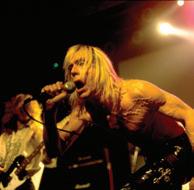
SAVAGE LOVE
61 Getting It Dan Savage tells a reader why cuckolding is a journey, not a destination.
CLASSIFIEDS
ON THE COVER: PHOTO BY CAROLINA SANCHEZ. FOR MORE OF SANCHEZ’S WORK, GO TO CAROFOTOS.COM.
TO CONTACT ANY READER EMPLOYEE, EMAIL: (FIRST INITIAL)(LAST NAME) @CHICAGOREADER.COM
PUBLISHER AND PRESIDENT TRACY BAIM EDITOR IN CHIEF ENRIQUE LIMÓN
MANAGING EDITOR SALEM COLLO-JULIN
PRODUCTION MANAGER KIRK WILLIAMSON
SENIOR GRAPHIC DESIGNER AMBER HUFF
STORY EDITOR SUJAY KUMAR
NEWS EDITOR JIM DALEY
THEATER AND DANCE EDITOR KERRY REID
MUSIC EDITOR PHILIP MONTORO
CULTURE EDITOR: FILM, MEDIA, FOOD & DRINK TARYN ALLEN

CULTURE EDITOR: ART, ARCHITECTURE, BOOKS, LITERARY ARTS KERRY CARDOZA

ASSOCIATE EDITOR AND BRANDED
CONTENT SPECIALIST JAMIE LUDWIG
SENIOR WRITERS LEOR GALIL, DEANNA ISAACS, BEN JORAVSKY, MIKE SULA STAFF WRITERS DEBBIE-MARIE BROWN, KELLY GARCIA, KATIE PROUT
LISTINGS COORDINATOR MICCO CAPORALE
VICE PRESIDENT OF OPERATIONS ANN SCHOLHAMER
DIRECTOR OF DIGITAL JOHN DUNLEVY
DIRECTOR OF MARKETING VIVIAN GONZALEZ MARKETING PROJECT STRATEGIST SHAWNEE DAY NEWSLETTER ASSOCIATE CHASITY COOPER SOCIAL MEDIA MARKETING ASSOCIATE NIESHA DAVIS
DIRECTOR OF CHICAGO INDEPENDENT MEDIA ALLIANCE (CIMA) SAVANNAH HUGUELEY
EXECUTIVE ASSISTANT SANDRA L. KLEIN
SENIOR VICE PRESIDENT OF GROWTH AND STRATEGY AMBER NETTLES VICE PRESIDENT OF SALES AMY MATHENY SALES TEAM VANESSA FLEMING, TIM OGDEN, TED PIEKARZ, WILL ROGERS DIGITAL SALES ASSOCIATE AYANA ROLLING MEDIA SALES ASSOCIATE JILLIAN MUELLER
ADS@CHICAGOREADER.COM
CLASSIFIED-ADS@CHICAGOREADER.COM
1-888-278-9866
A NOTE ON THE COVER
FOR THE COVER , we wanted to capture the spirit of 2022, in our own Reader way. We asked photographer Carolina Sanchez to see if she could find a street musician who was being ignored, which feels like the essence of this year: lots of work, not a lot of respect. Sanchez found the musician, Kaliq Woods, at the corner of State and Randolph, where he “usually plays the clarinet but because of how cold it was his keys froze and got stuck, so he opted into playing the drums instead. He had a man next to him dancing most of the time, who randomly came up while Woods was playing the timbales and sang ‘Merry Christmas’ over and over again.” And with that, we take a break. Our next print issue will come out January 12, 2023. See you then. SALEM COLLO-JULIN
READER (ISSN 1096-6919) IS PUBLISHED BIWEEKLY BY THE READER INSTITUTE FOR COMMUNITY JOURNALISM 2930 S. MICHIGAN, SUITE 102 CHICAGO, IL 60616 312-392-2934, CHICAGOREADER.COM
COPYRIGHT © 2022 CHICAGO READER PERIODICAL POSTAGE PAID AT CHICAGO, IL
2 CHICAGO READER - DECEMBER 22, 2022 ll
60
60
WEEK
Jobs
Adult Services THIS
ADVERTISING 312-392-2970,
CLASSIFIEDS:
NATIONAL ADVERTISING VOICE MEDIA GROUP
VMGADVERTISING.COM JOE LARKIN AND SUE BELAIR DISTRIBUTION CONCERNS distributionissues@chicagoreader.com 312-392-2970
READER INSTITUTE FOR COMMUNITY JOURNALISM, INC. CHAIRPERSON EILEEN RHODES TREASURER REESE MARCUSSON SECRETARY KIM L. HUNT DIRECTORS ALISON CUDDY, DANIEL DEVER, MATT DOUBLEDAY, VANESSA FERNANDEZ, TORRENCE GARDNER, ROBERT REITER, CHRISTINA CRAWFORD STEED



















DECEMBER 22, 2022 - CHICAGO READER 3 Flexible courses to fit your schedule. Childcare & tuition assistance available. ccc.edu/DaleyCTE From the classroom to your new career. Daley College’s Career and Technical Education program gets you to work fast. Find your future in one of our six CTE program offerings: •Child Development •Criminal Justice •Manufacturing CSO.ORG/MOVIES | 312-294-3000 Justin Freer CHICAGO SYMPHONY ORCHESTRA This concert is part of the CSO at the Movies series, which is generously sponsored by Megan and Steve Shebik. WIZARDING WORLD and all related trademarks, characters, names, and indicia are © & ™ Warner Bros. Entertainment Inc. Publishing Rights © JKR. (s22)
Break a leg, kid!
Our recent anniversary UnGala was an affair to remember for myriad reasons. For starters, it brought out Chicago’s finest in droves to the Museum of Contemporary Art for a night of intimate performances, revelry, and reflection, Reader-style.

The night also summoned Reader brass, new and old, including cofounder Bob McCamant, longtime executive editor Michael Lenehan, former editor Alison True, cartoonist Heather McAdams, typesetter and archivist Vera Videnovich, and “the conscience of Chicago journalism,” OG Michael Miner, who looked back and fêted this college dorm experiment, five decades into its existence.
Longing for even more flair, publisher Tracy Baim asked me to prepare a few words to follow remarks from her, Reader Institute for Community Journalism’s chairperson of the board, Eileen Rhodes, and event patron Christie Hefner, who instantly won me over thanks to her oh-so-shagadelic frock.
Through tidal surges in the media industry,
as well as its own vicissitudes, the Reader still stands, I told the packed house, before waxing poetic on what this outlet has meant to so many, myself included. A couple of minutes in, I asked partygoers to raise a glass to what the following half century might hold, and culminated my speech with a heartfelt callback: “the Reader still stands, and it stands strong.”
What followed was a near perfect night.
An undying air of celebration and joy was palpable in the air. Every person (and puppet) in attendance wished nothing but for the Reader to survive and thrive. Even members from other outlets in the local mediascape were in attendance. Folks like Chicago SunTimes executive editor Jennifer Kho, along with ever-fabulous editorial board member Ismael Pérez; and The TRiiBE head of operations David Elutilo, multimedia producer Tonia Hill, and publisher Morgan Elise Johnson, which meant a helluva lot.
I say near perfect, because as I was leaving the venue, I took a spill and ended up falling
down the museum’s iconic staircase. What I thought was a simple party foul, turned into an ambulance ride to the ER and emergency surgery. In stark contrast to the glitzy gala, the weeks that followed have been marred by excruciating pain, helplessness, and self-pity.
Those who know me, know that I lead a very active, independent, and always “on” kind of life. These past few days have turned that notion on its head, and have proven to be a perma-exercise in patience and humility.
At the height of my medical malaise, bosslady Baim texted me a link to one of her favorite songs to “inspire” me, Heather Small’s “Proud”: I step out of the ordinary/I can feel my soul ascending/ I’m on my way, can’t stop me now . . ./What have you done today to make you feel proud?
“I’m afraid my answer is not much,” I replied, browbeaten, after listening to the queer anthem in near tears.

The following day, waiting for the orthopedist at my first post-op appointment, I took
stock of the humbling, nanoscopic triumphs I’ve experienced over the past couple of weeks: making it through my first day sans pain medication, shivers, sweats and all; how I finally managed to brush my teeth over the bathroom sink like a normal person, and not aided by my crafty, bedside Solo cup technique; and how I’ve conquered that trek up and down those nine damn steps to get in and out my apartment, which originally felt akin to climbing Everest. All of a sudden, Tracy’s survival song started playing in my head. Turns out there are many things I should feel proud of. I should be proud that I nary flinched when I got my sutures removed, as I deliberated whether or not this letter would materialize by deadline. I’m proud that during my first grocery store visit since the incident, aided by a motorized shopping cart, I was able to reach high up the refrigerated stands to fetch my favorite yogurt. I’m proud that even in my imperfect existence, I’ve somehow inspired selfless love from those around me to care and watch after me. I’m proud that my mom, over the phone checking up after my visit, did her best to convince me—as only a good, Catholic, Mexican mother could—to come home for the holidays, as even in my nomadic adulthood, I’ve never missed Christmas dinner, and it wouldn’t taste the same without me (though I hate to disappoint her, as chances currently look quite slim).
I’m also proud of the entire Reader team for making it through another year, when many outlets like ours have gone the way of Frosty the Snowman at Steamworks. I’m ungrudgingly proud of the editorial sta for taking stock of the impactful coverage they’ve delved deep in during the past twelve months, highlighted in this special issue, which hopefully holds you up until our next print iteration on January 12.
Yes, Virginia, the Reader still stands. And so does yours truly—albeit a bit wobbly for now.
—Enrique Limón, editor in chief @EnriqueLimon
4 CHICAGO READER - DECEMBER 22, 2022 ll
EDITOR’S NOTE
A toast to the Reader GLITTERGUTS














DECEMBER 22, 2022 - CHICAGO READER 5
LGBTQ+ SPACES
Your guide to outside
Thirteen of Chicago’s new queer and/or BIPOC recurring events
 By DEBBIE-MARIE BROWN
By DEBBIE-MARIE BROWN
One of my favorite parts of being a young, Black, twentysomething Chicago gay is that, in 2022, the cis-white entrapment of Boystown is no longer my only option if I want to make sure my evening outing is especially queer. The city seems to have more and more young adults of di erent ethnic backgrounds creating hip, distinct, Black- and Brown-centered nightlife in spaces or venues that are otherwise predominantly white. As someone who is the self-appointed Prince of Nightlife and Being Outside in Chicago, here’s a list of 13 events that started in 2022 that will hype your night and soothe your soul.
Parties Boots
Organizer: Abijheet Rane and Kirk
Boots is a DIY dance party that started in March in an attempt to bring back the edge, messiness, and experimental nature of nightlife that were lost during the pandemic, Rane said. Boots parties occur for one night at unconventional, discreet locations such as Chinese restaurants, art spaces, and
rooftops, and have featured artists such as Baby Cakes, Cae Monae, and Girls That. Their most recent event had more than 500 people in attendance. “People just want a little more excitement with going out . . . the occasional, like, ‘I don’t know what I’m stepping into’ . . . makes [Boots] exciting.” Their Instagram handle is @boots.party and their next event is December 31 at Goose Island .
Eden
Organizer: Jenniferfauxxpez, aka Ellesandra
Eden bills itself as a sapphic space: a DIY, sexy, lesbian party space meant to break the stereotype that lesbians are only U-Haul-driving, slow-dancing homebodies who don’t like to go out. Eden facilitates the opposite. Collective pleasure, no inhibition: we leave it all on the dance floor. Eden is a party for friends, lovers, and crushes. The founder and producer, Reggaeton DJ Jenniferfauxxpez, told the Reader, “I’ll be at Smartbar any time of the day . . . But sometimes, I wanna listen to what I love. And there was no spaces that I found that I could be gay as fuck and listen to reggaeton.” Past DJs have also included Columbian DJ Ynfynyt Scroll and Vitigrrl, the resident DJ of SloMo. #SeeYouAtEden
Fortune
Organizers: DJ Blesstonio, DJ AYEEYO, DJ Zeetus Lapetus, and Jaxx Masada
Fortune is a monthly, queer dance party that debuted as a residency at the Hideout in August. Despite being held on Wednesdays, it consistently reached capacity at the 150-person venue. It features the same team of eclectic DJs each time: the pop-culture-inspired Somali DJ AYEEYO, the hype Boricua DJ Blesstonio, and the intergalactic funk DJ Zeetus Lapetus. The team will announce its new residency location in 2023. Their Instagram handle is @fortunedanceparty, and their next event is December 30 at Lincoln Hall
Hoochie Hotspot
Organizers: Lynzo the Heartthrob and Fierce
Hoochie Hotspot is a Black-sex-worker-run event space featuring strippers, drag performers, and prizes. The event came out of a desire to create more specifically Black and queer-friendly nightlife spaces that would also center sex workers’ safety. Their first event premiered on Juneteenth. Hoochie Hotspot includes outdoor and indoor multisensory spaces. It has featured casual fire-
places with vegetable kabobs for guests while a DJ plays on the back porch and a stripper gives a performance in the backyard. Other events have included oil wrestling for a Telfar bag and a costume contest. The event always includes themed intimate activities that help facilitate genuine connection-building, and attendees are often those who may not frequent the club circuit. The Hotspot averages around 100 people per event. Their Instagram handle is @hoochiehotspot
Strapped
Organizers: Irregular Girl and Siichele
Strapped is a sex-positive, alternative dyke party night every first Friday at Berlin that regularly features drag and burlesque performers. The event caters to trans-identified folks and often has a large turnout of transmasculine and transfeminine lesbians. It celebrated its one-year anniversary in September. “It’s, like, unhinged and feral. Very fun,” Siichele said. Attendees start arriving at 10 PM and are still at the bar until it closes at 4 AM. Strapped averages 600 people per event. The next event is January 6 at 10 PM .
Drag
Queeriod Drag Show
Organizers: Lúc Ami and Male Spice
Queeriod is an open-stage drag show that happens every Sunday at Charlie’s Chicago from 5 PM to 7 PM. It celebrated its one-year anniversary in July. Most drag shows happen late at night, but the early-evening show caters to newcomers, those who don’t want to go out late, and people who might have their senses oversaturated being at a nightclub. Ami started Queeriod during the pandemic upon realizing that emerging drag performers who only ever performed online needed a noncompetitive, supportive space to perform in person. The event caters to people of all ex-
6 CHICAGO READER - DECEMBER 22, 2022 ll
CITY LIFE
Strapped attendees at a recent party at Berlin SECRET QUEEN
perience levels interested in building up their stage presence in a supportive environment. Their Instagram handle is @Queerioddragshow ; you can stream live shows on twitch.tv/ alienkingluc
Dim Sum Drag
Organizers: Abijheet Rane, Luv Ami Stoole, and Aunti Chen
Dim Sum Drag is a monthly, all-Asian drag brunch that happens at Furama, a dim sum restaurant in Uptown. It celebrated its oneyear anniversary in June. The restaurant has a main hall that includes a jade-green floor and a stage with a red backdrop and seats 250 people. Attendees can enjoy a dim sum bu et as well as a personal, up-close drag performance. About half of the attendees are regulars, and half are fi rst-timers. Show themes have included KPOP and Crazy Rich Asians . Their Instagram handle is @dimsumanddrag

Boyz 2 Men
Organizers: Luv Ami-Stoole and Lúc Ami
Boyz 2 Men is a drag-king-themed game show that happens every other month at Berlin Nightclub on Monday nights from 10 PM to 2 AM. It celebrated its one-year anniversary on December 15. In its original format, the producers pair a more seasoned king with a newer king, and two teams of two compete against one another in silly games. The night ends with a duet performance, and the audience votes for the winner. Inspired by Queeriod, Ami-Stoole made Boyz 2 Men a welcoming and encouraging space for new
performers. The audience usually features many drag kings and queens as well as transmasculine people who don’t do drag.

Open mikes
Fruit Salad
Organizers: Rain Thomas and Whitney LaMora
Fruit salad is a monthly open mike that centers Chicago’s LGBTQ community. It currently takes place at the stylish, 1970s-themed lesbian bar Dorothy, which sports deep velvet couches, soft lighting, a conversation pit, themed cocktails, and more. Fruit Salad celebrated its one-year anniversary in October and has been hosted at its Ukrainian Village location since February. Each month, ten slots are available for the open mike, and each event features a queer artist who performs at the end of the night. Past open mike performances have included singer-songwriters, comedians, poets, drag storytellers, and DJs. At their most recent open mike, 120 tickets sold out within 15 minutes of being released. Their Instagram handle is @fruitsaladchicago
Ari Gato’s Anything Goes Karaoke

Organizer: Ariana L. Gato and Roscoe’s Tavern
Ari Gato’s Anything Goes Karaoke is a Monday-night open mike hosted by the aforementioned drag queen at Roscoe’s Tavern from 9 PM to 1 AM. It debuted in early November. Roscoe’s hosted a di erent karaoke show for










over 20 years, then tapped Gato post-pandemic to revive it, “with a twist.” The drag queen hosts while attendees take turns singing in the supportive, comedic environment Gato creates with her commentary and backup vocals. Gato also provides an array of costumes and accessories for attendees to wear on stage.
Afro Joe’s First










Fridays
Organizer: Shaundric Mann
Afro Joe’s is a Black-owned coffee shop on the south side, and First Fridays, a monthly open mike hosted there, celebrated its one-year anniversary in August. Mann, the organizer, started as a customer and then became a barista. Mann created the open mike for people from the south or west sides of Chicago who didn’t want to always travel north for open mikes. He started the event “to spotlight that the south [side] had something to say when it comes to arts and culture that’s di erent.” Afro Joes serves a variety of artisanal beverages and food. Open mike attendees who purchase a VIP ticket get a guaranteed seat and meal. Featured artists have included F.A.B.L.E., J Bambii, and ‘Kechi. The open mike’s Instagram handle is @fi rstfridaysopenmic .
Music/art shows










Real Ones Live Shows

Organizers: Ben Moskow, Michael Magitman, Tyrel Tchinchinian, and Sydni Dorsey
Real Ones is a Chicago-based music platform

that started as a podcast in August. It has evolved into a multi-armed creative hub featuring artist interviews, curated playlists, and live events that uplift Chicago’s marginalized communities. Real Ones held its fi rst live artist showcase in August. At each threehour show, four or five artists with adjacent but distinct sounds deliver 30-minute sets. Real Ones’s most recent show was at Cole’s Bar in December. Previous themes have included Rage Cage with rage-inspired music (SheGO Turbo, cam, and JVNBVG) and The Igloo with cozy R&B (Sherren Olivia, Sydney August, Inea’J, and S-O-S). Their Instagram handle is @realonesshow

The Black Gallery








Organizer: Enama (pronounced uh-nah-muh)

























The Black Gallery is an annual art exhibition, gallery walk, and fashion show on Black Friday that features Black and African-owned businesses, brands, designers, stylists, and models to encourage the public to invest their money more intentionally in local Black creators and entrepreneurs. “It is an opportunity for people to invest in the community and buy Black on Black Friday,” Enama said. It also includes the opportunity to network and connect with di erent types of talented artists. The Black Gallery held its second annual event in November at the Mandrake Park Fieldhouse. To get involved, donate, or sponsor future exhibitions, contact bookingenama@gmail.com or follow @theblackgallery2021 on Instagram. v

DECEMBER 22, 2022 - CHICAGO READER 7 WRAP-UP YOUR HOLIDAY ENTER THE SWEEPSTAKES ENTER FOR A CHANCE TO WIN ILLINOISLOTTERY.COM/WRAPUPSWEEPS $ 5,000 ENTER TODAY ILLINOISLOTTERY.COM/WRAPUPSWEEPS Gi Smart. O er valid from 10/17/22 - 12/31/22. See O icial Rules, which govern, for details at Illinoislottery.com CITY LIFE
@debbiemarieb_
The chef underground ain’t dead yet
Pop-ups and the general alternative food economy suffered some slowdowns in 2022, but they were still a lot more exciting than their brick-and-mortar counterparts.
By MIKE SULA
Idiscovered a tangle of disarticulated entrails in my backyard at dawn one Saturday late last summer: a tiny squiggle of digestive tract and an alien-like blue, bulbous, kidney-bean-sized blob. My first guess was an extraterrestrial encounter gone wrong, until I spotted a tiny paw waving up from the grass that Google suggested was rat-like or possibly squirrelly in origin.
Rodents rule the alleys and postage-stamp backyard gardens of Albany Park. At least that was the case on my block up until last winter
when a pair of sharp-shinned hawks took up residence at the top of a towering oak on the parkway.
In late February they claimed their turf with a shower of pigeon feathers and bloody bones on my front steps, and from then until the end of the summer, you could occasionally spot their mangled leftovers around the neighborhood. When they weren’t terrorizing the local fauna, they perched on the highest branches of the tree and shrieked at each other all day long. I loved them.
It wasn’t just their occasional crime scenes that allowed me to embody the forensic pathologist I was always supposed to be; they provided a reminder that occasionally something uncommon and wild invades the gray, human-enabled Chicago ecosystem, scattering the house sparrows and reminding the squirrels not to get soft.
Usually when I stopped to squint up at them this summer, I was wrestling with my laptop, trying to wrench out some words to describe some analogous incursion into the city’s
(human) foodscape.
Much like last year (and the year before) I continued to look to the underground and gray market food economy as the place to spot the most interesting, creative, and groundbreaking chefs and foodlums in the city.





Even as the masks continued to come off, there’d been no great sigh of relief in the hospitality industry in 2022. The traditional brick-and-mortar restaurant economy did not come roaring back amid Omicron. With inflation and staffing shortages, operators struggled with their own kind of long COVID, and for many the prolonged struggle proved to be too much. Brick-and-mortar closings kept pace with notable openings.
And yet the comeback was enough that you could see the e ect it had on the underground. Plenty of cooks, bartenders, servers, and chefs made their way back to brick-and-mortars or even jobs in other industries, as their side hustles proved less sustainable as the world reverted back to something resembling what it once was, but nevertheless will never be again.
I’d been hearing all year long from folks who flourished in the alt-economy about how changes in Instagram’s algorithm had made things di cult for the host of new food businesses I’d been writing about since the beginning of the pandemic. I saw it myself as social media engagement with our Monday Night Foodball pop-up promos dropped off precipitously some weeks.
But that didn’t mean interest dropped o . Some brick-and-mortars continued to be in-
8 CHICAGO READER - DECEMBER 22, 2022 ll FOOD & DRINK
Kitchen crews at various Monday Night Foodball pop-ups, hosted at the Kedzie Inn COURTESY MIKE SULA
ALT-FOOD
Find more one-of-a-kind Chicago food and drink content at chicagoreader.com/food.
FOOD & DRINK
cubators for young chefs with big ideas. Last Monday night alone, the Long Room hosted a barbecue pop-up; Ludlow Liquors featured a new chef in town doing Filipino fine dining; one of Honey Butter Fried Chicken’s line cooks took over that kitchen to do Jamaican food; while the Kedzie Inn hosted the year’s 38th Monday Night Foodball, the Reader’s weekly chef pop-up that I’ve been hyping since August 2021. This one featured Won Kim previewing the next iteration of Kimski, Bridgeport’s sixand-a-half-year-old Korean-Polish mash-up which itself has become a training ground for young chefs eager to break out and do their own thing.
Many Kimski pop-up vets have made their way to Irving Park to throw down at a Foodball this year, including Thattu, who’s opening its brick-and-mortar at Guild Row in 2023; Zeitlin’s Delicatessen, which was featured earlier this week at the 39th and final MNF of 2022; He er BBQ, which was our 36th; Mom’s Chicago (our seventh); Gemma Foods (31st); and more.

The best things I ate this year I ate at these pop-ups: like, in no particular order, Angelina Bastidas’s shrimp mofongo; Nemanja Milunovic’s pizza burek; the salmon ochazuke by SuperHai; the Philly masala cheesesteak from Dhuann BBQ Company; Eric May’s vegan mushroom Italian beef; Flavor Supreme and Lolo Agogo’s Big Meatball; the smoked brisket banh mi from Umamicue; D’s Roti’s curry chicken roti; Ramen Lord’s Aburasoba; Thommy’s Toddy Shop’s Kerala fried chicken; Lebanese and Armenian stu ed grape leaves from Mary Eder-McClure and Kat Stuehrk Talo; lechon tacos from Pig & Fire; Ricky Hanft’s beef heart sauerbraten; Vargo Brother Ferments’ “Portillo’s” chopped salad; Gemma Foods’s smoked potato crescenza culurgiones with lemon-sage cream; Better Boy’s celery root mash and Tasting India’s spiced cornbread from the Umamicue Friendsgiving; Heffer BBQ’s smoked chicken tinga tostada; and pretty much anything on the menu from the seven-chef Foodball organized by Waroeng’s Tasya Hardono, who now runs not just the midwest’s only Indonesian grocery store
but the region’s only Indonesian art gallery/ boutique, Legenda.


But also the most fun I’ve had this year has been running food, clearing tables, and playing host at these pop-ups. They’re way more fun than sitting down at a table and passively observing service, atmosphere, and food like some kind of, I dunno, restaurant critic. The concept of service and hospitality loses its abstraction and becomes a thing that is super satisfying to engage in. It’s a pleasure to defuse the occasional tension or resolve the odd mishap with grace and strategy rather than confrontation and watch someone’s attitude go from annoyance or aggravation to acceptance and appreciation.
My sharp-shinned hawks took o sometime in August and haven’t been back (yet), which was a reminder that everything changes. Sure, Shin Thompson moved to LA, Oscar Singer moved to New York, and the Hot Dog Box closed its Portage park brick-and-mortar, but it’s still alive in the popup world—and so are most of the chefs we’ve hosted at Monday Night Foodball.
Despite some setbacks, the pop-up scene still looks a lot more vibrant and promising than its brick-and-mortar counterpart. I’ve heard from so many chefs who’ve launched or expanded their own nonperishable product lines, like Jasmine Sheth’s spice blends or Vargo Brother’s pickles. And I know plenty who are actively working toward settling into their own brick-and-mortars, which I can’t tell you about quite yet, but I will when the time comes.
So it isn’t dead at all. Take Nemanja Milunovic, formerly of Balkan Kiosk, who headlined the first Foodball of 2022. He had to take a job at Aba, which kept him out of the pop-up game for the rest of the year. But I’m thrilled to say he’ll be back in early 2023 when he kicks o the next season of Monday Night Foodball at its new location, which I’ll announce, along with a brand new schedule of chefs, old and new, early in the new year. Meantime, I’m gonna keep listening for the hawks. v

DECEMBER 22, 2022 - CHICAGO READER 9
@MikeSula
MICCO CAPORALE
COMMENTARY
ON POLITICS
Baby steps
The good news about 2022 is that it could have been worse.
 By BEN JORAVSKY
By BEN JORAVSKY
It’s that time of the season where I measure a year’s worth of political progress by comparing steps forwards and steps back, in the hope that overall we’ve made progress. I could fill this issue with many examples of elections, budgets, and spending plans from 2022. But I’ll settle on a few items. Starting with some good news . . .
The CTA’s Red Line Extension project. I’m happy to say that the year ended with Mayor Lori Lightfoot doing something right. That’s right as in correct—not as in ideology. I’ve been critical of Lightfoot for much of 2022. But on the Red Line, I have to say thank you, Madame Mayor (and thank you City Council for overwhelmingly approving her proposal). You did what your predecessors— Mayors Emanuel and Daley—said they wanted to do, but never got around to actually doing.
That’s extending the Red Line south from where it currently stops at 95th to 130th Street, and building four new stops—at 103rd, 111th, Michigan Avenue, and near Altgeld
Gardens.
The mayor and council did it by committing about $959 million in Tax Increment Financing dollars (the feds will pick up most of the rest of the cost). So finally some worthwhile economic development from the TIF scam.
Frankly, I don’t think those two aforementioned mayoral predecessors wanted to extend the Red Line, no matter how many times they said they did. Frankly, I think those predecessors saw that project as a waste of money. So they did just about every other CTA project. They built the Pink Line. They repaired the Brown Line. They fixed up the Red Line. They built the flyover at Belmont. They rebuilt the 95th Street station, but no Red Line extension.
The extended Red Line will bring service to Washington Heights and Roseland, communities that have su ered for investment under Daley and Emanuel.
As far as I can tell, the governing principle of Daley and Emanuel was to mostly spend TIF money in areas that were already booming,
thus gentrifying already gentrifying communities, while leaving lower-income communities, like Washington Heights and Roseland, to fend for themselves. We all know what happened.
Over the last 20 years, Chicago’s Black population has drastically fallen—including in Washington Heights and Roseland. It was demographers like Alden Loury, now an editor at WBEZ, who brought this to my attention. I remember asking Loury why Chicago’s powers-that-be did not sound the alarm about the outward Black migration.
To which he said something like, “Ben, I don’t think they saw it as a problem.” Truer words were never spoken.
I hope extending the Red Line sparks renewal on the far south side. So, one giant step forward. On the other hand . . .
The only no vote in the council was cast by Alderperson Pat Dowell on the grounds that her near south-side ward was largely paying the city’s share of the project.
Or as she put it at a city council hearing, “Because these benefits are citywide, everyone should have skin in the game of paying for this project. This has to include the entire city.”
That’s inaccurate. TIF is a citywide tax hike. The Red Line TIF district will raise property taxes on every Chicago property—not just property in Dowell’s ward.
To say otherwise is to feed the notion that somehow 3rd Ward residents will, as the SunTimes put it, “bear the burden” of the extension’s costs.
Again, not true. Again, every property owner’s taxes will rise for this project. Again, a TIF is a citywide tax hike. Whether she intended to or not, Alderperson Dowell contributed to Chicago’s ignorance of TIFs.
So it’s like a quarter step back. I’ll settle for that.
Now onto the national front. Democrats defeated MAGA attempts to take control of the Senate—even picked up a seat. So that’s a big step forward—if you believe in democracy as opposed to Trumpocracy.
And yet, last week House and Senate Democrats joined their Republican counterparts to add $45 billion to the defense bill that President Biden had already requested.
Let me repeat that to make sure there is no confusion about what Democrats did. Next year’s entire defense budget is not $45
billion—it will be about $858 billion. No, the $45 billion is what Congress is adding to what Biden wanted to spend. Like $851 billion on bombs and guns was not enough!
That $45 billion is obviously a lot more than the $3.6 billion it will cost to extend the Red Line. They could probably extend the Red Line to Carbondale for that kind of cash.
Now, I obsessively followed the 2022 elections in many states (not just Illinois). And I don’t recall any Democrats running on platforms of upping the defense budget by $45 billion.
Never heard one of them say—we have to hold onto the House and the Senate so we can spend even more money on weaponry than what President Biden wanted to spend. As opposed to spending it on transit, schools, health care, or any of the dozens of programs that people in this country really need.
Quite the contrary: I know of activists who worked their tails o for Democrats who they hoped would cut defense.
This headline from the Sunday, December 18, New York Times print version said it all: “Bonanza for Arms Makers As Military Budget Surges.” I don’t recall one Democratic candidate or voter saying, “We need a bonanza for arms makers!” Certainly, I didn’t read that refrain in any of the hundreds of solicitations I received all year long from Democratic candidates.
As always, Democrats are their own worst enemies. So one step back.
Finally, on the state level . . . Democrats beat MAGA in every statewide race, including governor and supreme court. And all those Republican candidates managed to concede defeat without crying that the election was stolen and storming the state capitol. Call that a step forward.
As you can see, I’m really trying to look on the bright side, folks. Hope 2023 is one giant step forward for all of you. v
@bennyjshow
10 CHICAGO READER - DECEMBER 22, 2022
To look on the bright side, we’ll have to leave behind the fog of 2022. SEBASTIAN KURPIEL/UNSPLASH
Ev’ry day, Moses rises with the morning sun. Plants collect their dew. Slowly the horizon breathes blood orange to blue.
The mountaintop stands above all life in the land of promise. Although water is the one who holds us all together.
Ev’ry day, Moses must protect our gift from the Master, who thinks he’s clever.
By Jan Menafee
Who erects the great white dam in search for “better”.
But the dam blocks us from where we’re meant to go. So Moses hums and beats our drums. Then she proclaims, “Let my people flow.”
The dam dissolves as We flood the land of promise. Moses follows us to, and through, our paradise. The sun shines before death.
Jan Menafee is an artist, educator and entrepreneur based in Chicago and Washington D.C. He loves to read, cook for friends, and co-host the Real Ballers Read Podcast. His first poetry chapbook, Watering Whole, is out now.
Poem curated by Justus Pugh. Justus is a poet, writer, and technologist born and raised on the South side of Chicago. As an artist, his work is guided by the idea that our imagination is our ancestor’s wildest dreams, inherited. And this imagination comes through writing his “Afrotranscendental” poetry, writing culinary fiction with Village X Magazine, and, now and today, storytelling.
A biweekly series curated by the Chicago Reader and sponsored by the Poetry Foundation.





Hours
Wednesday, Friday, and Saturday: 11:00 AM–4:00 PM Thursday: 11:00 AM–8:00 PM

Note: The Poetry Foundation building will be closed to the public from Friday, December 23, 2022 and will reopen on Wednesday, January 4, 2023.

Diana Solís: Encuentros
Photographs of Chicago Poetry Communities, 1978–1994
An exhibition of photographs and ephemera exploring this unique moment in Chicago’s literary history. Open until January 14, 2023
Learn more at PoetryFoundation.org
DECEMBER 22, 2022 - CHICAGO READER 11
Myth of Moses
Free Programming from the Poetry Foundation!
COMMENTARY
ON CULTURE
Fusion and firearms
Are these year-end developments breakthroughs or bluster?
By DEANNA ISAACS
The best we can say about 2022? It’s been transitional. If we’re lucky, the shift will be to something better. In the meantime, the war in Ukraine drags on. Predictably, unconscionably, we’ve become inured to it. Inflation rages at a pace new to most of us. The experts pushing and pulling the levers on the economy apparently never do their own grocery shopping. Racism is still a plague, as is COVID, with its alphabet soup of mutations. It has struck devastating blows to cultural and urban life. Guns are now the major cause of death for American kids, and greenhouse gases continue to ramp up global warming. Whew. Every story is important, but looking over those I wrote this year, it’s not hard to spot the potentially most consequential subject. It’s the last one on this quagmire of a list: climate change. In one of the final stories of the year, I talked with author and former Reader sta er Peter Friederici about his book,
Beyond Climate Breakdown , recently published by MIT Press. It was great to reconnect with him, but what he had to say was sobering: “We can have a climate future that’s really bad . . . or less bad.” We’re already at the point where the only choice we have is “How bad do we let it get?”
A grim peek at a future we’ve already set in motion.
But then, something amazing happened. Within days of that interview appearing in the Reader , the U.S. Department of Energy announced a breakthrough at Lawrence Livermore National Laboratory. On December 5, after decades of trying, scientists there had succeeded at “fusion ignition.” They’d managed to get more energy out of a fusion experiment (smashing two nuclei together until they unite, releasing energy) than they’d had to use to make the fusion happen. “This first-of-itskind feat . . . will provide invaluable insights
into the prospects of clean fusion energy,” the announcement said.
Eureka! The process sounded orgasmic, as did some of the comments included from politicians. “This astonishing scientific advance puts us on the precipice of a future no longer reliant on fossil fuels,” Senate majority leader Chuck Schumer (D-NY) said, before adding that it’ll take a lot more cutting-edge work to get there.
So, is our existential climate problem suddenly solved? Human ingenuity (let the trumpets roar) sweeping in like magic to wipe away the problem previous human ingenuity had created? Who wouldn’t rejoice at that?
I called Friederici again. “It probably does suggest great prospects for the future—the distant future,” he said. How distant? “Hard to say; there are going to be big challenges with scaling up. And we don’t have the luxury of waiting. From a climate perspective, the time for action is right now. The work we do today affects the future way more than what we might do in 20 years. It’s a matter of trajectory and tipping points—the longer that we don’t reduce emissions, the more the climate is altered in the future.”
He added, “There’s a tendency to look at climate change and say, ‘OK, it’s a problem, what’s the silver bullet?’ But there is no silver bullet. It’s a new reality that demands a multitude of responses. Maybe fusion is part of the response in the future, but it’s not a silver bullet.”
Speaking of bullets, after the Highland Park Fourth of July shooting, one of the experts TV news turned to for comment was Phil Andrew—a Chicago-area native who’s been working on the gun problem since he was the victim of a mass shooter here in 1988. He told me in July that we need to ban assault weapons, make sure that guns are kept away from young people and dangerous people, and enact and strengthen red flag laws.
This month, at the Bilandic Building, an Illinois house judiciary committee held a series of hearings on a bill intended to do all that. As sponsor Bob Morgan, a Democrat representing the 58th District, explained at one of those hearings last Thursday, House Bill 5855 (the Protect Illinois Communities Act) will ban the sale and manufacture of assault weapons, high-capacity magazines, and
.50-caliber rifles, while requiring registration for those who already own such weapons. It’ll also crack down on gun tra cking from other states; raise the eligibility age for a gun owner’s permit to 21 (18-year-olds can now qualify with parental approval); and allow one-year terms for “red flag” weapon confiscation (now limited to six months).
The committee had a live audience of only about 30 people. Supporters of 5855 included a group of red-T-shirted members of Moms Demand Action. Across an aisle from them, a smaller ad hoc clutch of 5855 opponents included Abraham Avalos of Waukegan, in a black-and-yellow Illinois Gun Owners Together shirt. Avalos testified that he was present at the Highland Park parade shooting but opposes the ban because there will always be “people who obey laws and people who don’t.” That, he said, “is why I carry.”
State representative Tony McCombie (71st District Republican), speaking remotely, told the committee that “if this passes, it’s going to be ineffective and unconstitutional,” and will “take guns out of the hands of law-abiding gun owners like myself.” And Live Free Illinois organizer Artinese Myrick said her group is “in support of an assault weapons ban,” but opposes “any legislation that will further criminalize Black and Brown communities,” and is concerned that with certain aspects of this bill, more law-abiding citizens may be swept up in the system.
All of the gun owners talked about the need to defend themselves; none explained why they’d need an assault weapon to do that.
In four hours of testimony, the committee also heard supportive research and firsthand accounts from officials, workers in the field, and survivors like Everytown Survivor Network members Maria Pike and Marsha Lee. Both lost sons in fatal shootings. “It’s out of control; we have to make change,” Lee told them.
That left me wondering: if we can’t muster the political will to outlaw weapons whose only purpose is to kill as many people as possible as quickly as possible, what are the chances we’ll make the harder changes necessary to escape the worst of a killer climate breakdown? v

12 CHICAGO READER - DECEMBER 22, 2022
@DeannaIsaacs
State representative Justin Slaughter (le ) and Abraham Avalos, Illinois house judiciary committee meeting, Bilandic Building, December 15, 2022 DEANNA ISAACS
ChicagoFamilyBikingmakesbikingfunandsaferforallages

ChicagoFamilyBikingisagrassrootscoalitionofparents,educators,andcommunityorganizerswho lovebiking.Thegroupstartedin2015asanonlineforumandsoonbeganhostingChicago’sKidical Massrides,wherefamiliescouldcomeandconnectwitheachotherwhilebikingthroughtheir neighborhoods.Theirgrowthacceleratedduringthe pandemicasmoreChicagoansbecame interestedinbiking,andcommunityridesgavefamiliesrespitefromprolongedisolationthrough freeoutdooractivitiessuitableforallagesandexperiencelevels.AsfounderRebeccaResmansays, “Bikingisoneofthosethingsthatonceyoutryit,you'rehooked.”

In2022,ChicagoFamilyBikinghostedeventsin11neighborhoodsacrossChicago,including Bridgeport, HumboldtPark,andPortagePark,aswellasinsuburbanBerwyn,Evanston,andElgin. Eachoneisopentothepublicandfreetoattend.“Thankstoourincrediblevolunteers,wehosted over75eventsin2022,mostlyconsistingoffamily-friendlybikeridesandbikeobstaclecourses.In 2023,wehopetobuildonthatsuccess,bringingmorecommunitiesintothefold,”Resmansays.To thatend,ChicagoFamilyBikingwillrecruitnewrideorganizersthroughoutthewinterandearly spring,andinterestedpartiescansignupontheirwebsite.“Fromthere,ourorganizationprovides training,marketing,andcommunitysupporttohelpthembesuccessful,”Resmansays.

DECEMBER 22, 2022 - CHICAGO READER 13
PaidSponsoredContent CoveragefundedbyTheDarrellR.WindleCharitableFundandPoloInn Readtherestofthisstoryonlineatchicagoreader.com/transportationseries 1)Taketheregulartrafficlaneifthebikelaneisobstructedbyiceandsnow.It’ssaferandit’syourlegalright! 2)Ifyouridewithachildinabikeseat,makesuretodressthemwarmerthanyourself.Sincetheirbodiesaren’t moving,theywillgetmuchcolderthanyou. ChicagoFamilyBikingalsoworkstoimprovebikingconditionsforChicagoansgoingforwardthroughadvocating forbetterbikinginfrastructure,traffic-calmingmeasures,andpracticalandeffectivetoolstomakestreetssafer forbicyclists,suchasholdingdriversaccountablefordangerousbehaviorslikeblockingbikelanes. Inadditiontotheirregularrides,ChicagoFamilyBikinghostsfamily-friendlyday
tripsandtheannualChicagoFamilyBikeFest.Theyalsoprovideonlineresource guides, maps,andeducationaltoolsforparentslookingtoridesafelywiththeir childrenwhileteachingthemhowtorideontheirown.Parentsarealsowelcome toaskquestionsontheiractiveFacebook.Resmansaysthatwiththelongwinter ahead,they’vebeengettinglotsofquestionsaboutcold-weatherriding,andshe sharedtwotipsforpeoplelookingtobikewithkids:
To act justly, to love mercy
It’s time to truly act on criminal justice reform.
By ANTHONY EHLERS
Oregon Governor Kate Brown has granted more commutations and pardons than all of that state’s governors in the last 50 years combined.
Brown’s effort raises a question here in Illinois: why isn’t Governor J.B. Pritzker using his clemency powers more e ectively and expansively? He has stated repeatedly that he’s in favor of criminal justice reform. If that’s truly the case, it’s time for Pritzker to address the historical harms and injustices associated with mass incarceration. It’s time that the state of Illinois reflects the governor’s stated values and beliefs.
Clemency is an umbrella term that refers to the ability of governors to grant mercy to incarcerated people. Clemency includes par-
dons, which fully forgive someone who has committed a crime; commutations, which reduce prison sentences, often resulting in early release; reprieves, which pause punishment; and eliminating court-related fines and fees.
Historically, presidents and governors regularly used clemency for things like wrongful convictions, witness recantation, flawed evidence, police misconduct, and a prisoner’s exceptional rehabilitation. Alexander Hamilton argued in the Federalist Papers that clemency is a necessary check on a justice system that levels excessive punishment. Without clemency, he argued, “justice would wear a countenance too sanguinary and cruel.”
There are many reasons Pritzker should be granting clemency. The injustices of mass incarceration, the tough-on-crime deterrence
myth, racism, laws like Truth in Sentencing, and life without the possibility of parole (also called death by incarceration, or DBI), are inextricably intertwined. The victims of mass incarceration are su ering from overly punitive laws and dying in prison despite yearslong self-rehabilitation.
Mass incarceration is the civil rights issue of our era, and we cannot eradicate mass incarceration without addressing long sentences. Clemency is a tool for criminal justice reform, and an act of grace, exercising the belief that compassionate mercy and ensuring public safety are not mutually exclusive.
“The state of Illinois, like too many states in our union, is experiencing an unacknowledged and little known humanitarian crisis where thousands of people are over-sentenced to
death by incarceration,” Joseph Dole, policy director of Parole Illinois, wrote in 2021.
“These DBI sentences destroy thousands of lives for no legitimate penological purpose, are a historical anomaly in Illinois and around the world, and are completely unnecessary for public safety.”
While Illinois had the death penalty until 2011, it was only handed out about a dozen times a year statewide. Even at the height of the death penalty in Illinois, when many innocent people sat awaiting execution, Death Row never held more than 200 people.
Today, Illinois sentences hundreds of people to death by incarceration every year! This transition from viewing a dozen people per year as irredeemable to hundreds was not only unjustified, but has resulted in the steady growth of Illinois’s “slow Death Row.”
It’s important to note that juveniles and young adults are more amenable to rehabilitation and less culpable for crimes than fully mature adults. In 2019, the Illinois Supreme Court ruled that sentences of more than 40 years were a de facto life sentence for people younger than 18.

Maintaining sentences that ignore those facts and sentencing juveniles and young adults to die in prison is inhumane.
We arrived at this humanitarian crisis via emotional hyperbole, racism, political gamesmanship, the abandonment of rehabilitation as an ideal, and the mass demonization and dehumanization of “criminals.”
I’ve often described the Illinois Department of Corrections (IDOC) as a waste-management system. Society views us as garbage, and so opportunities for rehabilitation are nonexistent. In 1994, Congress banned prisoners from Pell grant eligibility amid a change in the social milieu from favoring rehabilitation to demanding punitiveness. IDOC largely abandoned college and vocational programs in the 1990s, and turned to warehousing people in increasingly inhumane conditions.
Despite that, many prisoners took it upon themselves to self-rehabilitate. Many do so even though they have no avenue of release other than executive clemency, which has been a nearly nonexistent remedy for decades.
Today, society and the IDOC have acknowl-
14 CHICAGO READER - DECEMBER 22, 2022
ON PRISONS
WELSEY TINGEY VIA UNSPLASH
COMMENTARY
edged that abandoning rehabilitation was a mistake. This summer, Congress reinstated Pell grant eligibility for people in prison, and vocational and college programs are flooding back into IDOC.


Unfortunately, the people who for decades overcame the IDOC’s hindrances to rehabilitation, and spent untold time, money, and e ort to rehabilitate themselves, will see little benefit from their herculean e orts.

That’s because most of the legislation being passed to increase good time for rehabilitation efforts is not retroactive, and many of these same prisoners have a DBI sentence. The only way their e orts to self-rehabilitate can be rewarded is through an act of clemency by the governor.





It is an incredible injustice to acknowledge it was a mistake to abandon the goal of rehabilitation, while simultaneously denying any opportunity for early release for all those in prison who rehabilitated themselves despite all of the hindrances put in their way by prison administration and IDOC at large.
Illinois has thus far failed to heed the true message of criminal justice reform. Even after
Illinois did away with the death penalty, its criminal justice system is still as lethal and unjust as it ever was. Thousands of people, a disproportionate number of whom are Black, and many who are innocent, are sentenced to su er for decades in prison until they die there.
Neither judges or legislators take into account a person’s capacity to change, to grow, to be rehabilitated. Deterrence here literally inflicts more punishment than is justifiable. It’s done in the false hope that the punishment will be so terrible, that it will scare others out of committing that crime. We know that doesn’t work! Increasing the pain of one individual to try to coerce the behavior of another person is morally repugnant. Nonetheless, we currently have thousands of people in Illinois prisons su ering from this injustice.
The Sentencing Project notes, “the racial and ethnic disparities plague the entire criminal justice system from arrest to conviction, and is even more profound among those serving life sentences.” Illinois has been one of the worst o enders in that regard.
While Black people make up less than 15
percent of Illinoisans, they were 54 percent of the Illinois prison population as of June. Nationally, nearly half of people serving life without parole (LWOP) and de facto life sentences are Black.
Pritzker needs to exercise his executive clemency powers to grant blanket clemency to those serving a sentence of DBI (LWOP or de facto life), and anyone sentenced under the provisions of the Truth in Sentencing Act.
I would ask the governor to commute the sentences of anyone currently serving a sentence of 40 years or more, including LWOP, to a sentence of parole eligibility after they serve 15 to 20 years of their sentence; and also order that anyone who is subject to any TIS provision and are sentenced in that aspect must have the IDOC recalculate all sentences at the 50 percent (day for day) rate.
Such action would only be granting parole eligibility after 15 to 20 years in prison. No one should have to wait longer than that to have an initial hearing to determine if they can be safely returned to useful citizenship.
The Model Penal Code of the American Legal Institute recommends a second look
for everyone after 15 years. The Prison Policy Initiative recommends parole eligibility after 15 years, as does Families Against Mandatory Minimums. The Sentencing Project in Washington, D.C., recommends capping all sentences at 20 years like European countries do.
“If you are confident that you can keep people safe, you’ve given victims the opportunity to have their voices heard and made sure their concerns are addressed, and individuals have gone through an extensive amount of rehabilitation and shown accountability, what is the point of continuing to incarcerate someone, other than retribution?” said Oregon governor Brown in June.
Governor Rauner actually pioneered the first type of clemency when he commuted the LWOP sentence of Sherman Morissette to parole eligibility in January of 2019. Morissette was subsequently granted parole by the Prisoner Review Board after 19 years in prison.
Governor Pritzker has done the same numerous times. It’s time the governor did it for all people sentenced to die in prison. v

DECEMBER 22, 2022 - CHICAGO READER 15
COMMENTARY
@Prisonjourn
By KELLY GARCIA
On the shuttered doors of St. Adalbert Church in Pilsen is a portrait of the Virgin Mary, peeking through bright green, white, and red silk curtains that together make the Mexican fl ag. She stands in her familiar posture: hands in prayer, head bowed. A small lantern sits at her feet in front of a bouquet of fresh roses.
On December 9, a cold and damp Friday night, I visited the 108-year-old church. Its baroque and crumbling 185-foot-tall towers overlook the neighborhood. For close to a decade,
they’ve been wrapped in metal sca olding. Despite protests from parishioners and an appeal filed to the Catholic Church’s highest court, the Archdiocese of Chicago closed the doors to St. Adalbert in 2019, saying that it could no longer a ord the extensive repairs.
Since then, many of the Polish parishioners who built the church and once filled the pews have moved away. Bartolomé de las Casas Elementary, once a public school for children of immigrants, is now a charter school. The marble church, a replica of the Basilica of St. Paul, is empty inside.

16 CHICAGO READER - DECEMBER 22, 2022 ll
NEWS & POLITICS
When a neighborhood cornerstone like St. Adalbert Church closes, what happens to the people who still call it home?
But that night, on the front steps, in the shadow of the rose-colored granite columns, were two encampments. Three men wrapped in blankets huddled next to a small fire. A blue tarp hung from the scaffolding, protecting them from the icy wind.
“She takes care of us,” Juan Fuentes told me in Spanish, gesturing to the painting of La Virgen. The 55-year-old with a salt-andpepper mustache has lived in Pilsen for most of his life, finding jobs where he can as a truck driver. Alberto Martinez, who works as a roofer, sat next to him wearing layers of winter jackets, staring at the fire. A third man, Xavier, wrapped in a scarf with only his eyes and nose poking out, added paper to the fire. They had been living on the steps for several months.
“The irony is that even though this is a church, we’re out here sleeping in the street,” Martinez said. The men reminisced about their past lives: their mothers, the journey here from Mexico, and long, hot showers. If the Archdiocese sells the church, they told me, they will lose what little they have left.
Fifteen minutes later, a procession of several Chevys and Hyundais parked in front of the church on 17th Street. Half a dozen older white women stepped out of the cars in fur boots, fastened their coats, and slipped on winter gloves. Since the church closed, parishioners and community members, worried that the Archdiocese will soon sell the property, have fought to protect St. Adalbert. Just a few weeks ago, five parishioners were arrested by Chicago police after attempting to block the removal of La Pieta , a beloved statue replicating Michelangelo’s original sculpture. The statue was moved to nearby St. Paul Catholic Church. The women walked toward the painting of the Virgin Mary. One carried a plastic folding chair. I talked to the only Spanish speaker to exit a car.
“We’re here for our weekly prayer,” Linda Ruiz told me matter-of-factly. She said she drove there from Berwyn. Every Friday from 7 to 9 PM, the parishioners, both Polish and Mexican, gather outside the closed doors of St. Adalbert to host a vigil. “Pray with us to save St. Adalbert Church,” a sign nailed to wooden sca olding reads. “Uniting in Prayer.”
“There are so many churches they’ve closed but haven’t destroyed,” Ruiz told me. “Why
destroy this one?”
We were interrupted by screaming.
“This is our church. You have St. Paul! St. Paul! Go!” yelled a white woman in a dark purple pu er jacket and pink pompom hat. She insisted the men move to the church a mile away.
“Go back to Polonia!” replied Fuentes, in English. “I’m from Mexico!” Ruiz told me the parishioners were worried the fire was too close to the marble floors outside of the church. But the men insisted the floor was noncombustible because it was actually concrete. Besides, they said, they needed the fire to stay warm. The woman in the pu er jacket insisted they leave.
Without thinking (probably because of my Catholic upbringing) I asked her where the men were supposed to go.
“That’s what we want to know too,” Ruiz told me. “It’s the city and the Archdiocese’s job of helping the poor.” The woman in the pu er jacket began untying the ropes that attached the tarp to the sca olding, saying it belonged to the rosary group. Then a man shoved a video camera in my face.
“Are you with Lori Lightfoot?” he demanded.
I told him I worked at the Chicago Reader
“So you’re with the city!” (I would find out later that he was a reporter with Polvision TV 62.1, the Polish-language news channel in Chicago.)
Meanwhile, the woman in the pu er jacket continued untying the ropes. She tossed a few of the men’s belongings to the sidewalk. The other parishioners stood and watched. Martinez pleaded that the man with the camera stop recording. Fuentes retreated.
And then, as if nothing had happened, the parishioners began singing in worship. Some read from music sheets. “Matka Boska!” they cried to the picture of the Virgin Mary, whose gaze fell on the three men who cowered in a corner.
Founded by the Polish Catholic community, St. Adalbert has opened its doors for immigrants settling into the neighborhood for years. When the Mexican population grew in the mid-1970s, the church began offering bilingual Mass in Spanish and Polish to meet the needs of its new parishioners. For Ruiz, St. Adalbert was the centerpiece in her life, where she celebrated baptisms, communions, and weddings, and attended funerals.
“You’re always going to want to cherish memories of your first home,” she told me. “It makes you want to come back every day and we have.”
But her concerns grew in the last decade
because of new leadership. She slowly began hearing rumors that the Archdiocese would close St. Adalbert. “Father Michael Enright told us for a long time that they were never going to close the church,” Ruiz said.
In 2015, the Archdiocese began consolidating and closing churches in Pilsen, citing low attendance and fewer priests. At the time, Father Enright was also in charge of St. Paul, leaving parishioners worried that St. Adalbert wouldn’t have someone to advocate on its behalf.
In 2017, one year after announcing it was closing St. Adalbert, the Archdiocese had reportedly entered into contract negotiations with the Chicago Academy of Music to buy the church, but the sale fell through. In 2019, the Archdiocese attempted to sell the church to City Pads, a development company, for $4 million. But, again, the sale fell through.
A document provided to the Reader by 25th Ward alderperson Byron Sigcho-Lopez shows a recent attempt by the Archdiocese to sell the church property to ANEW LLC, a Miami-based real estate company owned by Daniel Davidson. Davidson has a long history as a redeveloper. In 2003, he converted a Miami synagogue into an upscale private event venue and named it The Temple House. Davidson did not respond to a request for comment before publication.
A spokesperson for the Archdiocese declined to comment on the document but said “the church is still for sale” to whoever can put it to good use for the community and honor its history.
As the parishioners sang, Sigcho-Lopez arrived with an aide. Since being elected in 2019, he’s made several attempts to prevent the redevelopment of the church property. That year, after St. Adalbert closed, he introduced an ordinance to the City Council to downzone the property to avoid residential construction. The ordinance was never called to a vote. A few months later, he asked the city’s Department of Planning and Development to preserve the church by giving it a landmark designation. His pleas were ignored.
In a last-ditch attempt to save the church, Sigcho-Lopez reintroduced his ordinance to City Council earlier this year. This time the city warned him that the Archdiocese could sue based on property owner rights. The ordinance passed the zoning committee, but Mayor Lori Lightfoot’s allies, alderpeople Nicholas Sposato and Ariel Reboyras, blocked a full council vote. In a heated exchange with the mayor, Sigcho-Lopez accused Lightfoot of
intervening in ward matters to save face with the Archdiocese. The ordinance has since been stalled.
“The mayor’s o ce, by blocking the vote, is blindsiding the community and pushing forward a proposal without due process,” he said.
An Ecuadorian immigrant himself, Sigcho-Lopez leveled with the parishioners and the men gathering their belongings. He and parishioner Judy Vazquez discussed alternative solutions for the men, who were now shivering.
The police were the last to arrive. The two o cers reassured everyone that the encampments could not be removed because the church is private property. They said the authority falls on the Archdiocese. The men were allowed to stay, so long as there was no fire. Soon the soft whispers of prayers died out. The women got back in their cars and left. The men returned to their spots. The only light that remained was from the lantern shining at the Virgin Mary.
On the Virgin Mary’s Feast Day, Mexicans celebrate to mark her appearance in 1531 to a young Indigenous man walking toward the Hill of Tepeyac. We celebrate the occasion like any family member’s birthday, preparing tamales and champurrado.
On Sunday morning, the eve of the Feast Day, I returned to St. Adalbert. Dozens had gathered on the cloudy day. The crowd reminded me of a family party too: a mix of Spanish and Polish, young and old, practicing Catholics and lapsed Catholics. Fuentes, Martinez, and Xavier were nowhere to be seen, though their belongings were still there. The woman in the puffer jacket was there too, though in a lighter mood.
At the front of the crowd, facing the Virgin Mary, was a four-member mariachi band. As they rehearsed, people chatted and hugged. A few parishioners set up a small table on the sidewalk, giving out pan dulce.
I heard the strings of a violin. It was the Spanish singer Rocío Dúrcal’s “Amor Eterno,” a ballad about a love that knows no end. I remembered listening to my mother singing this song in our house, as she grieved the loss of her own mother who she never got to say goodbye to. Hearing the song again that morning, I realized I still knew all the words. Tú eres la tristeza, ay, de mis ojos/ Que lloran en silencio por tu amor. The voices of what’s left of St. Adalbert’s parish rose to the top of the towers, where the church bells once chimed. v
DECEMBER 22, 2022 - CHICAGO READER 17
NEWS & POLITICS
@_kellygarcia__
Le to right: Juan Fuentes, Alberto Martinez, and Xavier have lived on St. Adalbert’s steps for months. EDDIE QUIÑONES
HISOTRY
All power to the people
A conversation with members of the Illinois Chapter of the Black Panther Party

 By DEBBIE-MARIE BROWN
By DEBBIE-MARIE BROWN
The Black Panther Party was founded in Oakland, California, in 1966 by Huey P. Newton and Bobby Seale as a revolutionary organization that could e ectively respond to the racial violence inflicted upon Black Americans by police and society. At that time, many young, Black organizers were becoming disillusioned with Martin Luther King Jr.’s philosophy of nonviolence, including those who would eventually establish the Illinois Black Panther Party Chapter in 1968: Fred Hampton, who had been a member of the NAACP in high school, and Bobby Rush, who was initially a member of the Student Nonviolent Coordinating Committee.
The Black Panthers advocated for freedom from oppression by any means necessary, including armed self-defense. Political education was central to their initiatives. Panthers created many survival programs such as the Free Breakfast Program, the influence of which can be seen on the USDA’s national School Breakfast Program and the Special
Supplemental Nutrition Program for Women, Infants, and Children (WIC) Program. At its peak, the Panthers’ Free Breakfast Program in Chicago served 4,000 kids every day.
The survival programs were named as such because they were designed to help the Black community to survive until a revolution, which Panthers anticipated, radically changed the unequal arrangement of society. Social programs also served as the basis of the Party’s organizing activity and service to the public. The Illinois Chapter was organized by August 1968—with Hampton as deputy chairman and Rush as the deputy minister of defense—and recruited at schools and universities.
Unlike some other revolutionary Black nationalist groups at the time, the Panthers organized alongside non-Black radical groups who were fi ghting the same issues of police brutality, poverty, and poor housing conditions. In Illinois, Chairman Hampton eschewed segregation lines in Chicago and successfully created the Rainbow Coalition,
which allied Chicanos, Puerto Ricans, and Appalachian whites.
All the while, national media organizations spread incendiary images of armed Black Americans and attributed other groups’ violence to the Panthers in an attempt to discredit them. The FBI and Cook County State’s Attorney’s O ce coordinated to infi ltrate the group with informants. This culminated in the assassination Fred Hampton by Chicago police on December 4, 1969.
Last week, five members of the Illinois chapter of the Black Panthers discussed their experiences in the Party with the Reader. Samuel Latson joined at 18 and served as a field lieutenant who would roam the streets and educate people about the Party. Wanda Ross also joined at 18 and was a key organizer of the Breakfast Program. John “Oppressed” Preston joined the Party at 14, and worked with a cadre responsible for distributing the Party’s newspaper. Billy “Che” Brooks joined at 20 and served as the chapter’s deputy minister of education. Ann Campbell Kendrick
joined the party at 20 and served as acting communications secretary.
This interview has been edited for clarity and length.
Joining the Party
Wanda Ross: I was 18. It was my first year of college on Circle Campus, which today is UIC, and that was when I was exposed to a lot of groups. I heard Fred speak there, and I was impressed. We went by the o ce, and we were blown away.
The thing about the Panthers is that between 18 and 25 we were very sure we were going to change the world. King getting killed was kind of the last straw. I remember as a kid watching them use the dogs and turning the hoses on to attack the marchers. I’ll never forget crying and jumping up and down because I was still in high school, and I couldn’t go down south on the freedom marches. And you look at people who came back, they came back bruised; some of them had been in the
18 CHICAGO READER - DECEMBER 22, 2022 ll
NEWS & POLITICS
Billy “Che” Brooks (le ) and John “Oppressed” Preston JIM DALEY
hospital because they’d been beaten up.
And then you said, “Wait a minute, we’re just regular people, we’re trying to go vote, but it’s in our lifetime that we are seeing a change coming.” After Martin Luther King got killed, we needed to speed the process of freedom up. The Panthers were part of a perfect storm of the protests of the times. And King’s assassination was the straw that broke the camel’s back.
John “Oppressed” Preston: And that was the thing: you began to understand a whole lot of things about the country itself. We experienced a lot of containment in our own communities in terms of the mobility of people from the Black community. We couldn’t move around as a regular community. When the [King assassination] riots came, the people that lived in that parameter couldn’t leave up out of that parameter. The National Guard were there, the National Guard were along every bridge along the expressway. And then we couldn’t go past Madison Street. And then in terms of other people that didn’t live in public housing, you still couldn’t move around because you were subjected to the seven o’clock curfew. If you were driving in a car, your car was subject to search. And the level of police brutality that was there too.
Samuel Latson: I was 18 when I joined the Party. I ended up as a field lieutenant. My role
was to go out into the community and let the people know about the Black Panther Party. There were a lot of misconceptions about the Party in the beginning. We sold newspapers, we talked to people, and we organized. Those that were interested would come to the o ce and get recruited. I had to keep tabs on what was going on in the community, as far as violence, police violence, police brutality, or any other thing we knew we might be able to help people with. At first my area encompassed the south side.
As far as what I’m doing now, I am a bona fide Christian. I am very involved with the church. I do outreach, I go to the prisons, I go to the nursing homes, I go out in the community. And basically where there’s a need that I’m aware of, I try to meet that need where the people are at.

Ann Campbell Kendrick: When I came into the Party, I was 20 years old; I was beginning my sophomore year at Chicago Teachers College at 69th and Stewart, and I met Bobby Rush and Billy “Che” Brooks. They were attending Wilson Junior College, which was right down the street.
Before the Party, a lot of us were involved in the Black Power movement. I think King’s assassination was the straw that broke the camel’s back; we had lost Malcolm, there were a lot of things going on. And it was like, “OK, what else can we do at this point?”
We thought that some of the nonviolent approaches weren’t e ective or working for us. So we got word that a chapter of the Black Panther Party was forming. They even had a few meetings at our house.
My mother, known as Mama Jewel, was very supportive of the Black Panther Party and the things that we did, unlike so many parents of Panthers. A lot of people got put out of their houses once the parents found out that they were a part of this revolutionary organization, which was another reason why we needed to have a Panther crib to go to.


When I joined the Party, I joined as a rank-and-fi le member. Iris Shin was our fi rst communications secretary. When she left I became the acting communications secretary. We were responsible for doing reports weekly; maintaining the fi les and records in the o ce, answering phones, setting up press conferences, scheduling speaking engagements for the leadership. We did everything that we were asked to do. I worked in the breakfast program and at the medical center. I had to make calls and contacts with di erent medical supply companies trying to get supplies and things donated. We had a press conference, and Fred was telling me di erent things to point out about the medical center during the press conference. I also worked for the People’s Law O ce because we did not have funds to pay the lawyers. As we grew and developed, so did the charges and the
arrests and the harassment from the police, so the cost for legal fees mounted. So I would go to the People’s Law O ce and work some of that o .
I was at the Party for about two years. I had to work and go back to school. Maybe a year later, I got married and had a son. I did go back to school and got my degree in education. I taught in the Chicago Public Schools for 34 years. I retired in 2009. And even though I was not active in any particular organization, I always did what I could do to make my students in the classroom aware of, you know, some of the injustices and certain conditions.
But I can say that my relationships with my comrades have outlived some of the relationships that I had with other people. I’ve known these people for over 50 years, these comrades, my brothers and my sister. And that’s something that no one can take away from: the experiences that we managed to live through. We survived.
Preston: And we’ve lost a lot of them along the way.
Political Education
Preston: There was a whole cadre that was responsible for distributing the paper throughout the midwest. I became one of the circulation managers. I was responsible for
DECEMBER 22, 2022 - CHICAGO READER 19
NEWS & POLITICS
Ann Campbell Kendrick, Wanda Ross, and Samuel Latson JIM DALEY
getting the paper printed here in Chicago and shipping the paper around the country as well as distributing it. At that time, the same printer that printed our paper in Chicago was also printing the Reader. It was a company called Newsweb, owned by Fred Eychaner. There was also a Heidelberg press that belonged to Students for a Democratic Society. They printed our weekly newsletters. They were about eight blocks down from where our office was. There were factions within SDS: the Revolutionary Youth Movement, the Weather Underground, and then there was another faction as well [Editor’s note: the third faction was called Progressive Labor]. And the Weather Underground was the one that actually owned that press, so once they went underground, we were able to acquire that press.
We started off with, you know, printing stuff with a stencil, with mimeograph machines, you know, writing stuff out and we were able to do flyers and then we were able to acquire a multi-lift press where we could print like 8 ½” by 11” flyers and things like that. And that was all done by the Ministry of Information. So the distribution and information part was done through that particular ministry.
Articles came from chapters and branches all over the country. A lot of the design was done through the Ministry of Culture. Emory Douglas was responsible for designing the paper. The information cadre would print the paper or choose what articles went into the paper that week. As the circulation department, we were responsible for not just the paper but for all of the literature that the Party produced: buttons, books, albums. I was responsible for going around the country, doing events, setting up events, and things of that sort. So I was young, but I got a lot of training from a lot of older brothers in the Party. I wasn’t some kid whiz junior genius. I was just a normal cat.
Sam Napier was our national circulation manager. We also had a national distribution manager by the name of Andrew Austin. So I served as a part of their cadre, and it was a very, very vital cadre. Napier was assassinated during the Party’s schism in 1971.
Have we made some strides and accomplishments? Yes. But the struggle has not ended. The struggle is ongoing. Period. And it’s going down from generation to generation. When I joined the Party, I thought that we were gonna overthrow the government
and make change in about a year, and then everybody’s going home. And, of course, that was my childish idealism. The child in me is still there, but you have to evolve and understand what these conditions are and go back into history as well.
Billy “Che” Brooks: I was the deputy minister of education for the Illinois chapter of the Black Panther Party. I joined the Party when I was 20 years old in 1968. I was a student at the time at Wilson Junior College. The fi rst time I went to jail, it was for participating in a tent-in demonstration against slumlords on Roosevelt and Pulaski, where I met Doug Andrews with the West Side Organization, and Fats Crawford with the Negro Rifle Association. I didn’t get fully engaged in the struggle until ’68. April 4 was a critical point. The assassination of Martin Luther King had an impact on the entire city. The entire community was in an uproar.

And as deputy minister of education, my role was to ensure that all Party members knew and understood the Ten-Point Program and Platform, which was more like a survival kit because it was the creation of socialistic programs within a framework that we utilized to organize people and empower people. It was a socialist framework: each according to their ability, each according to their needs. As an educational tool all ten points were taught. We were Marxist, Maoist, in that framework, trying to understand how to deal with solutions to concrete problems.
As Huey [Newton] used to say, you know, that in order to understand, you got to do work, social practice, you know what I’m saying? That was how we developed our programs, but our ideology and philosophical understanding was manifested in the Ten-Point Program, and it was important that Party members understood that. Every issue of the newspaper had a particular lesson that we would process. But most of the political education classes were taught by comrades who were in the cadre, you know, because I was in jail a lot.

Survival Programs
Brooks: The point [of the survival programs] was to increase people’s conscious awareness of the type of things that needed to be done. We did this with the breakfast program, the medical center. All in all, we had over 50 survival programs: a free prison busing program, a free clothing program, and a free
20 CHICAGO READER - DECEMBER 22, 2022 ll
continued from p. 19
NEWS & POLITICS
The Black Panther Party newspaper reported on the police assassination of Chairman Fred Hampton. COURTESY LEILA WILLS, HISTORICAL PRESERVATION SOCIETY OF THE ILLINOIS CHAPTER OF THE BLACK PANTHER PARTY
Among the Party’s survival programs was a free bus service for people to visit loved ones in prison. COURTESY LEILA WILLS, HISTORICAL PRESERVATION SOCIETY OF THE ILLINOIS CHAPTER OF THE BLACK PANTHER PARTY
Lead individual sponsorship for Forecast Form: Art in the Caribbean Diaspora, 1990s –Today is generously contributed by Kenneth C. Gri in.

Lead support is provided by the Harris Family Foundation in memory of Bette and Neison Harris; Zell Family Foundation; Cari and Michael Sacks; the Andy Warhol Foundation for the Visual Arts; Jana and Bernardo Hees; Mellon Foundation; Gael Neeson, Edlis Neeson Foundation; and Karyn and Bill Silverstein.
Major support is provided by Julie and Larry Bernstein, Robert J. Buford, Citi Private Bank, Lois and Steve Eisen and the Eisen Family Foundation, Marilyn and Larry Fields, Nancy and David Frej, the Jacques and Natasha Gelman Foundation, Anne L. Kaplan, and anonymous.
Generous support is provided by the Elizabeth F. Cheney Foundation and by Marisa Murillo.
This project is supported in part by the National Endowment for the Arts.
This exhibition is supported by Etant donnés Contemporary Art, a program from Villa Albertine and FACE Foundation, in partnership with the French Embassy in the United States, with support from the French Ministry of Culture, Institut français, Ford Foundation, Helen Frankenthaler Foundation, CHANEL, and ADAGP.

DECEMBER 22, 2022 - CHICAGO READER 21 ON VIEW
2023
NOW–APR 23,
FORM ART IN THE CARIBBEAN
–TODAY
DIASPORA, 1990s
Installation view, Forecast Form: Art in the Caribbean Diaspora, 1990s–Today, MCA Chicago. November 19, 2022–April 23, 2023. Photo: Ricardo Adame © MCA Chicago
ambulance service. And if you look at the ten points of our platform, you’ll see the actual program emanated out of each one. We prided ourselves on being dialectical materialists, in terms of being able to look at the problem and actually come up with something that we could do to impact the problem. We put things into practice. We truly believed that social practice was the criteria for truth.
Ross: I was in charge of the Free Breakfast Program. In most situations, I very seldom took money. Most of the time, I preferred to take the product. So, I’d get 90 dozen eggs once a week. I did not want to handle much money, and I didn’t want people to feel that we were soliciting for pocket money. We needed food; I would just go pick it up. Sometimes, if someone wanted to donate money, I would have them write a check to whoever we were picking stu up from. We didn’t have a menu; we just cooked breakfast, which was sausage, grits, eggs, toast, and sometimes oatmeal. The Panthers would get to the site by 6 AM and start cooking. We would be open by 7 AM.
Latson: We didn’t realize that our programs were more of a threat to the system than talking about guns, because we were actually stepping out there meeting the needs of the people. People were afraid of us because of the guns. But the social programs that we set up, [the state] co-opted. They destroyed the Party, basically, and co-opted its programs because we raised the consciousness of the people as far as the services that the Black community was not getting.
The Role of Women in the Party
Brooks: The Black woman has always been in the forefront, has always been the bodacious ones, going all the way back to Harriet Tubman and Sojourner Truth. I would say the role that the sisters played in [the Illinois] chapter enhanced every possible program that we had. The role that they played was critical in leadership. And we didn’t really process male chauvinism and sexism to a point where it became a concern. Initially it was. But Chairman Fred made it very clear that that was not something that we were gonna be processing here. You know, that’s a fact.
Ross: We still had to deal with the larger society that we came from. So yeah, there
were Panthers that were chauvinist. But at the same time, the type of doctrine that we tried to incorporate was: “this is an issue that we all need to deal with, if we’re going to be better people.” And the Black male population has been controlled either through war or through jail. And over the past 30 years, the amount of Black men in jail away from the community also breaks up the family structure, you know, and obviously, there must not have been a war that could take enough Black men o the street. But it’s something to realize that you’ve got a whole generation of young people 30 and under that had, and have been in jail.
The Rainbow Coalition
Preston: You know, a lot of times the Party evolved, and we evolved from the basis of Afrocentrism to understanding what the struggle is. And that’s why a lot of programs and a lot of initiatives that we came up with— particularly the Rainbow Coalition—was to expose and to educate people as well and to bring people into the fold. But these were things that Dr. King was doing all along when he was organizing. These, you know, these are things that Malcolm saw [when he came back from Mecca], so we all began to evolve into these things. And so we created that when we created that fi rst original Rainbow Coalition, saying, “Hey, you got poor Hispanics, poor white folks, you got poor Black folks, and our struggle is the same.”

The Party and its ideals will endure through the ages. We’re not going to make no mistake about that. Sometimes I sort of get a little perturbed because when you speak to people nowadays, they speak about the Party in a historical or past tense. And that’s not the case. You know, I still consider myself a member of the Black Panther Party. I’m still a Party member; I’m not a former member. I’m still a current member. We have to understand that these conditions still exist. The Ten-Point Platform and Program is still as relevant today as it was when it was written. Because the conditions haven’t changed.
Brooks: The Rainbow Coalition came together because we had the same problems: housing, police brutality. That was the focal point that created the opportunity to have a conversation, in particular with the Appalachian community. At that time, Puerto Ricans were being pushed out of Lincoln Park. We had the Contract Buyers League and the whole redlining concept in Englewood, North Lawndale, East Garfield, West Garfield. Chairman Fred had that innate ability to bring people together, and the commonality that we had was the housing situation, the police brutality situation. They bought into our Ten-Point Platform and Program, particularly the Young Lords. So it’s all about solidarity. It’s all about understanding the commonality of our concerns and our problems. In 1970, when most organizations didn’t know anything about gay rights or the
women’s rights movement, the Black Panther Party supported the gay rights movement, supported the women’s liberation movement. Huey always talked about the importance of allies. We need allies in this process, so that was the conceptual framework of the Rainbow Coalition.
It’s needed today, more so than ever. The whole push of white supremacy and privilege, which is manifested in this whole case up before the Supreme Court right now, where a state has the right to define what gerrymandering is. These were issues we fought then, and we were e ective at fi ghting these issues because we were organized. There was a movement back in the day that processed the entirety of the situation, not single-issue things. And people came together in a collective, in a communal form and fashion, you know, because it was a worldview. We gravitated from Black Panther Party for Self Defense to revolutionary intercommunalism: looking at poor and oppressed communities around the world, and whenever one of those communities gains their freedom, it helps us.
Latson: The system is never going to change. It’s based on, as Malcolm said, exploitation. White folks don’t want to give up their power under any circumstance. We’re getting to this point, as far as I’m concerned, where they’re trying to take us back. Now, if the masses of the people continue to allow this to happen, then we will go back. It’s in the people’s hands. But the system is not going to change. This struggle is gonna go on and on and on until people make up their minds that they don’t want to accept it. We, as a people, don’t understand politics, the political end of the system, how it functions. The masses of the people don’t understand. v
22 CHICAGO READER - DECEMBER 22, 2022 ll NEWS &
POLITICS
@debbiemarieb_
continued from p. 20
Wanda Ross (le ), Billy “Che” Brooks and John “Oppressed” Preston JIM DALEY
HISTORY
Tracing the Black Panther Party’s footprint in Chicago
By JACQUELINE SERRATO, SOUTH SIDE WEEKLY

This article was originally published by South Side Weekly.
Despite the Black Panther Party’s (BPP) nationwide prominence in the political discourse of the 60s and 70s, the Panthers’ vast reach and lasting impact has not been sufficiently documented and recognized in Chicago and Illinois. According to local historians, the network of the Chicago-area Panthers—where deputy chairman of the Illinois chapter and national spokesman Fred Hampton was from—is poorly understood largely because the sites of BPP activity have not been preserved, memorialized, or taught as a legitimate part of Chicago history.
The majority of Illinois Panther sites have been demolished or redeveloped and were
never given any markers of historical recognition. The Panthers’ main headquarters, for example, located at 2350 West Madison, is now a Walgreens. The apartment where Hampton and defense captain Mark Clark were killed by Chicago police was torn down and replaced with another residence bearing the same address. Dozens of Black Panther-led free breakfast program distribution centers and free medical clinics are absent from the historical record.
“The party, to me, has been the victim of a 50-year smear campaign,” said Leila Wills, cofounder and executive director of the Historical Preservation Society of the Illinois Chapter of the Black Panther Party, beginning with the government surveillance of and attacks on the Panthers under the FBI program COINTELPRO.
The recently formed nonprofit is working to correct the narrative by seeking national landmark recognition of a list of more than 80 sites and properties across the state where the Illinois Black Panthers actively organized between 1968 and 1974.
The list includes the locations where Hampton was killed and his funeral was held, the BPP headquarters and offices where police raids and shootings took place, and about 30 sites of the Free Breakfast for Children program. “It just became this urgent situation where gentrification is ongoing, that what we stand to lose will be wiped from the city’s history physically, so we don’t want that to happen. And that’s how it started,” Wills said.
Wills grew up knowing that her parents were BPP members in Altgeld Gardens on the south side. They worked in the breakfast program, at a medical center, and sold newspapers. But by the time she was coming up, “The party didn’t exist anymore, so I can’t really remember them,” she said. “They would just kind of come up [in conversation], especially if we were in the car, my father would say, ‘Yeah, we used to have an o ce right here’. . . and so it was there in my head.”
BPP members like John Preston and Wanda Ross are helping Wills to contextualize the significance of some of the sites, she said. Billy “Che” Brooks, cofounder of the Historical Preservation Society and the deputy minister of education for the party’s Illinois chapter, is helping the Historical Preservation Society launch a public awareness campaign to inform the community about the legacy of the chapter and their presence in multiple neighborhoods.
Wills was previously involved in the fundraising efforts to save the Hampton house, led by Fred Hampton Jr. out of his father’s Maywood home, which obtained local landmark recognition in April of this year and will eventually become a full-fledged museum and community center. “That was for the single property, but I still wanted to tell the story of the Illinois chapter by locations because when you start breaking down their locations, each has a significant story with it,” Wills said. “Plus, it just showed how extensive their work was, even not including people like the Young Lords and others in the Rainbow Coalition.”
The State Historic Preservation Office is helping the nonprofit fill out the necessary paperwork for multiple properties, which they
will present to the Springfield o ce in 2023 for consideration in the National Register of Historic Places. “We’re starting at the state level,” Willis said, “and then we’re going to be pursuing some landmark status at the city level. Now that’s where I anticipate [opposition], hopefully I’m wrong and that people are ready for this kind of discussion.”
Their current proposal needs to highlight one property from the list of BPP sites. The People’s Church, located at 201 South Ashland, is already a Chicago landmark under the name Epiphany Center for the Arts. “That was a significant party location, and we are in touch with the people who own it now and, you know, they’re supportive of it,” Wills said. “That was their main meeting place, that was one of the last places Chairman [Fred Hampton] spoke before he was assassinated. That’s where, if you find news articles and you know anything happened, that’s where it happened.”
For structures that no longer exist, the organization plans to get plaques installed at the sites. For structures that are already landmarks, such as the church, they are working to amend their listings to include the history of the Illinois chapter.
In October, the Historical Preservation Society held an event at the Chicago History Museum for surviving Black Panthers, hosted by Chuck D from Public Enemy, and featuring Illinois chapter founding Panther and retiring Congressman Bobby Rush. Young people from Free Spirit Media were some of the most enthusiastic participants, asking most of the questions during a Q&A session after a panel discussion. The event received support from the Chicago Community Trust, the Center for the Study of Race, Politics, and Culture at the University of Chicago, and Saint Sabina Church, among others. In December, the Society held a second event at the Jacob H. Carruthers Center for Inner City Studies, where BPP members discussed how the Party fit into the historical context of struggles for Black liberation and answered audience questions.
“I wanted to do an event in honor of the Illinois chapter and simultaneously begin a public awareness campaign of the landmarking e ort that we were doing. It was really my own personal dream to do an event at the Chicago History Museum in honor of the Illinois chapter. And I wanted the Chicago History Museum specifically because that’s what level of conversation the Illinois chapter needs to be on,” Wills said. v
DECEMBER 22, 2022 - CHICAGO READER 23
This map depicts Black Panther Party sites. MEG STUDER
A nonprofit is working to memorialize the locations of the Panthers’ free breakfast programs, medical clinics, headquarters, and more.
NEWS & POLITICS
@HechaEnChicago
ARTS & CULTURE
culties of discussing HIV-AIDS in our times. Their radical potential teems just beneath the surface, but by existing in a compromised present, they remind us of troubled pasts and uncertain futures, ripe to teach us new lessons if we let them.
The omission, on its surface, scans as innocuous, a deep erasure cloaked by the norms of institutional art-world rhetoric. “Felix Gonzalez-Torres’s work is characterized by a sense of quiet elegy,” the plaque a xed next to Portrait of Ross in L.A. read, adding that Gonzalez-Torres “possessed an uncanny ability to produce elegant and restrained sculptural forms out of common materials.” Those common objects—in this case a heaping pile of shimmering, multihued candies—have invited viewers to take a piece of the work with them since he first created it in 1991, five years before the artist died of AIDS-related complications.
‘Art is more important than life’
Lessons from HIV-AIDS art in the face of another pandemic
BY ANNIE HOWARD
When the COVID-19 pandemic began in the U.S. in earnest in March 2020, the legacies of HIV and AIDS were a clear reference point when trying to decipher the incomprehensible reality of a world overturned. Groups like the AIDS Coalition to Unleash Power, or ACT UP, offered a vital historic touchstone, as their quest to discover lifesaving medicines and overhaul America’s for-profit health-care system, paired with a defiant queer pride that battled homophobic stereotypes, served as a reminder of the powers of collective action in the face of death.
But if AIDS served as a useful metaphor—a distant marker far removed from the daily reality of many people’s lives—it remains a material force for millions around the world, exposing HIV-positive people to greater dan-
ger in a new era of viral risk. Far from being relegated to the world’s poorest nations, as years of NGO-driven charitable activities would suggest, reporting from New York Times journalist Linda Villarosa showed that HIV-AIDS has decimated Black American gay and bisexual men, with upwards of half of this population at risk of HIV infection in their lifetimes. While advances in mRNA technology pushed ahead in pursuit of a COVID-19 vaccine have also raised the possibility of creating an HIV vaccine, one that could definitively end a half-century’s worth of cruel, senseless su ering, for many the daily reality of AIDS is relegated to an earlier era of queer life.

Thinking between two deadly viruses raises several questions: How do we consider a disease that has never left us, one with a political
and social reality that slipped from view for many as soon as antiretroviral treatments first emerged in the mid-90s? Is the specter of HIV-AIDS something that still resonates in our world, and can we feel its significance today beyond the metaphoric parallels it o ered in the pandemic’s opening moments?
These unresolved questions resonate in the unsteady presence of two works of art on view in Chicago, both created by queer men who died of AIDS decades ago: Felix Gonzalez-Torres’s Untitled (Portrait of Ross in L.A.), on view at the Art Institute, and Keith Haring’s Self-Portrait , located at the newly opened AIDS Memorial Garden on the lakefront at Belmont. These works, intertwined in various states of missing context, commodification, and continued forgetting, suggest the diffi-
Yet the description of this work offered by the Art Institute rankled viewers, who took to Twitter and the Windy City Times in September to decry a fundamental erasure at play in the description. The plaque noted the work’s starting weight as 175 pounds, “correspond[ing] to the average body weight of an adult male.” Yet that weight was not some mere abstraction: as the title suggests, it represented Gonzalez-Torres’s partner Ross Laycock, whose death in 1991 inspired a work that implicates the viewer’s disappearance in Laycock’s body. A previous edition of the placard, on display until the work was deinstalled in 2017, described the work as “an allegoric portrait of the artist’s partner,” acknowledging the museum’s role in “choos[ing] to replenish the pile, metaphorically ensuring Laycock’s perpetual life, or let[ting] the pile disappear over time.” But the new version, briefly displayed in 2018 before returning this July, e aced all biographic information. (An audio description of the work posted on the museum’s website o ers this fuller biographic information.)
The erasure of Gonzalez-Torres’s queerness and HIV-AIDS experiences is not a new phenomenon. In 2017, an article in HIV-focused magazine Poz noted that a two-page press release from both the David Zwirner and Andrea Rosen galleries, who co-represent Gonzalez-Torres’s commercial distribution, made no references to HIV-AIDS, his relationship with Laycock, or even that the artist was an outspoken gay man. While the Felix Gonzalez-Torres Foundation suggested that any
24 CHICAGO READER - DECEMBER 22, 2022 ll
VISUAL ART
The ongoing presence of Keith Haring and Felix Gonzalez-Torres "extends well beyond the limits that the commercial art world puts upon their creativity." ANDREW HAENER
singular interpretation of works like Portrait of Ross in L.A. should not be taken as “definitive,” the erasure of Laycock’s body weight, which a Zwirner representative said had “no correlation to Ross’s healthy weight,” pushes the artist’s specificity so far out of view as to make it unrecognizable.
According to curator Jonathan Katz—who has shown Gonzalez-Torres’s work at several AIDS-focused shows, including the 2017 “Art AIDS America” exhibition in Chicago—Gonzalez-Torres, along with other artists of his generation, was deliberate about obscuring aspects of his queerness in a way that allowed him to break into the institutional art world. For Gonzalez-Torres, this strategy was directly informed by an understanding of how a virus captures its host, flipping the viral experience that would ultimately take his life into a practice of deliberate self-disguise. As he said in a 1993 interview, reproduced in the Art AIDS America catalog, “I want to be like a virus that belongs to the institution. . . . So if I function as a virus, an imposter, an infiltrator, I will always replicate myself together with those institutions.”
Queer artists in the 80s and 90s often had few other options, as right-wing forces targeted both individuals and institutions like the National Endowments for the Arts for supporting “deplorable, despicable display[s] of vulgarity.” Beginning as an attack on Piss Christ , a photograph by Catholic artist Andres Serrano in which a plastic crucifix was submerged in his own urine, right-wing politicians like North Carolina Republican Senator Jesse Helms called to defund the NEA entirely, fomenting deep hostilities that live on in fascist attacks on public library drag shows today. After first objecting to Piss Christ, Helms and others also attacked a 1989 retrospective of Robert Mapplethorpe, who had passed away the year before from AIDS-related complications, for a handful of works that depicted BDSM themes, and the concerted attention led to the show’s cancellation.
These attacks undermined not only the art world but public health research around AIDS generally. Helms successfully amended a 1987 bill that funded AIDS research, adding language that “prohibit[ed] the use of any funds provided under this Act to the Centers for Disease Control [CDC] from being used to provide AIDS education, information, or prevention materials and activities that promote, encourage, or condone homosexual activities or the intravenous use of illegal drugs.” Attacking public health policies that
kept vulnerable populations alive, coupled with backlash against artistic representations that challenged mainstream attitudes of queer sexuality, was a multipronged approach that fueled the rise of the religious right.
The controversy surrounding artists like Serrano and Mapplethorpe, amid a wider climate of derision, violence, and institutional neglect of HIV-positive communities, was undoubtedly felt by Gonzalez-Torres, whose first major work, Untitled (Perfect Lovers) debuted in 1987. The artist’s naming strategy—leaving each piece untitled, yet o ering parentheticals that gave a sense of the work’s intentions— shows how he played with meaning, leaving enough openness to avoid the direct scrutiny that other HIV-positive artists experienced, while gesturing at his intentions. But while this strategy to infiltrate the institutional art world meant that Gonzalez-Torres sometimes hid certain interpretations of his work, he still created work about AIDS and the wider public’s implication in the deadly disease—an erasure, Katz says, that is still being perpetrated by Andrea Rosen’s misrepresentation of these biographic and strategic features.
“Andrea says he didn’t want to be talked about in an AIDS or queer context, but that is manifestly false,” Katz says. “It’s a subtle distinction, but what he didn’t want was for the work to be exclusively ghettoized to that context. He wanted it to enter the discourse broadly, to bring AIDS and queer politics into the mainstream.”
In addition to their joint role as Gonzalez-Torres’s commercial vendor, the Andrea Rosen Gallery is also in charge of the Felix Gonzalez-Torres Foundation, a relationship that Katz says is unusual within the art world. These dual responsibilities, he argues, have led to Rosen willfully misrepresenting the artist’s intentions, an insidious strategy that serves the artist’s enduring commercial appeal, rather than a well-rounded assessment of his work. While his foundation has promoted a multiplicity of interpretations of his work, the consistent minimization of AIDS-related readings suggests a betrayal of a truly open approach and strips away the artist’s own rejection of a sense of powerlessness in the face of a near-certain death.
In response to a request for comment on the Portrait of Ross in L.A. description change, a foundation representative sent the following statement:
“Gonzalez-Torres often spoke about how his work set up possibilities for deep questioning, and audiences’ active roles of keeping his
work in the present: As he told an interviewer in 1995, ‘We need our own space to think and digest what we see. And we also have to trust the viewer and trust the power of the object. And the power is in simple things. I like the kind of clarity that that brings to thought. It keeps thought from being opaque.’ In this way, we are always happy to see the work of Gonzalez-Torres inspiring impassioned discourse. The Art Institute’s conscientious choice to present diverse information simultaneously— in the wall label as well as the accessible audio guide—sets an example of trust in the viewer to take an active role in their experiences, interpretations, and contributions to the work.”
Katz says, “An AIDS diagnosis in dominant culture entailed paralysis and the abandonment of any e ort, an idea that you’re going to die, which for many straight people was not just acceptable but preferable. For Felix to create a work where you put the infected body in your mouth, it forced viewers to recognize their role in the diminishment of Ross’s body, creating a sense of responsibility in an AIDS-phobic society.”
That omission has consequences. In an era of “museums” dedicated to ice cream and selfies, mere excuses for visitors to capture the same superficial images within their feeds, Portrait of Ross in L.A.’s shimmering invitation lulls the unsuspecting into an act of disappearance. While an updated placard installed on September 29 now discusses Gonzalez-Torres’s relationship with Laycock, it maintains a frustrating sense of ambiguity, still referring to the “average” adult male weight, rather than restoring the previous placard that implicates viewers in the pile’s shrinking size. Standing near the work on a recent Sunday afternoon, I witnessed multiple unsuspecting viewers take it in before reading the description; upon explaining the recent controversy, they expressed a sense of shock at the erasure, feeling that they lacked vital context to the work. For Spider B. Perry, a trans artist and writer who wrote a poem in response to the misleading placard, witnessing the erasure felt like someone “spit on the grave of a loved one,” saying that their work as an artist has been inspired by Gonzalez-Torres’s artistry.
“Without that context, all of that beautiful tension, all the pain, all of the deliberate intention of the work is gone, and it’s just a pile of free candy,” Perry says. “I think the new card is nonsense, [and] an attempt not to fully admit that a mistake was made. They’re trying to have their commercially-palatable cake and eat their queer sadness too, and it’s pretty obvious.”
ARTS & CULTURE
If the controversy surrounding Portrait of Ross in L.A. shows how easily AIDS is effaced from the narratives of artists like Gonzalez-Torres, Keith Haring’s 30foot Self-Portrait , originally completed in maquette form in 1989, presents different challenges. As with Gonzalez-Torres, Haring’s queer identity, so integral to his life and art, has often been subsumed since his death in 1990. Today, Haring’s work is readily available for consumption: whether through Uniqlo T-shirts, Pandora jewelry, or countless other brand partnerships, you don’t have to look far to see the visual legacy that he left behind, becoming in death one of the 20th century’s most recognizable and iconic artists. While Haring himself pursued multiple commercial projects during his lifetime, creating original art for brands like Absolut Vodka and Swatch watches, his ubiquity today feels far removed from other work created in his lifetime that challenged racist violence, apartheid, drug abuse, and, unsurprisingly, HIV-AIDS.
In that sense, the appearance of Haring’s work at AIDS Memorial Garden is a welcome return, an opportunity to reconnect the artist’s distinct style to a space of contemplation and reflection. Yet Haring’s commercial legacy never strays far from view: immediately upon opening the Garden’s website, one encounters a pop-up window inviting viewers to purchase Haring-branded tote bags, hats, hoodies, and even tree ornaments. The website describes the Garden as a “park with a purpose,” yet this swift commercialization suggests that financial concerns are always at play.
The creation of Chicago’s AIDS Memorial Garden was years in the making, and its location is also rooted in legacies of queer life that were transformed by the AIDS crisis.
Located just south of Belmont Harbor, the 2.5-acre park sits adjacent to the former home of the Belmont Rocks, a popular site for gay cruising and camaraderie for more than 30 years. Hand-painted limestone rocks spoke to a sense of ownership by the gay men who populated the site on warm days, and the open use of public space for sexual activity spoke to a burgeoning sense of liberation within the community. Yet by the time the Rocks were removed in 2003 as part of a shoreline erosion prevention program, these activities had largely disappeared from the area, as years of HIV-AIDS withered the bodies of those who had once flaunted inherited social norms on the rocky coastline.
For Owen Keehnen, a queer historian who has chronicled the impact of the Belmont
DECEMBER 22, 2022 - CHICAGO READER 25
ARTS & CULTURE
Rocks on countless people’s lives, the move to create an AIDS garden in the shadow of the Trump administration was a vital reminder of queer resilience and its ability to survive under duress.
“For me, the AIDS Garden is a symbol of oneness, a reminder that we survived things much worse when we banded together as a community,” Keehnen says.
Keehnen also says that he’s grateful that the Garden ended up where decades of queer life once flourished. While AIDS commemoration cannot help but include a sense of solemnity in recognition of the countless lives lost to the disease, putting the project at the once-beloved cruising site also serves as a vital reminder of the liberatory potential of queer joy and its necessity in the face of the many threats the community still faces.
“The celebration of those lives in a place where they lived happily is as important as remembering the loss,” Keehnen says. “The Belmont Rocks were so full of activity, relaxation, and carefree days, and they provided such a welcome memory in a way that a lot of other memories from that period were not.”
In its current form, the site largely eschews significant physical materials related to the HIV-AIDS crisis, instead using small signs with embedded QR codes that direct viewers to a collection of archived digital stories, modeled after the AIDS Memorial Quilt. Long-term, the garden will feature a timeline to tell a deeper story about the AIDS crisis, and the planting of ginkgo trees will demarcate the space from the surrounding area. For the Chicago Parks Foundation, a nonprofit that collaborated with the Chicago Parks District to realize the site, the eventual goal is to hand over stewardship of the garden to members of the queer community to ensure that it serves the interests of those most invested in reflecting on the ongoing toll of HIV-AIDS.
“When we opened the Garden, having the storytelling was something that was authentic and delivered from the point of view of people who are living with HIV-AIDS today,” Chicago Parks Foundation Executive Director Willa Lang says. “That was a good start, but now the rest of the project needs to be carried out by the community, and as we move forward, we want the next generation to really take it on and add their touch and their relevance to it as well.”
COVID denialism—both in the government’s organized abandonment of the sick and vulnerable, as well as the general public’s deep-felt apathy to public health concerns around the disease—has obvious roots in the AIDS crisis. The birth of antiretroviral treatments in the mid-90s, much like the introduction of vaccines in early 2021, brought an illusory end to both viruses, a refusal to accept responsibility for communal care, especially for at-risk populations. Compounded with a for-profit medical system that prioritizes windfall revenues for pharmaceutical companies over basic human needs, we’re now in a moment where every new infection leaves us all more exposed. The idea of a “viral underclass,” a population of medically-vulnerable, stigmatized people, was first introduced by queer activist Sean Strub to describe the criminalization of HIV-positive people; today, it marks innumerable others, “a population harmed not simply by microscopic organisms but by the societal structures that make viral transmission possible,” queer writer and academic Steven Thrasher argues in a new book.
“COVID vaccines are subject to the same
restrictions as HIV medications, which is that global pharma’s profit impulse determines distribution, generic manufacture, and access,” says writer and activist Sarah Schulman, whose most recent work Let the Record Show documents the impact that ACT UP New York had in battling HIV-AIDS. “We do know that cataclysms reveal racial and economic disparities and impact the poor in more brutal and intense ways, and in America, without a coherent health care system, most people are at risk.”
The pandemic is not over. AIDS and COVID, two sides of the same traumatic coin, both live among us, our defenses weakened by collective indi erence to human su ering. In their lifetimes, Gonzalez-Torres and Haring recognized these insidious forces, creating art that, while tactically and formally different, challenged an apathetic public to take better care of one another. While their work lives on today as multimillion-dollar commodities, this dissimulation has accomplished much more, ensuring that their messages remain potent in the public eye.
Haring and Gonzalez-Torres have long
since lost their physical forms, felled by a virus that replicated through queer intimacies, becoming two more tallies in an unending registry of the dead. But the ongoing presence of both artists—beloved in the hearts of those still living and resisting the malicious disregard for human life—extends well beyond the limits that the commercial art world puts upon their creativity. Aware of their premature deaths, each worked hard to get their message across while they still had time. As Gonzalez-Torres said in a 1993 interview, “It is about leaving a mark that I existed: I was here. . . . I had an idea and I had a good purpose, and that’s why I made works of art.” Sensing himself slipping toward an early death, Haring knew his purpose: to make art that allowed him to continue resonating well after his passing.
“I’m sure that what will live on after I die is important enough to make sacrifices of my personal luxury and leisure time now,” Haring wrote on March 28, 1987. “ Work is all I have and art is more important than life.” v

PaidSponsoredContent
ByNature’sGraceandWellness

Thewinterholidayseasonisoftenconsideredamagical timeofyear—itsfestivelights,music,smells,andgatherings makingsomepeoplegiddywithglee.
Butformanypeople,theholidaysandthelongcoldmonthsthatfollowcantriggerfeelingsof sadnessandloneliness,orotherwisecoincidewithadeclineinmentalhealth.Accordingtothe NationalInstituteofMentalHealth(NIMH),seasonalaffectivedisorder(SAD),aka“winterblues,”isa commonresponsetothechangeintheseasons.Thatis,whilesomepeoplearespecificallyimpacted bythestressesoftheholidays,forothers,othersexperienceadeclineinmental healthasfallturns intowinter,usheringinmonthsofcolderweatheranddecreaseddaylight.
PeopleinthenorthernpartoftheU.S.tendtobeaffectedmorebySADthanthoseinthesouth. OneexplanationforthisisthatlackofdaylightresultsinadecreaseinvitaminDlevelsandserotonin levels,whichplaysaroleinthe productionofmelatonin,thehormonethathelpsussleep(NIMHalso saysthatsomefindingshaveshownthatsomepeoplewithSADproducetoomuchmelatonin).This combinationcanresultinmoodchanges,troublesleeping,weightgainorloss,withdrawalfrom activitiesoneusuallyenjoys,orgenerallyfeelinglikesomethingis“off.”


Ifyouareexperiencingdepressionorseasonalaffectivedisorder,reachouttoyourdoctororother medicalprofessionaltohelpyounavigateandimprovetheseunwantedfeelings.Accordingtoan articlebytheNIMH,sometreatmentsthatmaybebeneficialincludelighttherapy(throughsun lampsorintentionallyincreasingsunexposure),prescriptionmedications,andpsychotherapy.


Ifyouoralovedoneareincrisisorhavingthoughtsofsuicide,pleasedial988,call1-800-273-TALK(8255),or textTALKto741741.If911isneeded,askspecificallyforanambulanceandforaCrisisInterventionTrained (CIT)policeofficer.TolearnmoreaboutNature’sGraceandWellness,visitnaturesgraceandwellness.com.

26 CHICAGO READER - DECEMBER 22, 2022 ll
www.exoticrug.org 806 Dempster Street Evanston, IL 60202 630-373-5190 Large selection of authentic Persian rugs We will not be undersold. : Se ices include: Restoration | Cleaning | Appraisal Rugs
ThissponsoredcontentispaidforbyNaturesGrace
@t_annie_howard
Dothewinterbluesgetyoudown?
continued
25
from p.
BOOK REVIEW













The ten best Chicago books of 2022
This annual roundup is required reading for Chicagophiles.
BY ADAM MORGAN
Has there ever been a better year for funny books about Chicago? Thanks to a pithy rap memoir, an absurdist satire of the mayor’s office, and a pair of comedic novels, 2022 offered Chicago readers a refreshing dose of literary laughs. Per usual, I’ve limited this list to books with a strong focus on the city itself, so you won’t see local author Jessamine Chan’s riveting The School for Good Mothers, since it’s set in Philadelphia, nor Je Deutsch’s fascinating In Praise of Good Bookstores , since it bounces all over the world. With that in mind, here are my ten favorite Chicago-focused books of 2022, including fiction, nonfiction, and poetry.
Mount Chicago by Adam Levin (Doubleday)

Few books will ever make you laugh out loud as frequently as Adam Levin’s third novel, a metafictional epic about a massive sinkhole that destroys the Loop. Of course, the mayor insists on calling it a “terrestrial anomaly,” since sinkholes “made you think of swamps and they made you think of armpits,” and “people in mourning did not need that.” Alternating between the perspectives of a Jewish novelist whose family died in the tragedy and a twentysomething mayoral aide, it’s an absurdist skewering of Chicago politics grounded by emotional realism—and a perfect book for fans of Kurt Vonnegut and George Saunders. (Disclosure: I took several creative writing courses taught by Levin at Roosevelt University more than a decade ago.)
Even Though I Knew the End by C. L. Polk








(Tordotcom)










C. L. Polk doesn’t live in Chicago, but their latest noir fantasy novella is set in the city during the 1940s and commands a strong sense of place. It stars a warlock detective named Elena Brandt who literally makes a deal with the devil to save her brother’s life. With only a few days left before her deal expires— and desperate to spend more time with her soulmate, Edith Jarosky—Elena embarks on one last investigation that could save her from Hell: tracking down a gruesome serial killer called the White City Vampire. It’s as fun as it sounds, and if there’s a God, we’ll get a sequel or two.
Chicago in Stone and Clay: A Guide to the Windy City’s Architectural Geology by Raymond Wiggers (Northern Illinois University Press)

“The city is not a denial of nature. It’s a vast a rmation of it,” Wiggers writes in this firstof-its-kind guide to the geology of Chicago’s architecture. In surprisingly breezy chapters organized by neighborhoods and buildings, Wiggers explores the stone, brick, terra-cotta, plaster, metal, and ornamental glass that make Chicago an enormous outdoor museum. It adds a fascinating new layer of history to your brain that will change the way you see the city.
Her Word Is Bond: Navigating Hip Hop and Relationships in a Culture of Misogyny by Cristalle “Psalm One” Bowen (Haymarket Books)

Cristalle Bowen—also known by her stage name “Psalm One”—has a “creative stamina
ARTS & CULTURE



and drive matched by few Chicago rappers,” according to the Reader’s Leor Galil, and her debut memoir is further proof. With an unmistakable voice and sense of humor, Bowen narrates her life story growing up in Englewood, attending Whitney M. Young Magnet High School, keeping her sexuality a secret “for decades,” and battling misogyny as a trailblazing emcee with Nacrobats, Rapperchicks, and Big Silky. It’s a funny, heartbreaking must-read for local music-heads and scholars of midwest hip-hop.
Marrying the Ketchups by Jennifer Close (Knopf)

Jennifer Close’s multigenerational novel about an Irish American family running an Oak Park burger joint is wholesome and hilarious. Set during the surreal mid-2010s when the Cubs won the World Series and Trump won the presidential election, Marrying the Ketchups kicks off with the death of the Sullivan paterfamilias. His children and grandchildren are then pulled back into the orbit of the restaurant as they struggle to define themselves in Chicago, Oak Park, and Lake Forest.
Last Summer on State Street by Toya Wolfe (William Morrow)

Set in the summer of 1999, Toya Wolfe’s debut novel is inspired by her own childhood growing up in the Robert Taylor Homes along State Street, as they were slowly demolished. Last Summer on State Street is a coming-ofage story about a group of 12-year-old girls who “ran around in this tight formation, snapping through the block in neon colors like a school of tropical fish.” It’s a brilliant debut that joins Gwendolyn Brooks’s Maud Martha as one of the best novels ever written about Bronzeville in particular and the south side in general.
When Franny Stands Up by Eden Robins (Sourcebooks Landmark)


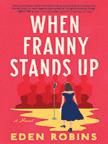

Pitched as a cross between The Marvelous Mrs. Maisel and A League of Their Own , this period piece is about a young Jewish woman named Franny Steinberg who turns her personal trauma during and after World War II into a career as a stand-up comedian in Chicago. But Eden Robins doesn’t just go for laughs—When Franny Stands Up is also a powerful story about anti-Semitism and the oppression of women in midcentury America, with fun historical cameos from the Palmer House Hotel, Marshall Field’s holiday window displays, and more.
Super Sad Black Girl by Diamond Sharp
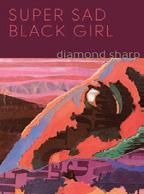

(Haymarket Books)



When publishers refer to a book as “a love letter to Chicago,” you know you’re in for something special. Diamond Sharp’s debut poetry collection is a dazzling and devastating heir to the verse of Gwendolyn Brooks and the dialogue of Lorraine Hansberry—two legendary south-side writers who speak to Sharp throughout these poems as she su ers from depression. Sharp’s truly unique perspective of the city belongs on your shelf next to Eve L. Ewing’s 1919 and Cortney Lamar Charleston’s Doppelgangbanger.
Book of Extraordinary Tragedies by Joe Meno (Akashic Books)

In his latest novel set around the Great Recession, Joe Meno returns just south of city limits to the neighborhood where he grew up: Evergreen Park. Book of Extraordinary Tragedies is about a 20-year-old musician named Wolfgang Amadeus Aleksandar Fa, who is slowly going deaf and is desperate to escape what feels like a century-old curse of poverty and ill-fortune on his Eastern European family. With his nuanced portrayal of Chicago’s ethnic, class, and cultural dividing lines, Meno once again proves himself a true heir to Stuart Dybek for the way he captures the essence of life in our neighborhoods.
The Billboard by Natalie Y. Moore (Haymarket Books)
Natalie Y. Moore’s powerful play about an Englewood abortion clinic turned out to be far more timely than she ever could have imagined; it premiered at 16th Street Theater this summer during the same week the U.S. Supreme Court overturned Roe v. Wade. This book features the entire script alongside a stunning foreword from Imani Perry, author of Looking for Lorraine: The Radiant and Radical Life of Lorraine Hansberry and an afterword from Jane M. Saks, the founding executive director of the Institute for the Study of Women and Gender in the Arts and Media at Columbia College Chicago. v

DECEMBER 22, 2022 - CHICAGO READER 27
@adamm0rgan KIRK WILLIAMSON




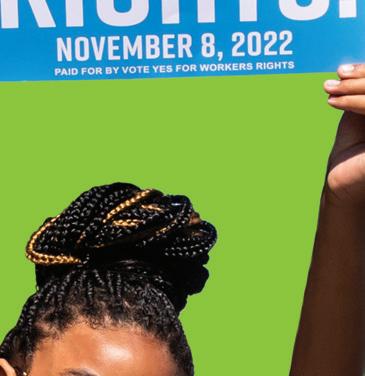










28 CHICAGO READER - DECEMBER 22, 2022 ll Thank you to every worker in Illinois that voted for themselves in November, and passed the Workers’ Right Amendment. WE DID IT!!!
ILLINOIS VOTERS PASS WORKERS' RIGHTS AMENDMENT!













DECEMBER 22, 2022 - CHICAGO READER 29
Workers in Illinois now have the strongest protections of any state in the U.S.!
ARTS & CULTURE
REVIEWS
Gallery.
Curator Matt Morris’s “In the United States there is more space where nobody is than where anybody is,” up at Loyola University’s Ralph Arnold Gallery, is a full-hearted and generous analysis of Kim Krause, Morgan, and Sabina Ott’s bodies of work. The exhibition is strikingly expansive, explicitly positioned within the histories of modernism and postmodernism. Morris centers each artist’s work as an educator to present abstract art, specifically abstract painting, as a pathway to freedom for the individual and collective.
With an exhibition title taken from Gertrude Stein’s thoughts on the possibilities of an American character, Morris explicitly situates each artist within the midwest in order to constructively interrogate art making, art labor, and artistic expression throughout the 20th and 21st century. The work itself is lusciously rendered and touches on everything from America’s post-WWII expansionism to the dot-com boom, a cornucopia of references and touch points that serve as guideposts. A radical sense of play and joyful mess creates a through line from which viewers consider how visual abstraction defies reductive definition. Such freedom in turn presents compelling possibilities for art making and community in a region that has suffered uniquely from economic despair, racism, queerphobia, and sexism due to its derisive status as “flyover country” and all attendant material disadvantages such a moniker implies. An exhibition formed by and through a compelling hybridity of thought defies rote analysis but does depend on a generosity of spirit, a willingness to teach possibility and openness. Morris accomplishes just this in a show that opens eyes and horizons. —ANNETTE LEPIQUE IN THE UNITED STATES… Through 1/25/23: Sat noon-4 PM, Ralph Arnold Gallery, 1131 W. Sheridan, luc.edu/ralpharnoldgallery
R Finding power in pushing back
At FLXST Contemporary, seven artists find community in the margins.
There is power to be found in pushing back, there is community to be made in forming resistance. In “A Rebel’s Fantasy” at FLXST Contemporary, curator Michael Rangel brings together seven artists from Chicago and beyond to remind us of the pure joy found in relishing rebellion, in pushing against the regulations, expectations, and constraints that bind us. With an eye on the “outsiders, the weird ones, the queer, and the monsters,” the exhibition forms a safe space for those of us on the margins, a place for experiences to visually overlap and intersect.
The mixed media paintings of Humberto Maldonado remind us that, in order to rebel, there must be something to rebel against. In works such as How’s Your Head?, Maldonado offers us that something—the restricting and damning industry of organized religion— by physically using religious tokens such as cross necklaces in his queer-centered paintings. Enrique Nevarez’s textured paintings also borrow religious iconography while rendering ultra-feminine, highly-saturated scenes of pink frosting-like paint and glitter. These works show a world where religion and playfully sexual beings can exist in tandem instead of in conflict—no matter the sexual preferences or kinks.
Sexual/sensual bodies also have a place in Brianna
Noble’s work, which not only allows femme Black folks to take up space and agency, but also simply lets them just be sexual according to their own rules. There is so much joy present in the works in the exhibition that we almost forget that this is meant as a “rebellion.” Unfortunately, other people’s pleasure, the act of being joyful, is o en seen as a rebuttal, an act against a regulation or constraint that existed before us, made by others without our consent. Whose rules? Not ours. There is an air of hopeful resilience in the works that, one day, these acts won’t be a rebellion—they will simply be. —CHRISTINA NAFZIGER A REBEL’S FANTASY Through 12/31: WedFri 2-5 PM, Sun 2-5 PM, FLXST Contemporary, 2251 S. Michigan, Ste. 220, flxst.co
R
Museums are everybody
Alberto Aguilar turns a solo exhibition into a collaborative thought experiment.

For “Yo Soy Museo” at the National Museum of Mexican Art, Chicago artist Alberto Aguilar mines the relationship between the museum and the artist, cannily playing with notions of display and presentation. Having the distinction of being the first exhibition in the museum’s history to not have to take out a single loan agreement, “Yo Soy Museo” presents and re-presents artifacts from the museum’s archival holdings, trinkets from employees’ work spaces, catalogs from previous exhibitions, and other museum ephemera all intermingling with Aguilar’s own photographs and works that similarly consider the potency of the everyday objects in the spaces we inhabit. Record covers from the museum archive, selected on the basis that they feature a human face, are hung on the wall and then partially obscured by hanging prayer flags, an installation analogue to the 27 self-portraits of Aguilar in which his face is obscured by a seemingly random object (a basketball, a cardboard Pacifico box, etc). While the many objects that populate “Yo Soy Museo” have their own respective strength, Aguilar’s move in this exhibition has less to do with finding meaning in discreet artifacts. Rather, the deeply relational system Aguilar evokes insists that exhibition is everywhere, that possibilities for the cra ing of new meanings and art making can occur with a slight variation in the habits of creative approach. —CHRIS REEVES YO SOY MUSEO Through 2/12/23: Tue-Sun 10 AM-5 PM, National Museum of Mexican Art, 1852 W. 19th, nationalmuseumofmexicanart.org
crates comfortably occupy the angular gallery space as free-standing sculptures. The crates declare they are “property of KDP.” But in response, Kong covers up most of the label, leaving only KDP’s bubbly logo hanging like a pilcrow. A new paragraph of glyphs and symbols begins. What remains most memorable are small stickers that read “be happy,” which quietly appear in many of Kong’s compositions. Happiness, as the artist tries to tell us, is o en hidden—amid the hurry of everyday life—in plain sight. —NICKY NI THANK YOU FOR SHOPPING WITH US Through 1/31/23: Every day 10 AM-6 PM, Design Museum of Chicago, 72 E. Randolph, designchicago.org, free
R Undulation of things
A group exhibition at Apparatus Projects delights in the details of objects.
”Thank You for Shopping With Us,” a pop-up exhibition featuring Chicago artist Thomas Kong and curated by S.Y. Lim, conjures a holiday spirit from unnoticed everyday materials: packaging waste. Kong takes over the corner atrium at the Design Museum of Chicago with rows and rows of plastic thank-you bags that hang across the floor-to-ceiling windows. Each bag serves as a canvas for a unique and colorful collage. Kong, who also runs the convenience store Kim’s Corner Food in Rogers Park, is dexterous at putting excess into artistic use. Various cardboard papers are cut and arranged into abstract but curious shapes; some elicit their previous packaging duties, others stay completely anonymous. One of my favorites: a penny trapped inside of a plastic clamshell case, on top, a green leaf taped to white paper, below, a small orange block—is it a price tag? A post-it? Origin unknown. It’s plain and simple, almost deadpan funny. Stacks of heavily decorated plastic
Something is afoot at Apparatus Projects, namely the beguiling “The door you open is determined by how you twist the knob. The room you enter is determined by how you open the door,” including artworks by Yani aviles, Mira Dayal, and Micah Schippa steeped in the delirious so-muchness of things and not-enoughness of words.
Enter (no knob-twisting required) to Schippa’s standout, a hammered copper bell nesting in a gash in the gallery wall, romantically contracted to remain in place as long as the building stands. Linger for aviles’s looping sound piece, bells bathed in atmospheric noise, emanating from a closed door (this knob doesn’t twist either, I tried). An army of clues accompanies this vaguely spiritual chorus—a box of leaves “shipped west” (aviles), facsimiles of artwork glimpsed in apartment listings (Dayal), clock guts dissolved in fake tears (Schippa). The result: a show about the lives and languages of things—everything from talisman to coincidence, all phenomena speaking in a perhaps divine register. “Signs have always been the language of the Gods,” reads an apt Hölderlin quote in the exhibition text.
I’m reminded of Nabokov’s 1948 story “Symbols and Signs,” whose protagonist is afflicted with “referential mania,” delusions that the external world reflects his inner life, causing the devotion of “every minute and module of life to the decoding of the undulation of things.” Nabokov’s objects control, the exhibition’s objects supplicate. The room, a er all, is determined by how you open the door. —EMELINE BOEHRINGER THE DOOR YOU OPEN . . . Through 1/15/23: Sat-Sun noon-4 PM, Apparatus Projects, 1524 S. Western, Ste. 406, apparatusprojects.com. v
30 CHICAGO READER - DECEMBER 22, 2022 ll
R What makes America what it is Abstraction and freedom take root at Ralph Arnold
RThank you and be happy Thomas Kong makes buoyant artwork from packaging waste.
“Yo Soy Museo,” new works by Alberto Aguilar, continues through February 12, 2023. MICHAEL TROPEA
CAPTIONS
In April, contributor Amy Qin spoke to local Starbucks baristas working to build support for a union (“Brewing solidarity”). As of August, workers at six Chicago-area stores had voted to unionize, following the wave of support for labor unions that emerged nationally in 2022.
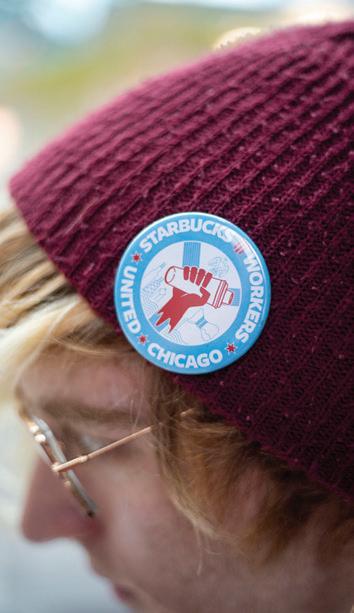 MICHAEL IZQUIERDO
MICHAEL IZQUIERDO
Reader staff writer Katie Prout’s “Searching for The Pigeon Lady” (February) started as interest in a particularly legendary downtown ornithologist but swi ly grew into a series of larger questions about resilience, centered in private moments in public spaces. LLOYD DEGRANE
Beau O’Reilly, a fixture in Chicago’s theater and music scenes since the 70s, continues to perform and create opportunities for other artists. Contributor Mark Guarino talked to O’Reilly in April about theater work on the fringes. (“Beau O’Reilly keeps the folk cabaret alive”) SARAH JOYCE

In January, contributor Sarah Gelbard spoke to unhoused people and their allies about the conumdrum of hundreds of Chicago public housing units sitting empty when there is obvious need. (“Homeless in a pandemic-stricken Chicago”)
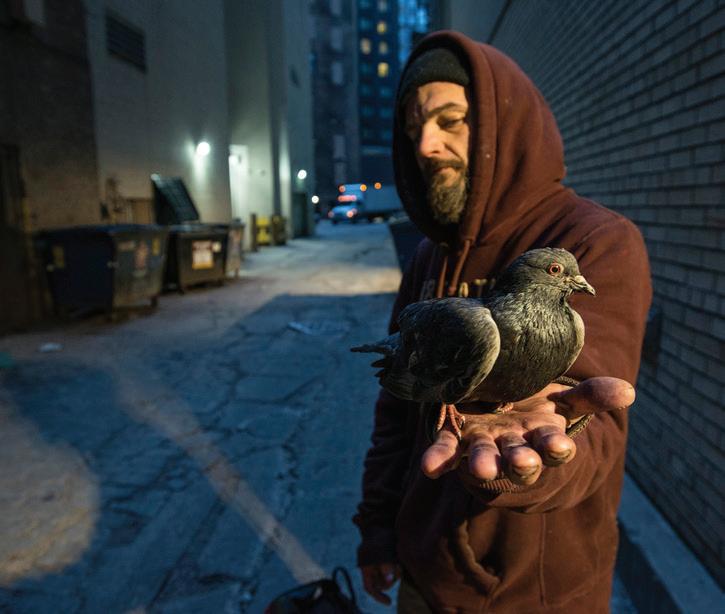
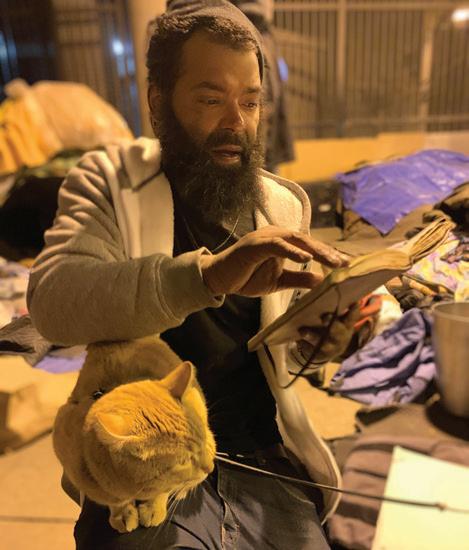 SARAH GELBARD
SARAH GELBARD
Contributor ThoughtPoet shared “#SadBoyEnergy (The Prelude)” with our readers in February; a photo essay examining what it means for Black men to suffer from depression and related stress.

Writer Dometi Pongo is pictured.
THOUGHTPOET
DECEMBER 22, 2022 - CHICAGO READER 31
1
2
3
4
5
1 2 5 3 4
BY SALEM COLLO-JULIN
6
For July’s “Something magic’s growing at Back of the Yards Algae Sciences,” Reader senior writer Mike Sula discovered an unlikely team of bioprospectors experimenting with algae and more. Scientist Leonard Lerer is pictured with a spirulina photobioreactor.
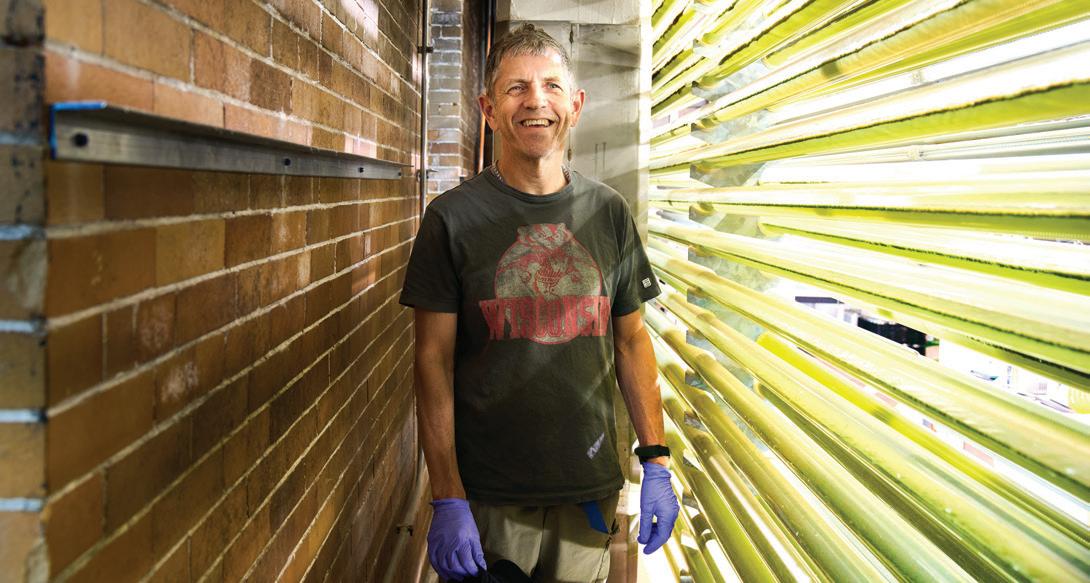
MATTHEW GILSON 7
A er a tulmultuous series of events, the Reader was able to move forward in May with its preconceived plan to shed itself of private ownership and embrace nonprofit status. The transition was not without challenges. In April, Reader union members led a protest outside a former Reader owner’s home, which ultimately helped push the process along. The demo attracted fellow journalists, longtime Reader readers, and labor comrades from other guilds.
LENI MANAA-HOPPENWORTH
19-year-old Austin resident Indya Pinkard was one of several teens that writer Justin Agrelo interviewed about safety, gun violence, the expansion of the city’s curfew for young people, and more, for July’s “Young people dream up a safer summer in Chicago,” a publishing collaboration with the nonprofit newsroom The Trace.
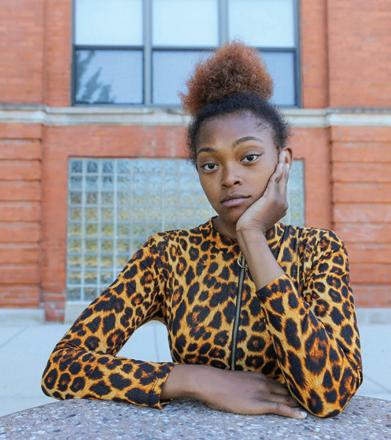 OLIVIA OBINEME
OLIVIA OBINEME
Culture editor Taryn Allen spoke to members of OnWord Skate Collective this summer about plans for a film about their work. The group embraces skaters of all ages and abilities, and prioritizes women, trans, nonbinary, and gendernonconforming people.


DUWAYNE PADILLA 10
In May, contributor Irene Hsiao took in the public and interactive art of southeast side native Derric Clemmons and his South Worx Art Group, who built structures as part of a city initiative to revitalize the area near 89th and Commercial. EDDIE QUIÑONES
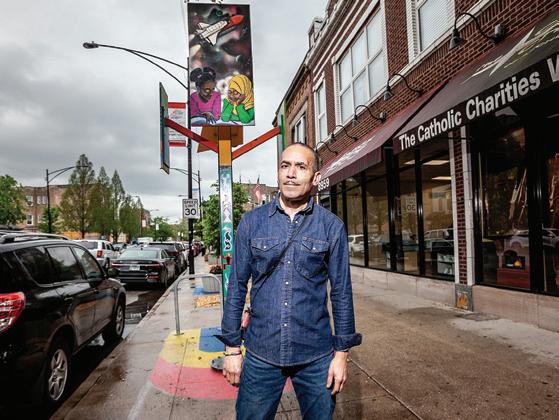
32 CHICAGO READER - DECEMBER 22, 2022 ll
8
9
6 7 8 9 10
Over the course of the year, Reader staff writer Kelly Garcia covered the concerns surrounding large festivals taking resources from public parks, specifically festivals in Douglass Park preventing residents from being able to use the park’s resources. Garcia’s subsequent series of articles looked at the story from several angles: uncovering contracts that revealed political donations from Riot Fest to influential alderpersons, a timeline of community organizing, an interview with Douglass Park youth soccer coach Ernie Alvarez, and reporting about a Peoples Music Fest that galvanized support for the neighbors.
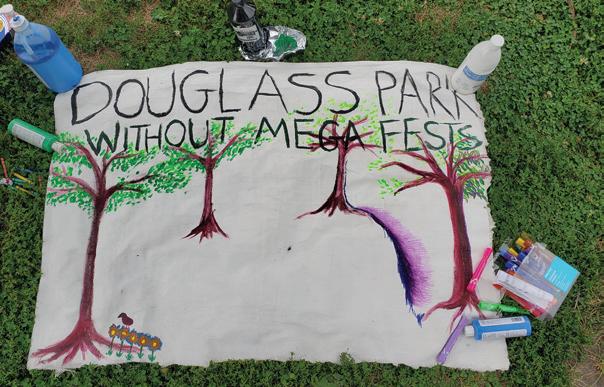
 KELLY GARCIA
CAROLINA SANCHEZ
KELLY GARCIA
CAROLINA SANCHEZ
Mike Sula continued his coverage of innovative local food purveyors who are unjustifiably under the radar with September’s “Pastry chef Ollyvia Putri’s 20-layer cakes are legit.”

For August’s feature “Black Chicago dance culture shines at Art on the Mart,” senior staff writer Leor Galil gi ed us with histories from local Black dancers about their experiences with the famous Bud Billiken parade. Galil talked to the filmmakers and subjects of the short film Billiken , which was projected publically as part of the Art on the Mart series.
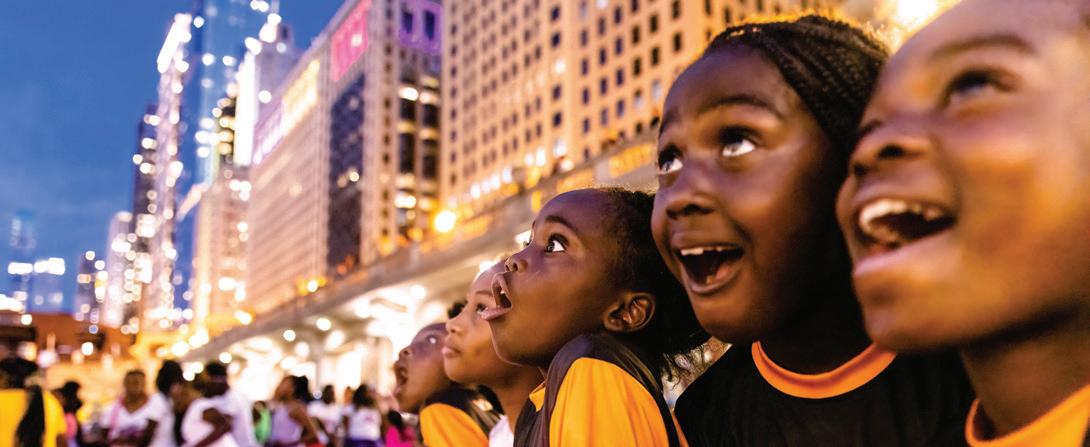
 KYLE FLUBACHER
KYLE FLUBACHER
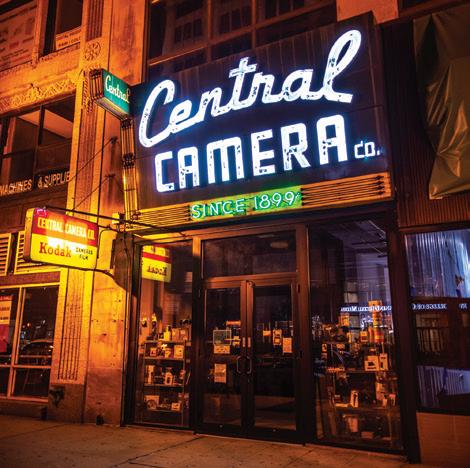
DECEMBER 22, 2022 - CHICAGO READER 33 11
12
Contributor Zinya Salfiti visited Central Camera in August to find out how the century-old downtown camera store has weathered fire, floods, and pandemics.
13
14
JEFF MARINI
11 12 13 14
15
Reader senior writer Deanna Isaacs writes about a variety of subjects for her regular culture column. She tackled the near-total upheaval of reproductive rights that the U.S. experienced this year, including a certain “secret dra ” Supreme Court ruling that was uncovered this spring. (“The end of Roe,” May) KATHLEEN HINKEL 16
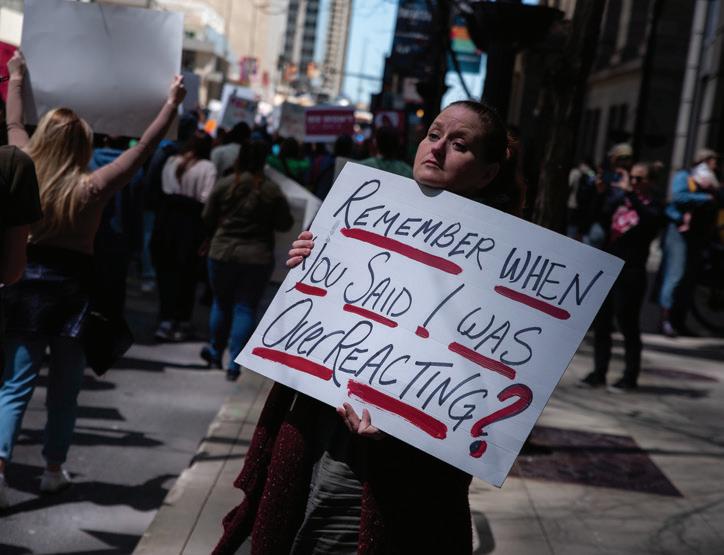
Our music section’s regular Chicagoans of Note series allows our writers to interview local people who play in, work in, or otherwise inhabit Chicago’s music communities. In October, Leor Galil talked to Jason Deuchler (DJ Intel) who co-owns the horror-themed coffee shop The Brewed. STEVEN PIPER 17
Contributor Yolanda Perdomo talked to Albany Park resident Adam Carston about his pandemic lockdown project turned social media archive of Chicago’s moviegoing past. (“Now Playing: Chicago’s history in movie ads,” October) YIJUN PAN 18
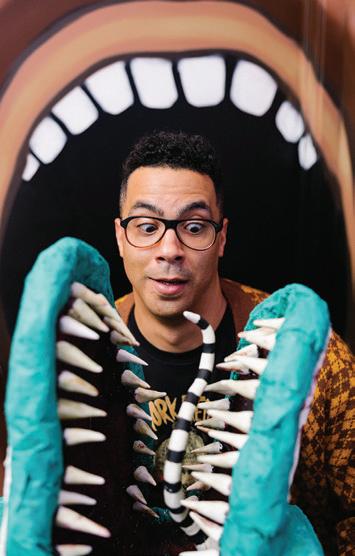
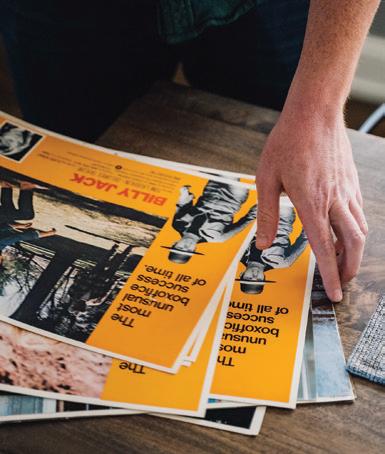
Reader staff writer Debbie-Marie Brown immersed themselves in the fandom of R&B artist Kehlani and found a community of mostly young, mostly LGBTQ+, and all very passionate fans. (“Blue water road to Chicago,” September) DEBBIE-MARIE BROWN 19

In October, Debbie-Marie Brown found another passionate community—kids who love chess and compete nationally with the help of the Chicago organization A Step Ahead Chess. SHAWN SORESBY 20

For November’s “What Paul Moses Taught,” contributor Hannah Edgar talked to Mike Moses, who brought his father Paul Bell Moses’s archives to the University of Chicago’s Regenstein Library, which created a moving exhibition of family history and art. v CLAYTON HAUCK
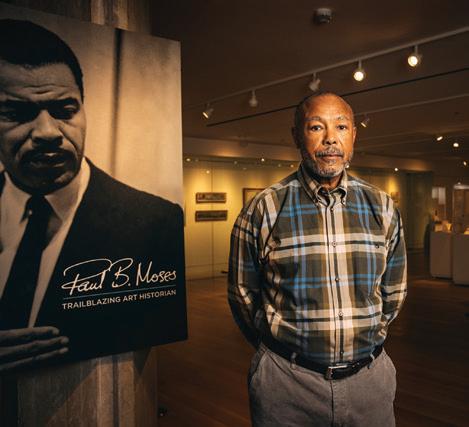
34 CHICAGO READER - DECEMBER 22, 2022 ll
15 16 18 17 19 20





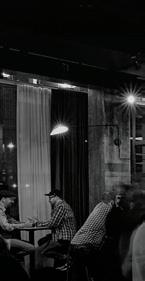













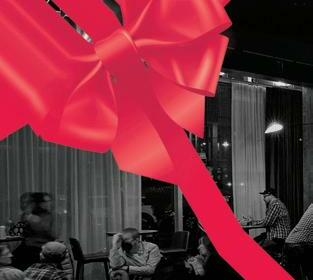












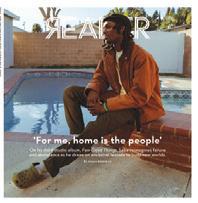































DECEMBER 22, 2022 - CHICAGO READER 35 2022/23 GRAND BENEFACTORS BALD SISTERS By VICHET CHUM Directed by JESCA PRUDENCIO RETURNS TO THE STAGE DEC 28! Experience this irreverent, comedic and ultimately poignant examination of the ties that bind multigenerational families of immigrants together. BUY TICKETS THE BLACK CARD JUST PUT A BOW ON IT STEPPENWOLF.ORG/BLACK-CARD STEPPENWOLF.ORG | 312-335-1650 $35 TICKETS WITH CODE READER Photo by Sekou Luke. AuditoriumTheatre.org 312.341.2300 JAN 14 2022–23 SERIES SPONSORS Florian Fund Global and Chicago Dance 2022–23 SEASON SPONSORS O cial Hotel Partner Student Matinee Denise Littlefield Sobel Now -Jan 29 TONY AWARD NOMINEE FOR BEST MUSICAL Tickets selling fast! Come to the Whorehouse for the holidays! theo-u.com • 773.939.4101 Providing arts coverage in Chicago since 1971. chicagoreader.com
Will Victory Gardens ever bloom again?
The biggest and strangest story for Chicago theater in 2022 has echoes from the past.
By KERRY REID
The biggest story of the year in Chicago theater was also one of the most confounding events in the community in decades: the complete upheaval in personnel and apparent change in mission at Victory Gardens Theater. As we head into 2023, we still don’t have a clear idea of what that means for the future of the company, a key player in the transformative o -Loop theater movement of the 1970s.

What we do have, perhaps, is a cautionary
tale rooted in Victory Gardens’s long history of conflicts between the leadership of the theater’s board of trustees and its artistic and administrative sta . As theaters continue to figure out how to contend with the lingering e ects of the COVID shutdown on audiences, the role of boards in supporting the artistic mission of the organization comes into even sharper focus. What’s happened at Victory Gardens has inspired public response across the country by theater artists and by board members at other regional theaters.
The conflict seems to come down to addressing the gap between what boards can do legally and what they should do to build trust, transparency, and community, especially as theaters continue to proclaim their desire to create diverse artistic visions and attract new audiences. When a theater is dedicated to producing mostly new work and fostering playwrights over time—as Victory Gardens has been for most of its nearly 50-year history through various iterations of the playwrights ensemble—there is a higher risk that not all
36 CHICAGO READER - DECEMBER 22, 2022 ll THEATER
Victory Gardens Theater’s home at the Biograph remains dark a er several months of turmoil.
COURTESY VICTORY GARDENS
-Ken-Matt Martin
the plays produced will find audiences. That makes it even more crucial that boards be involved in supporting the mission (and the artists enacting that mission) for the long haul.
The beginning of the end
In June, Victory Gardens opened cullud wattah, Erika Dickerson-Despenza’s portrait of three generations of Black women in Flint, Michigan, struggling with the profound e ects of that city’s water crisis and the underlying environmental racism that caused it. It was the third show in the company’s 2022 season and the first season programmed by artistic director Ken-Matt Martin, who was hired by the board (headed by president Charles E. Harris II) in March of 2021. (The company only presented digital plays throughout most of 2020 and 2021.)
Martin became the company’s third artistic director in two years, after the (planned) departure of Chay Yew at the end of 2019 and the brief and controversial appointment of Erica Daniels, formerly the executive director at Victory Gardens, to the role of executive artistic director in 2020. Roxanna Conner, formerly director of education, had served as acting managing director after Daniels resigned—a role she continued once Martin joined the staff. Martin, Conner, and Harris are Black, making for a rare trifecta of Black leadership at what had been, for much of its history, a primarily white-led institution. (Yew, who succeeded longtime artistic director Dennis Začek in 2011, was born in Singapore.)
By the end of June 2022, Martin had been dismissed by the board; in a statement on his website posted mid-July, he noted that he had
never received any disciplinary notices and was given no cause by the board for the decision. After his dismissal, the resident artists and playwrights at Victory Gardens (including cullud wattah director Lili-Anne Brown) announced that they were resigning en masse via a Medium post on the page of resident artist (and former Victory Gardens literary manager) Isaac Gómez. Dickerson-Despenza pulled the rights for the remaining performances of her play.
As I reported in September, in the aftermath of Martin’s firing, the remaining sta attempted to unionize via the theater workers’ union IATSE. They were subsequently all fired via a letter from Robert M. Hingsbergen, who was identified as the “chief executive” of Victory Gardens.
According to Bo Frazier, the former marketing manager, none of the staff members had received any disciplinary warnings, nor did they have a clear idea of what exactly Hingsbergen had been brought on to do for the company. Conner resigned from her role at the end of July. The failure of the board to hire a permanent executive director—even though Marissa Lynn Ford (now the ED for the League of Chicago Theatres) had been considered a finalist for the role and was the clear favorite of Martin and the sta —was a point of contention between the sta and the board.
The letter sent to the sta ers said in part, “The termination is part of a general reduction in workforce due to the lack of business and operational needs and a change in VGT’s business model such that your current position has been eliminated.”
For months, the board didn’t respond to requests for interviews from the Reader for
explanations on why they felt it was necessary to make these major changes in staff and what the future mission might look like. As reported by Chris Jones on September 10 in the Tribune , a spokesperson did tell him that “the board had no intention of closing the historic Biograph or retiring the Victory Gardens name” and also told Jones that they might switch focus to fostering other groups, which could include “renting out the space at cost or o ering other forms of support.” The spokesperson also said that the company is not insolvent and hopes to return to producing its own work “eventually.”
Late last week, after reaching out one more time to board president Harris, I received a statement from the board through the outside strategy firm now working with Victory Gardens. In the statement, they claim, “Victory Gardens Theater was placed in a very unfavorable and disheartening position in late July 2022. The organization had no show budget and had not secured or signed a single theatrical agreement for a season slated to begin in the fall. These were the responsibility of the Artistic Director. The lack of any planned season, amplified by the challenges the theater industry faced throughout the pandemic, forced the Board to consider an operational change.”
But according to both Conner and Kat Zukaitis, who served as the new play development manager until she was let go in the September sta purge, the board statement is inaccurate.
In an email, Zukaitis noted that as of June this year, the season for 2022/23 had been planned, with four full productions, a festival of new work, and some other developmental readings and workshops coming together. She added, “All projects had agreements in place with the lead artists and their agents, some formal and some informal. A season calendar was laid out, title art had been commissioned for each of the four productions, and we were on schedule to announce the coming season in July.”
Another former staffer sent preliminary versions of the aforementioned season artwork; among the planned productions were the Chicago premiere of Martyna Majok’s 2018 Pulitzer Prize-winning play Cost of Living and Mexodus by Brian Quijada and Nygel D. Robinson.
Conner, while acknowledging that the theater was coming back from both COVID and the 2020 controversies around the Daniels appointment, said, “The theater was not in a bad place financially. There was not a huge deficit that the theater was facing coming out of the
season.” As for the claim that show budgets had not been set, Conner pointed out, “The job of the artistic director was not to do the show budget, nor to complete agreements. That would have been the job of the executive director, which we did not have.” Conner also noted that the job duties that would have been under the executive director fell to her. “At the time, I was making up the shortfalls for losing six crucial sta members between April and June.” Those staff positions, according to Conner, included director of development, director of finance, and the business manager; several people left to take jobs at larger institutions.
The board has not publicly disputed Martin’s assertion that he never received any disciplinary warnings about his job performance, which presumably would have included concerns about lack of progress on programming the next season. And though the most recent board statement mentions end of July as a turning point, Martin had been dismissed a month earlier.
Further, the board itself at Victory Gardens went through quite a bit of change in recent months, so it’s not clear how much support there was on the board as a whole for the actions taken by board leadership against Martin and for the profound shift in organizational mission. Company letterhead in April 2022 showed a four-member leadership team, including Harris, and 14 other directors. July’s letterhead listed the same four names at the top, but only six other directors.
Attempts to reach former board members for public comment were not successful.
What’s the plan?
The board’s statement from last week said, “While more information will unfold regarding our future, we will focus to support our mission on two areas moving forward.” The first is “Inspiring new plays and playwrights to nurture the diverse stories of our world: We are identifying new ways to support emerging playwrights, with a focus on playwrights of color, as well as to increase the exposure to new plays.”
The second area identified by the board is “Maintaining the legacy of the Biograph Theater to contribute to the vitality of American theater: We are exploring options to subsidize other theater companies to use the Biograph Theater for their productions. We are also considering allowing some private rentals to offset the costs inherent in operating a theater.”
DECEMBER 22, 2022 - CHICAGO READER 37 THEATER
WATCHED, AND I’VE EVEN OVER THE LAST FEW DAYS TALKED TO OTHER ARTISTIC DIRECTOR COLLEAGUES AROUND THE COUNTRY WHO ARE REFLECTING THESE SAME KIND OF STORIES TO ME, WHERE PEOPLE ARE TREATING THEM AS IF THEY HAVE NO IDEA HOW TO DEAL WITH THE BOARD. “
“I’VE
THEATER
Both initiatives were already happening under the previous mission. But several questions remain about the new direction proposed by the board leadership, moving Victory Gardens away from being a producing regional theater.

For example, what feasibility studies, if any, were undertaken before taking the drastic step of dismissing the staff and essentially shuttering the Biograph space? Did they have input from consultants about how they can make this new model (whatever it might end up being) work?
In a recent interview, when I asked Martin if he had been presented with plans for potentially shifting the theater’s mission, he said, “The most truthful and easiest thing to say on the record is that was never anything that was ever discussed with me. I found out about it in the press just like everyone else.” That raises the question of how long this shift had been in the works. Was it a reaction to the public outcry over the firing of Martin, or something that the board had been considering for some time?
If the board plans to make the space available even with subsidies or “at cost,” as they told the Tribune , what does that mean for renting companies, in hard dollars and cents? Which current companies in Chicago do they think might be able to afford that “cost,” and would be able to fill the nearly 300-seat downstairs auditorium at the Biograph? After all, several companies are moving ahead with plans for their own spaces, including TimeLine, American Blues, and Steep. It’s hard to see what companies without the built-in history and prestige of Victory Gardens (the company won the regional Tony Award in 2001) would be able to take it over long-term. Who does the board think will be able to draw audiences even on a show-by-show basis? Touring commercial productions already have the option of renting the 549-seat Broadway Playhouse in Water Tower Place, and the Studebaker in the Fine Arts Building, which houses NPR’s Wait Wait . . . Don’t Tell Me! , is bigger than most Chicago companies would want. (The Carriage Hall, under construction in the Fine Arts Building and slated to open in 2024, might be a better fit for smaller companies looking for a downtown foothold.)
Victory Gardens had routinely made the smaller 109-seat upstairs Richard Christiansen Theater available for
rent, especially to resident companies such as Sideshow. The last show I saw there was now-defunct Underscore Theatre’s Notes & Letters . Sideshow’s artistic director Regina Victor resigned in July, and the company pulled their residency after Martin’s dismissal; currently, the Sideshow website notes that they are on hiatus.
There’s also the question of who might want to work at Victory Gardens; rental facilities need technical and front-of-house staff, at a minimum, and given the highly public dismissal of Martin and the other sta , it’s fair to ask if the board can build enough trust to find people worth hiring to join the organization in that capacity, let alone as a permanent artistic director or executive director.
Real estate ruckuses
One of the points of disagreement between Martin and the board, in addition to the failure to hire a permanent executive director, was the board’s decision to acquire the adjacent storefront just north of the theater (and part of the Biograph building) for around $250,000. Sta members and the resident artists (including the playwrights ensemble) had questioned the outlay, given that,
according to a few former sta ers, the Christiansen space needs repairs in HVAC (some performances from renting companies reportedly had to be canceled due to insu cient air conditioning, causing VG to pay back renters for lost revenue), and the entire building has plumbing issues.
The Biograph, which famously was where gangster John Dillinger saw his last movie before being shot down by G-men in an adjacent alley, is both an o cial Chicago Landmark and on the National Register of Historic Places. Many social media posts speculated that the board would sell the building and turn it into condos. But according to a 2020 piece by WTTW’s Geo rey Baer, though the Commission on Chicago Landmarks and City Council can un-landmark buildings that can then be demolished, such a step is “quite rare.” There are also legal restrictions against nonprofits selling property for the personal profit of board members or otherwise distributing nonprofit assets (in the event of shutting down completely) to anything but other nonprofits.
According to a statement released by board president Harris on July 14 after Martin was fired, “The real estate transaction mentioned by the playwrights’ ensemble appears to be misunderstood. The transaction concerns

the ownership of the theater property and will have no adverse impact on the financial stability of the theater or its artistic direction. In fact, this minor investment preserves the fabric of the Biograph theater, gets us out from under a challenging co-owner situation, and ultimately saves money in the long run.”
Some former sta ers told me that they had been told the newly acquired space would provide an o ce for VG sta —and they noted that, when the theater had over 20 employees (though as Conner pointed out, it had been operating with far less than that since the return from the COVID shutdown), the office space was indeed cramped. But it seems unlikely that there will be an immediate need for o ces since there is no sta right now.
Arguments over real estate have been part of the Victory Gardens story for over two decades and through various boards. Victory Gardens acquired the Biograph in 2004. But even before that move, the board had been pushing the company, then under the leadership of Začek and his wife, Marcelle McVay, who was managing director, to move out of their longtime home at 2257 North Lincoln (which was also the home of the legendary and long-defunct Body Politic Theatre). As reported by Reader columnist Lewis Lazare
38 CHICAGO READER - DECEMBER 22, 2022 ll
continued from p. 37
Le : Ken-Matt Martin, former Victory Gardens artistic director; J. Chris Babb, chair of the board of trustees for Woolly Mammoth Theatre in Washington, D.C. LOWELL THOMAS/NAIM HASAN





DECEMBER 22, 2022 - CHICAGO READER 39 Share Music. Buy Gift Certificates! ots.fm/gift Good for Classes, Concerts, and Gear! oldtownschool.org This winter, try an 8-week group class in guitar, ukulele, dance, banjo, and so much more. Your Musical Adventure Begins with Old Town School! FOR IN PERSON & ONLINE CLASSES, SIGN UP AT:
THEATER
in September 2000, the board was pushing for a move to the now-shuttered Royal George Theatre, and they were willing to assert their authority over the artistic leadership.
“The theater’s board of directors and its president, Hud Englehart, think Victory Gardens could be a bigger player on the local and national scenes if it expanded its offerings, acquired a larger and more comfortable facility, and brought on additional management to oversee the anticipated growth,” wrote Lazare. “Late last month, in a closed session, Englehart and the board voted almost unanimously to launch a search for a chief executive officer who will have authority over all theater staff—including the theater’s founders, artistic director Dennis Začek, and managing director Marcelle McVay.”
That move to the Royal George obviously didn’t happen. But I spoke to several members of the original playwrights ensemble assembled by Začek who told me that they had long felt there were members of the Victory Gardens board who wanted the company to move closer to being another Steppenwolf.
“The idea of moving to the Royal George was just nuts,” said former ensemble member Charles Smith. “There was a distinct feeling that there was a kind of push to be like Steppenwolf going on. Steppenwolf had their new building [on North Halsted]. I assumed—we all had the understanding that one of the reasons they wanted Royal George was because it was across the street from Steppenwolf.”
Former ensemble member Jeff Sweet told me that he believes there were board members during his tenure at Victory Gardens who had “a basic misunderstanding of what this company is supposed to be about. If Steppenwolf was supposed to be the house of the actor, and Goodman was more or less the house of the director, Victory Gardens was the house of the playwright.” And though Sweet also acknowledged that doing new work can be a crapshoot in terms of critical and audience response, he noted, “There was one season where all five slots were shows that were written by the resident writers. And it was our most successful season. Everybody got nominated for stu , we won awards like crazy. We did good box o ce.”
Even the move to the Biograph wasn’t a popular one with all the then-playwrights ensemble members; both Sweet and Smith told me that they had qualms about the size of the Biograph and the ability to keep the seats filled. (The former Victory Gardens space seats just under 200.)

Nevertheless, the move happened and the Biograph’s outstanding mortgage was paid off some years ago by then-board president Steven Miller (who stepped down in 2020 at the same time that Daniels resigned). The board then decided in 2008 to sell Victory Gardens’s former theater to then-board members William and Wendy Spatz for a reported $2.5 million. That venue is now the Greenhouse Theater Center; the sale stipulated it must remain a theater for 25 years, and the money from the sale reportedly helped meet capital improvement costs at the Biograph. However, Začek and McVay publicly opposed that sale; as Deanna Isaacs reported for the Reader , “The deal—cooked up in the company’s executive committee and whisked to approval on April 21, after a single, emotional board meeting—left dissenters, including Začek, in shock.” McVay departed Victory Gardens later that year.
Other boards speak out
Boards have a lot of power in the nonprofit realm, and hiring and firing artistic leaders and making fiscal decisions are indisputably part of their responsibilities. As I reported for the Reader’s 2021 nonprofit issue, many theater boards are also wrestling with how to be more accountable to racial and social justice issues in how their organizations operate.
There are solid legal reasons for why all board business is not made public. But in the wake of the Martin firing and the decision of Victory Gardens’s board to change its model, several trustees at Woolly Mammoth Theatre in Washington, D.C., took the unprecedented step of circulating a public letter of support for the fired Victory Gardens staff, asking other theaters to sign on and commit “to improving relations between the boards of the theatres we sit on and the professional artists and culture workers who give our theatres life.” (As of this writing, no board members of Chicago theaters are among the over 70 signatories.)
J. Chris Babb, president of the Woolly Mammoth board, told me, “The decisions on what happens to an organization should not happen and be dictated down. They should be driven from the ground up, from the community, through the workers to a group of trustees that are there to help the organization support whatever those e orts are. I like to think being on a board of a nonprofit organization is obviously something of a passion. Usually, it has some kind of emotional connection beyond
just the fiduciary.”
Martin (whose resume prior to Victory Gardens included working as an associate producer at the Goodman, as a producing director for Williamstown Theatre Festival, and founding and serving as executive director for Pyramid Theatre Company in Des Moines), told me about the lack of respect for his administrative expertise he felt was present during his time at VG. But he also noted it’s a systemic issue in American theater.
“Forget me and forget VG for a second. I’ve watched this happen to other colleagues where all of a sudden people [on the board] treat them as if it’s their first time at the rodeo,” Martin said. “It might be [the board’s] first time having a leader that looks like that at that particular organization, or maybe they hold some other kind of marginalized identity of some sort that makes them new to leadership at that organization. I’ve watched, and I’ve even over the last few days talked to other artistic director colleagues around the country who are reflecting these same kind of stories to me, where people are treating them as if they have no idea how to deal with the board.”
When Martin was hired, Harris (who became board president when Miller resigned in 2020) told me, “We put out a fairly detailed job description and within that job description we had the whole gamut of things that artistic directors do, but it was important to us to make sure that we incorporated the diversity and the equity movement and everything that’s going on with that and what we’re hearing from BIPOC. . . . And of course Ken-Matt checks all those boxes.”
Sweet and Smith, who were placed on emeritus status by Chay Yew in 2012 along with the rest of the original playwrights ensemble (leading to some public controversy), both praised Martin’s capacity to reach out to the past members after that rift. Martin told me when he was hired, “I have to do some intense listening to get a deeper understanding of what all the complexity of issues are so we can figure out what that then means for the future.” One of the projects Martin had been working on was a festival for Victory Gardens’s 50th anniversary in 2024, bringing together original playwrights ensemble members with younger directors.
It’s still not clear exactly where the most recent breakdown began between the staff and board leadership, and as noted, it’s not the first time it’s happened in Victory Gardens history. But it’s feeling a lot as if it will be the
last time.
Martin says, “I recognize the loss of this institution, and I still feel a great deal of responsibility. You know, I was very close to Marcie and to Dennis. It’s not like I wasn’t in deep conversation with them and Chay. I met individually with 246 people as a part of my listening tour during my first six months who were stakeholders, former employees, current employees, former board members, to make sure that I had an understanding of how to build for the future. And we were poised to do that.”
There’s a painful irony that the last production under the old model for Victory Gardens, cullud wattah, was one of the best shows I’ve ever seen at the theater. And like the Flint water crisis, it feels like this latest (last?) chapter in the theater’s history didn’t have to happen the way it did.
But whatever happens with Victory Gardens, Martin is moving on with new creative endeavors. He’ll be directing Nia Vardalos’s Tiny Beautiful Things (which was presented at Victory Gardens in fall 2019) at Baltimore’s Center Stage, opening in March. “I’m also developing this big old huge musical that I’m directing and choreographing for the Apollo [in New York],” he noted.
“I’m very grateful for the work, and I’m grateful to get to make great art that I care about with amazing artists,” Martin said. “Between what I’ve personally gone through and what I know my colleagues are going through at various other institutions and everything that’s happening in both the commercial and nonprofit sectors, it’s a very dire, dark time for our industry. And yet the optimist in me is still sheepishly optimistic that there is another side.” v
40 CHICAGO READER - DECEMBER 22, 2022 ll
@kerryreid continued from p. 38
MICCO CAPORALE
Don’t wait for the knock on the door
In 2022, the best of dance held and sustained space for others.
By IRENE HSIAO
The year 2022 was designated the “Year of Chicago Dance” by the city of Chicago, drawing a commitment from the mayor and several partner institutions to increase investment, collaboration, participation, and focus on dance in all its forms in Chicago. But if institutions are “humanly devised structures of rules and norms that shape and constrain individual behavior,” could it be possible for them to address the needs of an entire population?
“You can wait for a museum curator to knock on your door, or you can just go ahead and do it yourself. So I am choosing the latter, because I never waited for an important person to come; I’ve always shown our work,” declared Eiko Otake in advance of I Invited Myself, Vol. 1 , her February residency in the galleries of the School of the Art Institute of Chicago, and The Duet Project: Distance Is Malleable, her audacious and elegiac performance with Ishmael Houston-Jones and Iris McCloughan at the Dance Center of Columbia College days before
her 70th birthday in February. In one moment, Otake, dressed only in a thin white shift, flung open a door house left, flooding the theater with a sudden draft of piercingly cold air, revealing that nothing but a door and a decision separate outside and in.
For those who have devoted our lives to this art, dance is not an event; it is a practice and a way of being that began before and continues beyond this year. Every year, there is vastly more dance than any individual can experience—and many dances experienced that are not recorded. As Merce Cunningham famously said, dance “gives you nothing back, no manuscripts to store away, no paintings to show on walls and maybe hang in museums, no poems to be printed and sold, nothing but that single fleeting moment when you feel alive. It is not for unsteady souls.”
And yet, part of practicing any art is the sense that life lived with intensity in its moment must disturb the universe. And part of documenting it is the sense that some vivid-
ABEELE
ness can persist beyond the frailty of individual memory—which is briefer and even more fallible than the mortal bodies that transmit this energy, channeling it into temporary form before it succumbs to the heat of our entropic existence. When we enter a space of performance, we mutually agree—as performers and as audience—to share this fragment of being with one another, to be present for each other, and to surrender to what the time brings.
For this reason, the stories and events that feel most necessary to reflect upon from this year are those that hold and sustain space for others. As demonstrated by the breaking community, few resources beyond intention are required for an art to sustain itself; the labor, ingenuity, and generosity of committed individuals contribute to and create the whole. “Each one, teach one,” said Angelina RichUsher, who founded what eventually became the city’s largest open breaking practice simply to create a safe space for women to break. (It’s continued under Melissa Metro and Jason Poleon’s care and moved on from its longtime home at Clarendon Park.)
If everyone is a teacher and everyone is a student, everyone has something to share— space, knowledge, energy, attention, appreciation, music, food, love, time.
Other communities sustained by the spirit of sharing and inclusion include new crew Ajumma Rising, which celebrated Lunar New Year and Black History Month with a flash mob at a Korean market. (“If you have struggles, if you hustle and self-sacrifice for other people, if you work hard . . . you’re an ajumma,” said founder Joanne Yum Gutierrez). The Fly Honey Show, which marked its 12th year with its first performances at Thalia Hall, o ers that inclusion necessitates and embraces evolution. “In the best way possible, the people who watch and the people inside tell us what it is every year,” said founder Erin Kilmurray. “Over the years, people inside the project started taking ownership over what they loved. It has created its own culture.”
“Privilege . . . is a system of hierarchy. It is so ingrained in how we perceive each other. We’re always in a scarcity mentality, in competition for power,” noted dancer and founder of the Blasian March Rohan Zhou-Lee. Sharing resources is “a way to reimagine what our world could be. Every action, every book fair,
every rally, every community fridge filling, needs to be a snapshot of the world I believe in, the world I want to see.”
If we make enough snapshots, we get motion; if we make enough motion, then we have movement. Bim Bom Studios, which opened in January of this year, is already a small but mighty space for dance and music in Portage Park with a particularly thoughtful sliding scale that honors “work that might never be shown” and the “tender, messy phases of your process that often go underfunded / self funded / or not funded at all.” During Freedom From and Freedom To, which has occurred periodically at Elastic Arts since 2019 and extended its footprint to the Museum of Contemporary Art and Links Hall in 2022 (full disclosure: I have performed in this event), audience members draw names of musicians and dancers from a bag for immediate spontaneous improvisation. For intervals of 15 minutes, strangers push boundaries and create tenuous utopias that are dependent on the agreement to cooperate and collaborate.
Perhaps it was the visceral illustration of the fragility of the individual and the power of the collective that made Pina Bausch’s The Rite of Spring, performed by École des Sables at the Harris Theater, so profoundly moving. Or perhaps it was simply the sense that it could be possible to sit together and surrender to a work of art, to feel or at least imagine Stravinsky’s overwhelming bass as a collective heartbeat, for an evening.
“Dance is not sustainable—yet here we all are,” said Joanna Furnans, as of 2022 the executive director of Chicago Dancemakers Forum, during the Elevate Chicago Dance Festival this fall. Moment by moment, step by step, in practice, in process, in progress—we cannot wait for an important person to come. We must share our work now. v

DECEMBER 22, 2022 - CHICAGO READER 41
DANCE
The Rite of Spring , performed by École des Sables at the Harris Theater in October MAARTEN VANDEN
@IreneCHsiao
THEATER
What’s old becomes new again
A Reader writer’s 2022 repertory roundup
By KAT SACHS
For cinephiles, what’s old always has the opportunity to become new again. We’re lucky here in Chicago that, in addition to new releases, several local theaters (as well as groups of independent programmers) make a point of programming older movies from bygone eras. As I look back on my moviegoing year, it’s often these viewing experiences that I remember most fondly.
Rather than make a list of my favorite new films of the year, I’ve made a list of my favorite repertory screenings of 2022. The rules are loose, as you’ll soon read, but for the most part I attended these screenings here in Chicago. Of course, there were also many excellent screenings that for myriad reasons I wasn’t able to attend, but that’s another list altogether.

10. Dominique Cabrera’s Tomorrow and Tomorrow Again (Diary 1995) (1997) at the Logan Center for the Arts, April 30 It’s fitting to begin this list with Cabrera’s
film, which revolves around reflection as she employs a diaristic mode of filmmaking to examine a year in her life as a depressed single mother. She appropriates the quotidian for cinematic form as well as content, crafting poetry out of the prosaic. Cabrera made the film, she says, “to establish contact with the outside world, with something other than my own fear,” expressing the medium’s capability for transformation. Overall her work connects the personal with the social, depicting how someone’s intimate life is influenced by (and sometimes even influences) what’s happening outside it. The French filmmaker appeared via Zoom after the screening in conversation with University of Chicago professor Dominique Bluher, for whose retirement this event was a celebration.
9. George Romero’s Dawn of the Dead (1978) at the Music Box Theatre, February 5
I rarely stay up past 11 PM anymore, so midnight movies pose a challenge they once didn’t.
With drooping eyelids, I made my way to the Music Box for this zombie classic (presented as part of the monthly Music Box of Horrors screening series), and aren’t I glad I did. Romero’s follow-up to his seminal horror film Night of the Living Dead (1968) is notoriously di cult to see—in a theater, no less—because of some unwieldy rights issues. Tired as I was, an introduction from local film critic Deirdre Crimmins roused me, as she imparted upon us viewers the importance of the screening. It was her connection to the elusive rightsholder that allowed the Music Box to screen it. Dawn of the Dead is arguably Romero’s best zombie film, and its stark social satire (it takes place in a mall, where the excesses of capitalism help to sustain survivors of the zombie apocalypse) will wake you up figuratively if not literally.
8. (Tie) Marie-Claude Treilhou’s Simone Barbès or Virtue (1980) via Another Screen, January 10 / Cauleen Smith’s Drylongso (1998) at the New York Film Festival, October 2
Sure, I technically viewed Simone Barbès or Virtue in Chicago but at home on my computer rather than in a theater. I watched it via Another Screen, the virtual streaming platform of the UK-based feminist film journal Another Gaze. The film and platform (a resource for hard-to-see films made by women) are, thus, both worthy of inclusion. Simone Barbès follows a young French woman over the course of a night, from the porn theater where she works as a ticket-taker to a hypnagogic lesbian bar to, finally, a chance encounter with a lonely oddball as she’s heading home. Treilhou’s direction is as assured as the film’s unflappable protagonist, with whom we careen through an anything-but-ordinary Parisian eventide.
Tied with that is Smith’s independent masterpiece Drylongso, which centers on college student Pica as she undertakes an ambitious project for her photography class: she takes Polaroids of young Black men around her Oakland neighborhood, making the case for them being almost an endangered species due to localized violence and police brutality. She also makes a new friend in a young woman shielding herself from male attention while a serial killer terrorizes their neighborhood. There’s a lot going on in the film, and just as much going for it. The screening had something of a local connection, as University of Chicago professor Jacqueline Stewart (now director and president of the Academy Museum of Motion Pictures in Los Angeles) moderated the post-screening Q&A with Smith at the New York Film Festival.
42 CHICAGO READER - DECEMBER 22, 2022 ll FILM
SCREENINGS
All That Jazz (1979) MUSIC BOX THEATRE
7. “Prefiguring Immediacy: Video Art by Mako Idemitsu” at the Logan Center for the Arts, April 3
This South Side Projections screening provided for one of the most exciting new-to-me filmmakers this year. Japanese media artist Idemitsu, who began making films while living in California, explores themes such as feminism and the ubiquity of television through her signature “Mako-style,” in which a monitor within the composition exhibits images subliminally connected to what’s happening in the work. The four short films and videos included in the program provided an interesting overview of Idemitsu’s practice. In Another Day of a Housewife (1977), for example, the titular figure goes about her daily routine all while an eye peers out from an omnipresent television set. In Hideo, It’s Me, Mama (1983), a mother monitors her son away at college via a TV, even setting a place for it as she and her husband eat dinner. The commentary on domestic relationships in Japan is obvious, but these surreal details make it especially potent.
6. Anthony Mann’s Dr. Broadway (1942) at the Music Box Theatre, August 27
This played as part of Noir City, an annual extravaganza that presents a week of noir film screenings, mostly on celluloid (this is the first film on the list that was projected on 35-millimeter). Anthony Mann was known as much for his noirs as his westerns (Winchester ’73, The Far Country, etc.), so it wasn’t that surprising to see him represented in the series. What was surprising is that the film was his directorial debut, based on the character created by Borden Chase. The titular Dr. Broadway is a genial always-do-well who’s forsaken a more lucrative practice to help the lovable lowlifes of Times Square. In what was intended to be the first of a series, Dr. Broadway saves a wayward dame and goes up against a rowdy gang looking to cash in on an ex-nemesis’s inheritance to his estranged daughter. (After the screening, many a fellow cinephile lamented that the series hadn’t moved forward.) Mann, with the help of German-born cinematographer Theodor Sparkuhl, contributes meticulous compositions and dramatic lighting to the otherwise satisfyingly pot-boiler-esque proceedings.
5. J.C. Cricket’s Sex Demon at the Music Box Theatre, October 26
I’d been eager finally to see this movie after the discovery of a 16-millimeter theatrical print of it was announced a few years ago by archivist and queer film historian Elizabeth
Purchell. What makes this all-male horror pastiche so special? My colleague Micco Caporale said it best in their piece about the screening: “As a sexually explicit camp masterpiece, Sex Demon has it all. The film only runs an hour but manages to deliver some incredibly tender dicksucking and artfully framed fucking.” Indeed, it exceeded my wildest expectations (because, as it turns out, I don’t have the capacity to amuse expectations this wild). Purchell’s recorded introduction added to the experience, as she provided context that made it all the more edifying and enjoyable. Considering its subject—a young man who becomes possessed by an ancient demon, with no impact at all to his libido—the film was an exceptional choice for the Music Box’s 31-day Music Box of Horrors: Scared Stupid series.
which considers domestic violence with chimerical self-possession, is from 1981. Overall, however, it was the community celebrating its space and history that made this one for the list.
3. (TIE) Jane Campion’s In the Cut (2003) at the Music Box Theatre, March 14 / Chantal Akerman’s Jeanne Dielman, 23 Quai Du Commerce, 1080 Bruxelles (1975) at the Gene Siskel Film Center, January 24 Campion’s In the Cut is a criminally neglected masterpiece, so to see it in a theater (courtesy of the Chicago Film Society) projected on 35-millimeter was a highlight of my moviegoing year. The film is an erotic psychological thriller par excellence: Meg Ryan stars as a New York City school teacher caught in the crosshairs of a violent serial killer. The film moves as languidly as its star, almost sexily sluggish. Meanwhile, Mark Ru alo plays the detective assigned to the case, and the two enter into a torrid affair amidst gruesome discoveries of the killer’s victims. Campion’s distinct visual sensibility makes her films ideal to see on the big screen, and this, with its sepia-toned, sometimes foggy veneer, is no exception.
decide which is which. Both series (the first earlier this year, the other now happening every month or so) were great (other pairings include Robert Bresson’s Mouchette with Patrick Read Johnson’s Angus and Maurice Pialat’s Graduate First with Paul Weitz’s American Pie), but it’s this particular combination that left an impression on me. Each film considers what if? What if Jesus had thwarted crucifixion? What if Peggy Sue could go back in time and not marry her adulterous husband? The same predicament, really. In seriousness the pairing was shockingly potent, leaving me in tears. In what’s perhaps my favorite filmgoing-related moment all year, when the screening was over and the audience was exiting the theater, I overheard a young man exclaim to his companion, “God, I love movies so much.” Same, bro. Same.
4. Nightingale Cinema’s Farewell (for now) Festival, April 23 - 25

One source defines a repertory cinema as one “whose programme [sic] is based on screenings of older films that have finished their commercial runs.” But what if a film never received a commercial run? It’s with that question in mind that I again abuse the already nebulous parameters of this list to include the Nightingale Cinema’s Farewell (for now) Festival upon the space’s closing in late April. The Noble Square microcinema (where, full disclosure, I’ve served as a programmer) closed, but not the organization itself, which will continue via pop-up screening series and other events. But the final farewell of the storied space was one for the books; its inclusion in this list is justified by the several programs that featured short, experimental films from years prior, some more recent, and others farther back. For example, Marianna Milhorat’s Uncle Joe, Landscape Rapper, in which the filmmaker’s uncle performs a rap he wrote in the 80s, is from 2012; Cecilia Condit’s Beneath the Skin,
Akerman’s Jeanne Dielman (also shown on 35-millimeter) was recently voted number one on the Sight and Sound’s greatest films of all time poll, controversially ousting Hitchcock’s Vertigo. It has in common with Campion’s film a theme of repression, which Akerman conveys via the title character’s onerous domestic drudgery. Almost three and a half hours long, Dielman’s labor is depicted in real time as she tidies up the house and prepares meals for her and her son in their small Brussels apartment. It also demands to be seen on the big screen, where the walls and ceiling of the cinema become the confines of Dielman’s domiciliary rituals. It screened as part of the Film Center’s 50/50 series, which included a film from each of the 50 years the theater has been open; programmer and critic B. Ruby Rich, whom I interviewed earlier this year for a piece celebrating the art house’s 50th anniversary, brought Akerman to the Film Center in 1976.
2. Martin Scorsese’s The Last Temptation of Christ (1988) and Francis Ford Coppola’s Peggy Sue Got Married (1986) at the Music Box Theatre, March 5
This isn’t a tie but rather a double feature. The excellent Highs & Lows series, hosted at the Music Box, paired a supposedly high-brow movie with a low-brow one, letting viewers
1. Bob Fosse’s All That Jazz (1979) at the Music Box Theatre, July 18 Very little in life destroys me like this movie. Fosse’s enduring masterpiece centers on his cinematic incarnation Joe Gideon (Roy Scheider), a womanizing choreographer who, over the course of the film, comes face to face with his own mortality. He’s at work on both a new Broadway show and editing his latest film (about a stand-up comedian, similar to Fosse’s real-life Lenny Bruce biopic); his ex-wife (Leland Palmer), with whom he shares a daughter, is involved in the former, while he juggles a somewhat steady girlfriend (Ann Reinking) amidst a series of lust-driven a airs. He soon begins suffering from heart trouble, exacerbated by his high-stress, vice-ridden lifestyle, during which things start coming into focus: his troubled relationships with the people who love him, the toll of his quest for artistic perfection, and the realities of his impending demise. No piece of art has forced me to contend with my mortality like this one—no piece of art makes time feel both interminable and finite. The musical numbers are extraordinary, lending a fantastical element to considerations of life and death; the denouement is, in my opinion, one of the best things ever to grace the screen. And it was all on 35-millimeter (courtesy, again, of the invaluable Chicago Film Society), something I’ve long waited for (in the past I’ve considered traveling just to see this on film). I cried so hard my face hurt the next day. Even thinking about it still brings tears to my eyes. That, that is what I’m seeking when I go to the movies. All that jazz. v
DECEMBER 22, 2022 - CHICAGO READER 43 FILM
@Chicago_Reader
CAPORALE
MICCO
WOMEN TALKING ssss
PG-13, 104 min. Limited release in theaters 12/23, wide release in theaters 1/20/23
Listen to Women Talking
The new film adaptation of Miriam Toews’s novel is dark in color and content, but it sparks a conversation worth having.
By BECCA JAMES
Women Talking asks if you’ll listen. There is, of course, an argument to be made that Sarah Polley’s adaptation of Miriam Toews’s critically acclaimed novel is meant to be more seen than heard. After all, the material has been taken from the page and repurposed for the screen. And while it’s understood that any great film is an amalgamation of mediums meant to touch more senses than most, there’s also the expectation that it be a feast for the eyes first and foremost.
The film, however, is highly desaturated. It’s so devoid of color, in fact, that it seems only a step removed from a black-and-white film. That is until viewers are invited into a space even more desaturated, a subdued yet not completely colorless in-between space that exists in flashbacks. And those flashbacks depict the film’s protagonists in an equally in-between space.
Like the book before it, the film is based loosely on a real-life, ultra-conservative Mennonite colony in Bolivia where, for years, girls and women were rendered unconscious with animal anesthetic, raped, and then told it was the work of the devil. The flashbacks find some of the women immediately after they come to. They are stunned. Suspended in a split second, they exist neither before nor after the assaults, but rather in the fleeting space after the rape and right before the true realization that something terrible has happened. Something that, even when compared to the rest of
the film, is more devastating and draining. But does the color change denote a spectrum and, thus, the possibility of a brighter existence to come? Again, you’ll have to listen, because while this depressed aesthetic choice is fitting given the subject matter, it is perhaps wholly secondary to the women talking.
The discussions occur in a hayloft over the course of a few days as the women debate whether to do nothing, to stay and fight, or to leave. Among them are two families: the Friesen family and the Loewen family. The former consists of Agata (Judith Ivey), her daughters Ona (Rooney Mara) and Salome (Claire Foy), and their niece Neitje (Liv McNeil), whose mother committed suicide after the attacks. They are prepared to stay and fight. The latter consists of Greta (Sheila McCarthy), her daughters Mariche (Jessie Buckley) and Mejal (Michelle McLeod), and Mariche’s daughter Autje (Kate Hallett). They are prepared to leave. Absent are the most devout who have already chosen to do nothing, among them Scarface Janz (Frances McDormand).

Also missing are nearly all the men. Those who have committed the heinous crime at hand were taken into custody, and the re-
maining men who committed the sinister act of standing by have left to bail them out. Then there’s August Epp (Ben Whishaw), a previously excommunicated community member who has recently returned and is the only man privy to the talking. Unable to read or write, the women recruit August to take the minutes, which Ona has deemed important. There’s that hint again that a di erent future might exist. A future, perhaps, in which these women continue talking and maybe even add some additional methods of communication to their repertoire. After all, they’re off to a strong start.
Although almost solely shot in the hayloft, the film never feels limited. Brought to life by the characters’ complex conversations and the actors’ powerhouse performances as they dig into the nuances of each option, the film unfurls into a sprawling parable applicable, of course, to the suffering we all endure in a patriarchal society. While the women ask themselves how as pacifists they will fight or where they will go if they leave, it’s easy for everyone involved in the film, from production to consumption, to begin interrogating their own decisions.
How does it sit, for example, that the film
was produced by Plan B, a company cofounded and owned by Brad Pitt, who has been accused of domestic violence by his ex-wife Angelina Jolie? In an industry rife with abuse—some of which Polley has written about in her memoir Run Towards the Danger —does this simply remain one of the costs of doing business? It shouldn’t, of course. No one, real or fictional, should have to endure abuse as an avenue to success. Yet, here we all are.
By the film’s end, the women do decide, led to action by the conversations, which are sometimes soft and understanding and sometimes filled with rage. But what’s evident throughout the shifts in mood, from hopeful to harrowing and back again, is that it’s an engaged exchange in which listening is just as respected as talking. This idea is underscored in the expanse of the film as well by composer Hildur Guðnadóttir ( Tár , Joker ). Working alongside Polley, Guðnadóttir’s music drives the women toward their decision.
The next time you find yourself debating a difficult choice, a position the patriarchy seems to perpetually place us in, perhaps ask yourself what it is you’re hearing. v
44 CHICAGO READER - DECEMBER 22, 2022 ll
@WreckaFlames
Women in the haylo debate what to do.
REVIEW
MICHAEL GIBSON / ORION RELEASING
ssss EXCELLENT sss GOOD ss AVERAGE s POOR • WORTHLESS
FILM
FILM
NOW PLAYING
R All the Beauty and the Bloodshed

Documentary filmmaker Laura Poitras has long focused on individuals and communities battling larger forces, most notably in her films Citizenfour (2014) and Risk (2016), about whistleblower Edward Snowden and WikiLeaks founder Julian Assange, respectively. In this variation on her David and Goliath fixation, Poitras profiles photographer and activist Nan Goldin, whose incisive body of work probes the tender underbelly of metropolitan society, finding in it the titular beauty and bloodshed. The documentary considers Goldin’s life and art but also hones in on P.A.I.N (Prescription Addiction Intervention Now), which Goldin started a er a several-year struggle with addiction to OxyContin. The group has made headlines for their bold protests, which largely involve targeting institutions where the Sackler family’s name adorns museum wings and galleries; the Sacklers started Purdue Pharma, which manufactures the aforementioned drug and has knowingly misled the public about its addictive properties. Poitras tackles the complex subject matter of Goldin’s life, art, and activism (spanning not just the opioid epidemic but also the AIDS crisis in the late 80s and early 90s) with appreciable sophistication, eliciting dignity and consequence from even the scuzziest of dive bars. This makes for a natural congruence with Goldin’s practice, elevating it to the stuff of cinema rather than just mere documentation. A through line involving Goldin’s older sister, who tragically died by suicide as a young woman, takes us deeper into the artist’s brilliant but understandably burdened psyche; the detours into her associations with such writers and artists as Cookie Mueller and David Wojnarowicz are similarly illuminating and heartbreaking.

—KAT SACHS 113 min. Gene Siskel Film Center


R Glass Onion: A Knives Out Mystery

Glass Onion introduces us to the eclectic cast of characters with a puzzling invitation. And I mean that literally. This dynamic friend group works together on the phone to solve a series of familiar childhood games and puzzles, in order to unlock the overly complicated, mysterious box and discover a flashy summons from their mutual friend, Miles Bron (Edward Norton)—a billionaire who suffers from delusions of grandeur, mostly about his own brilliance. However, there’s no doubt about Bron’s wealth. He lives on a private island off the Greek coast complete with a massive glass onion above his house, where his guests will participate in his murder mystery party. And this sets the tone for this highly entangled, masterful whodunit that nearly tops the original.
Enter Benoit Blanc—Daniel Craig’s charmingly witty, southern detective who succeeds beloved mystery icons like Agatha Christie’s Hercule Poirot. Blanc also received an invitation, meeting the clique at the dock, to the shock of the other guests. Craig’s portrayal of Blanc is looser, potentially more comfortable, in this film, and naturally so, because director Rian Johnson’s sequel carries a much more whimsical and flashy edge. Glass Onion revives the suspenseful antics of the inaugural Knives Out but in this new flashiness, Johnson forfeits the alluring depth of his characters, especially for Dave Bautista, Kathryn Hahn, and Leslie Odom Jr. Despite this, their chemistry is undeniable, and Johnson’s impressive attention to detail sets up twists and tricks that truly surpass its predecessor.
Glass Onion is saturated with enchanting moments and quick-witted dialogue, along with Janelle Monáe’s wonderful performance as Bron’s estranged best friend and ex-business partner, Cassandra Brand. Johnson’s dexterity for mystery and suspense is on full display, delicately delivered as a series of twists and shocks, but I cannot discuss anything else. There’s no reason to—this movie is a must-watch, and you’ll want to be kept in the dark. —MAXWELL RABB 139 min. Netflix v
DECEMBER 22, 2022 - CHICAGO READER 45
Find new film reviews every week at chicagoreader.com/movies R READER RECOMMENDED b ALL AGES N NEW F
All the Beauty and the Bloodshed GENE SISKEL FILM CENTER
SISKELFILMCENTER.ORG/ALL-BEAUTY-AND-BLOODSHED Never miss a show again. EARLY WARNINGS chicagoreader.com/early
The best overlooked Chicago records of 2022
Word of mouth has to start somewhere—so why not with somebody who’s listened to hundreds of local releases this year?
By LEOR GALIL
When I try to decide what counts as an “overlooked Chicago release,” I don’t just consider what I’ve already written about in the Reader. I look at other media outlets too. Which Chicago acts did big national publications cover? Which bands only got press locally? And how meaningful is “overlooked” as a category anyhow, when fewer and fewer outlets expend the resources to look at new music in a remotely comprehensive way? If you compare the state of music media today to the landscape of 20 years ago, you could argue that almost every local release is overlooked now.
I spend a lot of time and energy thinking about local music, so I rarely feel that a Chicago act has gotten enough coverage outside the city. But I’m aware of what a privilege it is to have that thinking be part of my job. Chicago has a lot of talented critics who are just as obsessed with the city’s music as I am, but I’m the only one with a full-time gig at a local newspaper.
The profession of “newspaper music critic” is inches from extinction—and the Reader has endured threats beyond those that a ict arts journalism in general. The paper has come perilously close to shuttering several times in the past few years, most recently this winter and spring. A Reader owner (now a former owner) blocked its nonprofit transition for months, choking off new revenue streams it needed to survive.
With that crisis hanging over me, I wrote every story like it would be my last. In April the Reader ’s editorial union, of which I’m a member, helped win that bitter fight, but I didn’t suddenly start feeling less urgency about covering Chicago music. Because I think my job is important, and because almost no jobs like mine still exist, I feel an immense responsibility to it. Each paragraph-long concert preview or 5,000-word feature informs our readers of what’s happening in their backyard—and more than that, it functions
as an argument, insisting that this musician or scene or inexplicable phenomenon is worth their time, no matter how seemingly insignificant or obscure.
I’m increasingly uninterested in writing about big-time pop acts. Coverage of Drake’s Honestly, Nevermind saturated the Internet when it came out in June, and while it’s certainly worthwhile to take a critical look at his work, I’m confident Drake will keep getting that kind of attention even if I never write about anything but lesser-known Chicago musicians.
Sometimes a local act gets a lot of national coverage, and I’ll write about them too. In those cases, I try to give readers insight that’s specific to here and helps them feel more connected to the city. The Horsegirl album Versions of Modern Performance is one of the most celebrated to come out of Chicago this year, but I focused my story on the development of their teenage DIY indie-rock scene.
I cataloged nearly every Chicago act and release I wrote about in 2022, counting only those to which I’d devoted at least a paragraph. Qari’s full-length collaboration with Eddie Burns, Stronghold , doesn’t count, because I made only a passing reference to it in a feature about local hip-hop collective Creative Mansion. I left out my weekly contributions to the Reader’s daily email newsletter, partly because they don’t exist online in the same way as my other work, but I included Gossip Wolf, the weekly column I share with J.R. Nelson. At press time, I’d had a hand in covering nearly 200 Chicago acts.
Parallel to that e ort, I also cataloged every EP and album that I listened to in its entirety for the first time in 2022, no matter when it came out. Currently the spreadsheet where I list everything includes 860 pieces of music, and more than a third of them are 2022 releases by Chicagoans.
My annual list of best overlooked local releases continues to exclude anything the
Reader has covered, whether the coverage was mine or not. After I apply that easy criterion, though, determining which releases count as overlooked gets complicated. I’ve been doing this in one form or another for nearly a decade, and I still don’t have a satisfying system. Does the Mr. Fingers release Around the Sun Pt. 1 count? A handful of dance-centric outlets reported on Larry Heard’s initial announcement that he had an album in the pipeline, but after Around the Sun dropped, I saw mention of it only in a Guardian piece about Heard and Robert Owens’s successful legal battle with Trax Records over the rights to their music. But Heard is a house legend—how can I possibly suggest that anything he does is overlooked?
Less-established artists don’t necessarily make for easier calls. I thought about including the debut LP by crusty hardcore outfit Mock Execution, but Killed by Mock Execution was released by one of the world’s best punk labels, London’s La Vida Es un Mus Discos. And in July, Bandcamp Daily named it an album of the day. (Future Reader culture editor Kerry Cardoza wrote the Bandcamp review.)
I suppose I’m saying that “this Chicago act doesn’t get enough attention” isn’t the same thing as “this Chicago act’s new album is overlooked.” I could’ve put together a relatively conventional “best Chicago albums” piece from among the dozens of great local releases that didn’t appear in any of the listicles that national outlets published earlier this month. Through that lens, those releases are overlooked—but I don’t use that lens.

There’s a reason I still sweat these details. Lists like this have power—they draw in readers, or at least skimmers. The promise of such a list is that it provides a window into the taste and perspective of someone who can listen to hours of new music every day, deeply and intentionally. I condense all that listening, thinking, and cataloging into this list because lots of people who only have a few minutes to spare still want to know what the present sounds like.
I don’t expect anyone else to be able to devote the kind of time to music that I do. And for that reason, I don’t look down on anyone for consulting a list of “the best” music (or film, or books, or whatever). You’re taking a chance on art and engaging with someone else’s opinion of it, and I love encouraging people to do both of those things. Even if you don’t share my enthusiasm for the releases I’ve included here, I hope I’ve helped you feel energized by the huge variety and depth of Chicago music.
THE TOP FIVE
BOY BAND, Unilateroloid
This freewheeling, flinty alt-rock album is clearly the work of a band powerful enough to shake the walls of a big club, but this pandemic project can never take the stage. Guitarist, bassist, and drummer Ryan “Tygercat” Arliskas and vocalist Dot Ashby launched Boy Band in March 2020 and finished recording their debut, Unilateroloid, in January 2022. Three months later, Arliskas was murdered while walking home from Ashby’s house. Unilateroloid makes sense of the day-and-night contrast between Ashby’s dreamy, lilting voice and Arliskas’s tense, bottled-up math-rock instrumentals—on “Sub Nautiloid,” his resonant bass and jagged, anxious guitars ratchet up the titillating tension till it feels like the song will burst apart.
46 CHICAGO READER - DECEMBER 22, 2022 ll
MUSIC
FRIENDLYS, Very Friendly
into the vulgar, and that’s part of what makes it charming. Hip-hop collective Mother Fortune throw everything at the wall, and they even use what doesn’t stick—they gather the mess sliding down and shape it into maximalist, joyful songs that punch as hard as rap tracks made with big-label budgets. The gleaming, light-headed pop euphoria of “MaxMeRedo” will hook you early and keep you coming back.
SOFTMAX, But What if There Isn’t?

Friendlys specialize in thorny indie rock whose endearingly lugubrious squall can summon storm clouds above your head. Sad-sounding indie rockers are a dime a dozen, but Friendlys have a distinctive magnetism that complicates their downcast vibe—on Very Friendly they avoid total despair with twisting passages that suggest a brighter view could be just around the bend. On the instrumental “Black Walnut,” fragile, wobbly guitar picking slowly morphs into a calming melody whose quiet resplendence exudes optimism.
MOTHER FORTUNE, Mommy Is Missing
The anonymous person who records as Softmax makes pristine, elegant songs that blend vocals worthy of the Billboard charts with moody electronic music—dramatic synths, refined pop-rap percussion, minimal bass like distant thunder. Her arty tracks would do well on Warp Records, and in fact Softmax selfreleased But What if There Isn’t? with help from London indie publishing company Psychotic Reaction Music, which partnered with Warp Publishing in 2021. Her suave vocals help this glossy, futuristic EP feel alluringly down-to-earth, even when it’s just a little too strange to be called pop.
STONER PIMPSON & 500, Dirty Laundry, Clean Money II
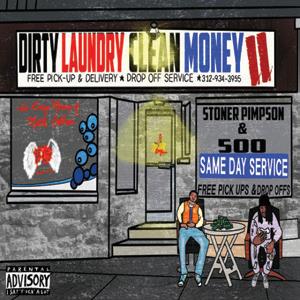
Griffin
On this collaborative release, Stoner Pimpson and 500 rap with flows that glide over sample-heavy instrumentals like stones skipping across a placid Lake Michigan. Pimpson’s resonant voice plays well off 500’s dry groan, and their performances provide Dirty Laundry, Clean Money II with its major source of energy. The upbeat chipmunk soul of “Not a Love Song” can power up any playlist in need of a boost.


Honorable mentions
Anna Mieke
Tannahill Weavers
Mommy

DECEMBER 22, 2022 - CHICAGO READER 47
MUSIC 1/18 Chinese Lunar New Year Concert 1/25 Chicago International Salsa Congress • Kickoff Celebration feat. Carpacho y Su Super Combo 2/1 Adam Zanolini Black History Month Concert 2/8 Breabach 2/15 Chicago Latin Brass Ensemble 2/22 Cecilia Zabala 3/1 Wanees Zarour • Buzuq Works 3/8 International Women's Day Celebration • feat. Patricia Ortega 3/15 Harley Figueroa 3/22 Sona Jobarteh 3/29 Yves Francois & Rocambu Jazz CD Release Party WORLD MUSIC WEDNESDAY SERIES FREE WEEKLY CONCERTS, LINCOLN SQUARE OLDTOWNSCHOOL.ORG 4544 N LINCOLN AVENUE, CHICAGO IL OLDTOWNSCHOOL.ORG • 773.728.6000 WEDNESDAY, JANUARY 11 8PM Tamikrest World Music Wednesday • In Maurer Hall FRIDAY, JANUARY 13 8PM SUNDAY, JANUARY 15 7PM Judy Collins In Maurer Hall SATURDAY, JANUARY 14 8PM Sons of the Never Wrong In Maurer Hall THURSDAY, JANUARY 26 8PM FRIDAY, JANUARY 27 8PM
with special guest Parker Millsap In Maurer Hall THURSDAY, FEBRUARY 2 7PM Phil Cook In Szold Hall FRIDAY, FEBRUARY 10 8PM
Is Missing is jokey and juvenile, with a goofiness that edges
Patty
In Maurer Hall
FEBRUARY 11 8PM
SATURDAY,
In Szold Hall SATURDAY, FEBRUARY 18 8PM The Cactus Blossoms/ Jon Langford In Maurer Hall SATURDAY, MARCH 4 5PM & 8PM Lúnasa In Maurer Hall UPCOMING CONCERTS AT
GLASS,
BOOMAN FOREVER, And Then Boom JOE
Slither OUTPASTMIDNIGHT, Teenage Bullshit
PARIS•YE, Flourish SPIKE CARTER, After Everything @imLeor
Scent and sound
Ten favorite perfumes of 2022 paired with ten favorite albums
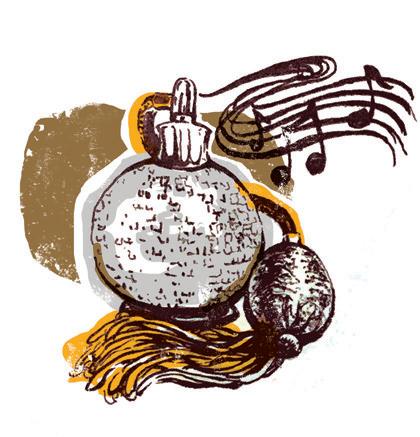 By JOSHUA MINSOO KIM
By JOSHUA MINSOO KIM

e ort to be flashy about its extravagance, and its decorum and high quality are obvious in more subtle ways: its pillowy soft atmosphere is graceful, and its smoothness is seductive. Jürg Frey’s lieues d’ombres (elsewhere) features solo piano works that the Swiss compos-
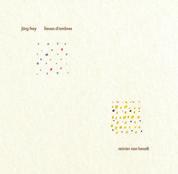
It’s been seven years since my group of intrepid friends decided to explore the world of perfumes. “If you take five minutes to research them,” my friend Sam explained, “you’ll find that they’re way more interesting and complex than you ever realized.” He was right, and before long, I bought a handful of perfume samples online, purchased a book to help guide my understanding of the art form, and regularly visited department stores to smell as much as possible. My curiosity couldn’t be sated, and just as I’d spent most of my life searching for life-changing music, I would be on a similar unending journey to discover fragrances I could cherish forever. A meaningful facet of perfumes is that they interact with your skin chemistry, which means they can smell different from person to person. Thinking about this has been hugely influential to how I approach all art and art criticism, as I now recognize how there is an infinitude to what any work can be and mean. That’s been especially obvious as I’ve started doing perfume-album pairings, which involves finding a perfume to wear as I listen to an album on repeat. Each time I do so, I learn something new about the music that I wouldn’t have noticed otherwise. It makes sense on a favorite basic level: I’m approaching both works with more intention and involving more of my senses for a more full-bodied experience. Importantly, this practice has helped keep my love for perfume and music alive. To give a glimpse into what I do daily, find ten of my favorite perfumes of 2022 below, each paired with an album I loved hearing while wearing them.
Zoologist’s entire shtick is naming perfumes after a di erent animal, and Cow is one of the more playful creations they’ve had. Perfumer Nathalie Feisthauer ensures that it mostly smells like a glass of cold milk, but there’s a candy apple note here that recalls kids’ shampoos. It’s a curious mix, but Cow still reads as sweet, powdery, and refreshing throughout its lifespan. Given how shamelessly synthetic it is, I’ve had a blast wearing Cow during listens of Uyama Amane’s Mumuto (self-released), a charming pop album indebted to the late Sophie’s erratic productions. These songs are silly and spacious, led by Amane’s soft vocals to ensure lightheartedness despite eruptions of elastic synths and industrial thwacks. Together, Cow and Mumuto remind you that outré art can be both bewildering and fun.


9. Papillon’s Hera and Jürg Frey, lieues d’ombres
Papillon’s Hera is the most classic perfume on this list, delivering a radiant blend of orris, narcissus, jasmine, and heliotrope. It’s powdery and creamy and most of all regal, befitting the most classic of ballrooms. It makes no


er made between 1984 and 2018, and they’re performed by Reinier van Houdt here with the most delicate touch. Listening to this music isn’t just calming and meditative—it forces one to trace the contours of every single note and chord, their interactions with each other, and the silence that accompanies them. This is the sort of record that helps one garner an appreciation for sound at its rudimentary level, and when I hear it alongside Hera, it feels like I’m rediscovering the beauty of white florals all over again.
8. Areej Le Doré’s Civet de Nuit and Cash Cobain and Chow Lee’s 2 Slizzy 2 Sexy (deluxe edition)

Sometimes the most exciting thing you can do is hear an album that feels absolutely incompatible with a perfume you’re wearing. This year, my favorite such dissonance came from combining two masterful collaborations: Areej Le Doré’s Civet de Nuit, a refined, animalic fragrance from Russian Adam and Sultan Pasha, and the deluxe edition of 2 Slizzy 2 Sexy (Neva
pected moments of playfulness, like the Plain White T’s sample on “Hate U Delilah” or the lay Spanish on “Hornitos.” Put on Civet de Nuit and 2 Slizzy 2 Sexy, and you’re guaranteed a good time or at least a laugh.
7. Jorum’s Firewater and Artificial Brain’s Artificial Brain

Slippin/MHPG Sound/CashCobain Inc.), an outrageous sex-romp party album from New York rappers Cash Cobain and Chow Lee. For how seemingly at odds these two works are, there is something that feels right: Civet de Nuit has a surprising chocolate note that adds sweetness without overpowering its resinous, musky base. 2 Slizzy 2 Sexy has similarly unex-
Both Jorum’s Firewater and Artificial Brain’s self-titled LP (Profound Lore) ferociously burst out the gate. The former, which is inspired by the Corryvreckan whirlpool o the west coast of Scotland, has the semblance of intense bonfire smoke meant to leave your head spinning. Its punishing opening makes way for something beautiful, though: a mix of benzoin and citrus to sweeten the BBQ-ish atmosphere. For how intense it begins, Firewater concludes with an earthy, dry down that’s mostly burnt woods: refined, warm, and cozy. Artificial Brain, a phenomenal album from one of the best American death metal bands today, feels like the sort of record that those uninterested in the genre could still enjoy. While it’s blistering and immense, there are moments of supreme beauty found in melodic passages and the incorporation of black metal ri age. More than anything, its unrelenting tenor can feel a lot like witnessing the sheer, hypnotic beauty of fire burning a landscape.
6. Marissa Zappas’s Ching Shih and Steffi’s The Red Hunter Marissa Zappas’s most creative fragrance this
48 CHICAGO READER - DECEMBER 22, 2022 ll
MUSIC
CAPORALE
MICCO
10. Zoologist’s Cow and Uyama Amane, Mumuto
year was Ching Shih, a beguiling shape-shifter inspired by the titular Chinese pirate. Its blend of myrrh and incense is grounded by a gunpowder note that tamps down any cloying sweetness one would find in a fragrance with such spice blends. The lack of a prominent amber note is key; Ching Shih is instead super moody, able to approximate the sharpness of a gunpowder’s sulfur ingredient without forgoing smoky comforts. Even when it settles, it maintains a faint air of dark, brooding mystique. I felt most at home wearing this alongside Ste ’s The Red Hunter (Candy Mountain). In a year with multiple killer electro LPs, Ste ’s is the most heady and austere, wielding futuristic synth pads and elastic beats with sly confidence. Her songs tumble and morph and glide, and their headstrong propulsions match Ching Shih’s addictive elusiveness.
5. Pineward’s Hayride and Brakence’s hypochondriac

Nicholas Nilsson’s Pineward Perfumes is one of the most thrilling independent ventures in the perfume world right now. His love of conifers belies the range of his many natural


it’s slipshod in its blending while other times I’ve felt it become an irresistible tapestry of natural scents. You take the good with the bad, much like with Brakence’s striking third album hypochondriac (Columbia). Here, the Gen Z producer pulls from various beat scenes from the early 2010s, folds in traces of IDM, and shoots it through a contemporary midwest, emo lens. It’s brash and heartfelt and guaranteed to make you feel uneasy all before winning you over.

Dusita’s
fragrances. (Those familiar with Slumberhouse’s cult classic Norne should take note.)
Case in point: Hayride, a perfume he released in October that’s based around hay, bison grass, and sweetgrass. To be perfectly clear, this barnyard hay note—fecal qualities and all—brutally hit the nose right from the jump, but it becomes increasingly evocative as you feel it interact with everything else, which includes vanilla, nutmeg, cardamom, hot cocoa, and raisins, which seems responsible for the juiciness I sense. Still, Hayride is a perfume with great variability. During some wears,
Pissara Umavijani looked to 1920s France for inspiration when making La Rhapsodie Noire, a stunning gourmand-ish fougère aiming for “timeless elegance.” There’s a prominent lavender note here, but it’s surrounded by a cloud of rum, co ee, and caramelized sugar. The sweetness is never one-dimensional because it’s accompanied by a heavy booziness, though any food associations one has shoot straight to images of the most royal banquets. Umavijani’s perfumes have always been adept at making you feel extraordinary in this way— like you deserve to feel spectacular—without opting for ostentatious pomp. La Rhapsodie Noire comes closest to crossing that line, but it remains lovingly introspective. When it eventually dries down into a soft vanilla, it carries the delight of the morning after a party, like you’re relishing the memories of what just happened, smiling in bed, covered in the softest blankets. Xênia França’s Em Nome da Estrela (self-released), a mesmerizing and artsy R&B album from Brazil, feels just as lavish. Like La Rhapsodie Noire, these tracks unravel slowly, and their glistening synths gild every inviting atmosphere. Put either of these on to feel like the best version of yourself.
3. Di Ser’s Hikaru Daichi and Kabza De Small’s KOA II Part 1
There’s an elegance and endearing clarity with which Di Ser and amapiano both operate. The former is a Japanese perfume house whose
commitment to all-natural fragrances has made them a cult favorite; their works are typically unobtrusive and light. The latter is a strain of South African house music that features synthesized log-drum loops and soaring vocals. Like many other albums in the genre, Kabza De Small’s KOA II Part 1 (Piano Hub) is long (over two hours!) and filled to the brim with guest features, but these qualities aren’t meant to be intimidating. Instead, this is the sort of music whose warm atmospheres are so addictive that the music could last forever, be it for dancing or relaxing at home. Even the darker moments—a result of Bacardi house’s


raw tobacco, and they’re exquisitely blended to maintain a thick and sumptuous atmosphere for an impressively long time. It smells delicious without being obnoxiously fruit-forward, allowing woods, smoke, and patchouli to weave in and out seamlessly. My experience with wearing this recalled listening to the newly remastered version of ’77 Live (Temporal Drift), the landmark album from Japanese psych-rock band Les Rallizes Dénudés. The recording is shockingly clear, making it easier to appreciate this noise-rock classic: the scuzzy guitars and blown-out bass are still delightfully raucous, but you get a larger appreciation for the pop inclinations that underlined all their works. These are masterful highlights from two uncompromising artists.
1. Agar Aura’s Malinau and Feli Colina’s El Valle Encantado
influence on the style—are mesmerizing instead of buzzkills. Think of Di Ser’s Hikaru Daichi as straddling a similar line between deep comfort and ephemerality. It begins with a spritz of bright lime before settling into a melange of pine, vetiver, and oakmoss. It’s earthy and lemony, containing wisps of frankincense to round everything out. Intermittently, it registers as medicinal. I’ve been spending time with these two during the colder months— their contemplative, impressionistic, and cozy nature makes me feel alive when faced with bracing winds.


2. Slumberhouse’s Kiste 2022 and Les Rallizes Dénudés’s ’77 Live (Remastered)
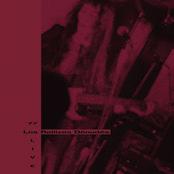

Slumberhouse’s Kiste has been an all-timer for me since I first wore it. After perfumer Josh Lobb recently hinted that it may never come back due to material scarcity, it’s returned with a tweaked formulation that’s better than the original. The perfume, which is Slumberhouse’s most accessible, is a gorgeous blend of boozy peach, musky leather, sweet honey, and

The perfume I wore most this year was Agar Aura’s Malinau, a pepper-forward “agarwood soliflore” whose materials were sourced from Borneo, an island in the Malay Archipelago. Perfumer Taha Syed captures both the cinnamon and vanilla notes that arise when extracting oil from this agarwood, and the perfume aptly wavers between di erent modes: one that’s a blast of cinnamon and one that’s more subdued and creamy, allowing hints of berry and vanilla to dot the woodiness. It’s supremely wearable compared to most ouds of this sort, and its warm spiciness gives it a homey, earthy feel akin to Feli Colina’s El Valle Encantado (Popart). With this third album, the Argentinian artist strives for a folk record that’s both ambitious and elemental. Most arresting is how the simplest of musical gestures—steady percussion, winding piano melodies, Colina’s breath— diffuse throughout each song, their beauty patiently unfolding measure by measure. Few albums or perfumes this year felt like I was witnessing something so far removed from artifice.v

DECEMBER 22, 2022 - CHICAGO READER 49 COURTESY THE ARTIST
4.
La Rhapsodie Noire and Xênia França’s Em Nome da Estrela
@misterminsoo MUSIC
MUSIC
40 years 40 years
in review
Metro and Smart Bar had a big birthday in 2022. Owner Joe Shanahan shares some of his favorite memories from the venerable Chicago clubs.
As told to STEVE KRAKOW
Peaches performs at Metro on August 21, 2022, during her COVID-delayed tour celebrating the 20th anniversary of The Teaches of Peaches . She also had a memorable Metro gig in 2009 that very literally spilled into Smart Bar a erward.
LAURIE FANELLI
Joe Shanahan founded sister venues Metro and Smart Bar in 1982, inspired by the adventurous punk and no wave he’d seen in the late 70s at New York venues such as the Mudd Club and CBGB. Shanahan was in his 20s at the time, but the Wrigleyville building his venues occupied had been built in 1927—it began its life as a Swedish community center, and when Shanahan arrived on the scene it housed Stages Music Hall. (In its final year, Stages booked the likes of E Street Band saxophonist Clarence Clemons and Gang of Four.) Cabaret Metro, as it was called in its early days, soon became a pinnacle to which local underground bands aspired, and Smart Bar pushed the dance-music envelope from the start.
Smart Bar reopened in June 2021 after a long COVID-19 shutdown, and Metro followed in July with a series of Lollapalooza aftershows. Metallica played a surprise concert at Metro in September of that year, the band’s only appearance there since a 1983 stop on
their first major tour. Both venues have been celebrating their 40th anniversary in 2022 with various special events, including a September Metro show by Smashing Pumpkins— one of many bands whose careers Shanahan helped shape that’s since grown way too big for an 1,100-capacity hall. In July the whole building hosted a two-day birthday party with the likes of the Blessed Madonna, Derrick Carter, and Ariel Zetina.

After Metro and Smart Bar grew into fixtures on the local scene, Shanahan became co-owner of the original Double Door, which opened in the heart of Wicker Park in 1994, when the neighborhood was happening. That club closed in 2017, but Shanahan still had his hands more than full—in 2012 he’d acquired the Gman Tavern, just north of the 3730 N. Clark building that houses Metro. In 2017 he helped launch the Chicago Independent Venue League, whose membership includes more than 60 performing- arts spaces. Initially it focused on arguing for the economic and cul-
tural value of local independent clubs, because the city was proposing lavish giveaways to multinational concert giant Live Nation as part of the Lincoln Yards megadevelopment. In 2020, though, CIVL quickly pivoted to advocating for government relief for venues during mandatory pandemic closures.
I was lucky enough to schedule an in-person audience with Shanahan to talk about Metro and Smart Bar’s history. He’s one of the most influential people in the history of the Chicago music scene, and few have as many tales to tell. Some things no gracious host repeats about his guests, of course, but he told me about the shows that have been most important to him, some of his venues’ wildest concerts, and even the quiet moments where the the audience collectively decided that rapturous, transcendent attention was more appropriate than clapping and hollering. Our interview has been edited for length and clarity.
—STEVE KRAKOW
50 CHICAGO READER - DECEMBER 22, 2022 ll
The first band I booked [at Metro] was R.E.M. [on July 25, 1982]. I’d seen them at the Danceteria in New York City and basically passed my card to the guy who was driving the van. Then we got the call that they were looking for a show. They were one of those bands that I was just like, “Oh, everyone should be paying attention to this.” But the club was half full.
The air conditioning went out for New Order [on June 30, 1983]. It was like 105 degrees. Equipment melted, computers began to fail, and songs needed to be reconfigured. It was still the most riveted crowd—people got in their real estate. It was one of those shows that was just as crowded as I’ve ever seen the club. It was hard to turn people away, because everybody wanted in. It was at full capacity. People were asking me, “I’ll just stand in the hallway. To listen.” And we did. We let some people just stand in the hall. Jim Nash, the owner of Wax Trax!, said to me the next day, “I think I lost five pounds last night. Because I sweated so much.”
Anyone that was at Metallica [on August 12, 1983] knew that this was going to be one of the biggest bands in the world. Everyone came out of that just mind blown, it was so visceral. There was like a warm haze through the room, but it wasn’t warm out.
When James Brown played Metro [on September 9, 1984], a friend had a film camera, and he came backstage and we were hanging out, and he was taking pictures. At one point he took a photo of James, and out of nowhere James was like, “Give me that film.” He took the film out of the camera, took it out of the canister, and burned it in an ashtray. I was like, OK, that’s some voodoo shit—you don’t mess with James Brown. And this was a day that was super playful.
He was still the hardest-working man in show business. And his band admired him for his work ethic. It was old-school with him. He wouldn’t let me feed the band until after the show, which I thought was very peculiar.
I believe the translation of Einstürzende Neubauten is “collapsing [new] buildings,” and collapsing was kind of what the show [on June 13, 1986] was like. I remember that there were power tools involved, and large oil drums, and really loud crashing—like throwing an anvil in a dustbin and rattling it around. [Front man] Blixa [Bargeld] had already come through with Nick Cave, so he kind of knew the room a bit. As far as fire hazards, I think they played it pretty safe. I do remember sparks in the air, from either the saw or the power tools.
Top: WXRT recorded Iggy Pop’s Metro show on July 12, 1988, and it’s been released on vinyl and CD. He’s pictured here at Metro in April 1996.
Bottom le : Liz Phair onstage at Metro on September 18, 1993, eight months before the concert Joe Shanahan recalls here

Bottom right: Depeche Mode at Stages Music Hall, which would soon become Cabaret Metro, on May 10, 1982
 BY PAUL NATKIN
BY PAUL NATKIN
I had gone to see a show of theirs in New York City at the Palladium, where they actually did light these pans of gasoline on fire. The entire building had to be evacuated. They took it easy in Chicago.
Iggy Pop [on July 12, 1988] was exciting because he tried to lift the side fills [onstage monitor speakers] and throw them into the audience. For a skinny fucker, he picked those things off the floor! They were strapped together, so I think they were just too heavy. Eventually he was like, “OK.”
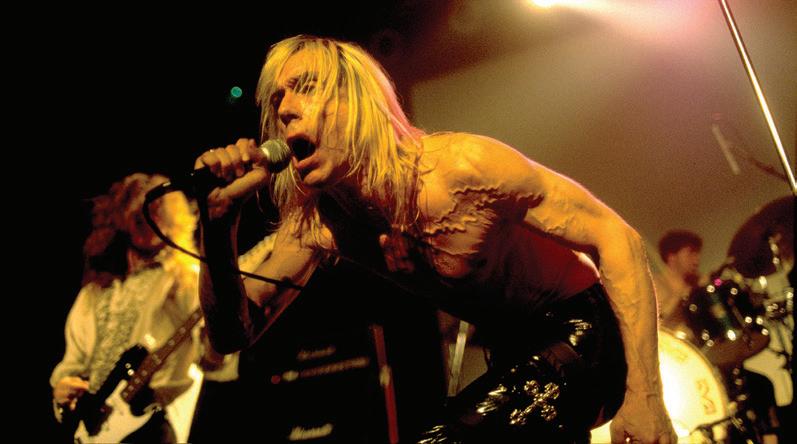
Iggy had gotten sober. I came backstage just to check on him. I called him James as well, Mr.
Osterberg, which he got a kick out of. I said, “Do you need anything? Do you want some champagne, you know, something?” And he said, “No, I’ve been God’s garbage can long enough.” So he may have thought I was asking if he needed drugs, but I never did that. That wasn’t my game anyway.
When Pearl Jam played at Metro [on July 21, 1991], Eddie Vedder climbed the lighting truss. I’m watching this guy, and he’s kind of hanging with one arm. I’m more concerned about, is the lighting truss going to be able to hold up? I knew that he was agile enough! U2 were in the balcony there—they had come to
see Pearl Jam, because they were considering them for their European tour. They got the tour.
My Bloody Valentine [on February 14 and 15, 1992] was so loud that people were begging the bartenders for napkins so they could put them in their ears. It was one of the loudest shows I’ve ever heard. I mean, I think the dB meter was up to about 120 on that one. But you weren’t telling Kevin Shields to turn it down. They just kept going.
[On May 15, 1994], Liz Phair is at the zenith of the Chicago scene. Everybody wants to be at this show. The phone never stopped ringing
DECEMBER 22, 2022 - CHICAGO READER 51
ALL PHOTOS
MUSIC
MUSIC
continued from p. 51
to get Liz Phair tickets. For me—because she’d performed at Metro before and I’d seen her at Lounge Ax—it’s when she got comfortable being onstage. She was in her skin. Liz Phair, Veruca Salt, and Freakwater—all women. Was it groundbreaking? Was it important? Ninetyfour. Clinton. Rock for Choice. All women, playing Metro, selling it out. The spotlight is on Chicago, because [Liz] has brought it here. The world is looking at Metro and looking at Chicago as the epicenter of a new rock scene. Liz was experiencing a little bit of stage fright, though, so we had to give her a nice glass of scotch.
I’ve never heard the room as quiet as when Je Buckley played [on May 13, 1995]. I actually went to the bartenders—this is when we had the old cash registers that would go dingding-ding —and I told them all, work from the drawer, but do not push the bell. Because this is gonna happen. And it happened, and it was religious, it was spiritual. It really was something very special—and it is out there, actually, it’s been recorded. It became a documentary piece for the record company.

For Metro’s 15th anniversary, we had Bob Dylan [on December 13 and 14, 1997]. It was really exciting. I knew how important it was, and I wanted to make sure that everybody was on their complete A game. We had come up with a way to foil the scalpers—because we knew it was going to be a big scalper
show. So we sold each ticket individually, and one of the things we did with the line was we would just talk to people. We were giving them doughnuts and coffee, because the line went all the way around Metro onto Racine all the way to Addison. It ended up being two shows, so we had 2,200 tickets to sell, and there were probably 4,000 people in line. Some of the scalpers were putting young kids in line, and they were giving them hot dogs from the stand across the street. So we would approach a group and say, “So, what’s your favorite Bob Dylan song?” And all these Dylan fans are looking at these guys, who are like, “Uh, Sgt. Pepper’s , man.” We were trying to just make sure the Dylan fans got the tickets.
We ended up really filling the room. People were coming from New York and LA. [Dylan] had the smallest hands I have ever shook. They’re beautiful hands.
We had the Flaming Lips [on December 31, 2000]. The Lips used so much confetti and so much Silly String that literally it was up over your ankles in the club. It took us a month to get everything out, and I still think, 20 years later, there’s some in there somewhere. Wayne [Coyne] used these tiny little dots, and it was everywhere. It was like snowing, for like an hour. When [the news crew] went to the talking head, the fans were putting Silly String in the guy’s face for like five minutes. He was just covered, like it was a hairdo.
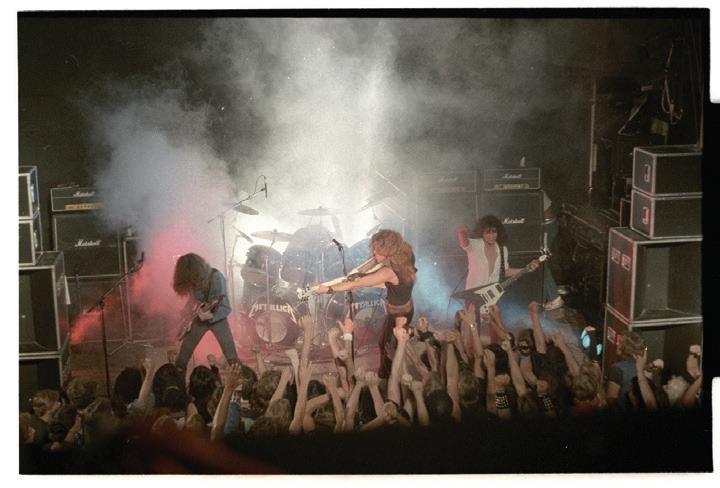
[On January 26, 2008], Girl Talk literally led everybody out of the club into the street. You did like a lap on Clark and then back into the club. I love the fact that there was this sort of playful leadership, but not coercing—just saying, “Hey, let’s go! We’re going outside with this one!” It was in the moment, and people were having fun with it and making that happen.
Peaches, after selling out Metro [on May 22, 2009], went down to Smart Bar. She got on top of the DJ rig and was popping bottles of champagne. She was shaking it—she thought she was at the Grand Prix. There were a couple of them going and spraying everywhere. You can’t get champagne on turntables or CDJs, but she was going for it. It didn’t matter to her. She was having a blast. I remember losing control of the booth, because it was just like—she just said, “This is what I’m doing.”
Derrick Carter is synonymous with Smart Bar as far as some of the biggest party nights, the biggest fun, hands-in-the-air kind of moments. Marea [Stamper], the Blessed Madonna, as well. Honey Dijon. These DJs have lived and breathed this city and are part of something that is as big as Metro and Smart Bar, as far as the dance community and dance culture. You always know it’s a good night in Smart Bar when you go down there and you find clothes—people just left clothes. I mean, like, shirts and underwear—somebody had a really good time!
[On August 6, 2011], Dave Grohl left the stage [with Foo Fighters] and walked the balcony—the edge of the balcony. He had a radio pack. His security guy was terrified, and I was personally terrified, standing with their manager, John Silva. We’re just looking, going, “Oh . . . oh, wait a second.” There’s this really famous photograph [from that night] where Dave is over this table, just playing to the people at the table. And one of those people happened to be my wife. I mean, suppose if he would have fallen, people would’ve caught him—there’s enough people underneath. But I just don’t know if I want Dave Grohl falling. Someone’s gonna get hurt. It’s gonna leave a mark, as they say.
The Chance the Rapper show [on July 31, 2016] was wild. I remember he came and grabbed several hundred tickets, then went to the south side and passed them out on a street corner. Michelle and Barack’s daughter came to the show. We had the drug- and bombsni ng dogs through the club all day. This is a first for me! Then [Malia Obama] shows up, and she’s with these secret service guys. For some reason, they all thought it’d be cool if they wore Hawaiian shirts—they’d just blend in with the crowd, right? Well, just the opposite. Everyone was like, oh, that’s the secret service—these six-foot-four muscle-bound guys with earpieces, standing around the president’s daughter.
[When I took over the building], it was
52 CHICAGO READER - DECEMBER 22, 2022 ll
Metallica play at Metro on August 12, 1983, during their fi rst major tour. GENE AMBO
Dave Grohl of Foo Fighters at Metro, date unknown GENE AMBO
MUSIC

in such bad shape. I mean, there were some rooms—there’d be, like, a flood. All of a sudden there’d be water pouring out of a wall. So we’d break the wall open, and you’d see that someone had just taken duct tape around a pipe, and that’s the way they’d fixed things. And then they sealed it back up and crossed their fingers.
We actually had a joke about the water goddess—that there was a river underneath
beginning.

I lived in the building for about a year. We had two cats that would keep the rats away. No one had taken care of it—it wasn’t being loved as it is now. And I slept with a gun underneath my pillow. I don’t even think they called it Wrigleyville yet. The one thing about the building was that there was always somebody in it. So I’d take the money to the bank with the security team, then go back and go to bed. We
Metro that on certain days, it would rise, and it would fill the Smart Bar and you’d be dancing in, like, an inch or two of water. Hence, the beginning of why sawdust would go down on the floor.
[Smart Bar] was on the fourth floor originally, the most untouched space in the building. That was the home of early Victory Gardens [Theater]. At one time, I believe the New Criminals were a theater group that was up there. And that was John Cusack and Jeremy Piven. They used to do Sam Shepard plays on the weekends. That was kind of part of our early Smart Bar—we’re morphing out of, you know, just the dance club. And Metro was just
never left the building unattended. Because of the heat, the air conditioning, the plumbing, the electrical—you just didn’t want to leave it! Something could go wrong, and then you’d have a show that day. You’ve got Depeche Mode coming in or New Order coming in or R.E.M. coming in, in the early days. And we were really concerned to make sure that things were always being taken care of.
We began to love that building because it was loving us and liked what we were doing in there. The spirit itself was telling us, and we kept giving it love. v
@Chicago_Reader

DECEMBER 22, 2022 - CHICAGO READER 53
Derrick Carter and Jojo Baby share a lollipop at Smart Bar, date unknown. ERIK MICHAEL KOMMER
Recommended and notable shows and releases with critics’ insights for the week
MUSIC
PICK OF THE WEEK
Doom Flower enrich their new album with trip-hop mystique

Thu 5, 8:30 PM, California Clipper, 1002 N. California, $5. 21+
WHILE CHICAGO INDIE SUPERGROUP Doom Flower were getting to work on their new second album, Limestone Ritual (Record Label), they hit a speedbump that would’ve killed a lesser band’s momentum. As Tribune critic Britt Julious reported in a November profile, drummer Areif SlessKitain couldn’t make it to the recording sessions, and because he’s such a cool, intuitive, in-the-pocket player (with a list of credits that includes the Eternals and Brokeback), he’s di cult if not impossible to replace. Front woman Jess Price (of Campdogzz) and bassist Bobby Burg (Love of Everything, Joan of Arc) made the best of the situation by lifting drum tracks from a breakbeat record, which gives Limestone Ritual a distinct trip-hop e ervescence. Matt Lemke (Wedding Dress) embellishes the spartan sampled percussion with svelte synths that give the songs a futuristic lounge mystique. Limestone Ritual doesn’t have a single focal point—the interplay between Price’s tendrils of guitar and Burg’s resonant, minimal bass is as engrossing as Price’s half-mumbled singing. The sublime, easygoing guitar melody of “Break Cycle” exudes a sleepy optimism, which is exactly the tone I’d like to see for the music of 2023. —LEOR GALIL
CONCERT PREVIEWS WEDNESDAY21
Hamid Drake & Michael Zerang winter solstice duos See also Thu 12/22 and Fri 12/23. 6 AM, Links Hall, 3111 N. Western, $35. b
Hamid Drake & Michael Zerang winter solstice evening concerts See also Thu 12/22. First set, Zerang solo (the Velvet Bell) and with the Velvet Bell Ensemble (Kioto Aoki, Tyler Damon, and Janet Bean). Second set, Drake with Indigenous Mind (Expanse), aka Lisa Alvarado, Zahra Glenda Baker, Shanta Nurullah, Joshua Abrams, and Jason Adasiewicz. 8 PM, Constellation, 3111 N. Western, $20. 18+
The end of the year is a time for traditions that affirm social and spiritual priorities, and one of Chicago’s most enduring annual rituals comes from its music community. Since 1990, local percussionists Hamid Drake and Michael Zerang have convened at Links Hall to perform a concert that celebrates the season but doesn’t align with any single faith. Each year on the winter solstice, the duo and their audience gather before sunrise in a space lit only by candles. Drawing upon their knowledge of world drumming traditions as well as from the improvised music that they perform in other settings, Drake and Zerang play until sunlight streams in through the windows, and then pause for a moment of silence. With their frankly ceremonial aspects, the concerts acknowledge the cross-cultural significance of the end of the year, signaling farewells and renewal, but they also afford an opportunity to hear two of Chicago’s greatest percussionists sharing the essence of their art.
While no two solstice concerts are alike, they all immerse listeners in a spontaneous manifestation of intricate polyrhythms and overwhelming sound. The number of sunrise concerts varies from year to year, and this month they’ll occur on three mornings, from December 21 till 23. On two of those evenings, Drake and Zerang will gather in Constellation for concerts that present their new and ongoing projects. On Wednesday, Drake will play with Indigenous Mind (Expanse), a six-member ensemble that presents spiritual jazz and multidisciplinary performance in the vein of Don Cherry’s Organic Music Theatre and Alice Coltrane. Zerang will perform solo and introduce the Velvet Bell Ensemble, his quartet featuring Kioto Aoki, Tyler Damon, and Janet Bean; they’ll play new music he’s devised for large bells. On Thursday, the percussionists will colead the Solstice After Hours Large Ensemble, a ten-piece band that includes some of their new friends as well as their most enduring. —BILL MEYER
THURSDAY22
Hamid Drake &
winter solstice duos See Wed 12/21. 6 AM, Links Hall, 3111 N. Western, $35. b
54 CHICAGO READER - DECEMBER 22, 2022 ll
Michael Zerang
Hamid Drake & Michael Zerang winter solstice evening concerts See Wed
DOOM FLOWER, CHRIS SUTTER (MEAT WAVE), DEEPDOG DJS (MEMBERS OF DEEPER)
December 22
of
b ALL AGES F
COLLIN BUNTING
12/21. Solstice A er Hours Large Ensemble with Drake, Zerang, Jeb Bishop, Zahra Glenda Baker, Molly Jones, Ed Wilkerson Jr., Ben LaMar Gay, Mark Feldman, Johanna Brock, Kent Kessler, and Mabel Kwan. 8 PM, Constellation, 3111 N. Western, $20. 18+
FRIDAY23
Hamid Drake & Michael Zerang winter solstice duos See Wed 12/21. Dawn duo concert: 6 AM, Links Hall, 3111 N. Western, $35. b


THURSDAY29
Bonelang See also Fri 12/30. Aaron Day and friends open. 8 PM, Schubas, 3159 N. Southport, $20 in advance, two-day passes sold out. 18+
Chicago alternative hip-hop group Bonelang seem to want to make hip-hop that sounds like anything but hip-hop. The core duo, MC Samy.Language and producer-vocalist Matt Bones, both split the difference between rapping and singing—they often enunciate their pristine, staccato verses like they’re delivering a solo in choir or talk-singing in a Broadway musical. They also embellish their complex beats with percussion flourishes—vibraphone, hand claps, marching-band drums—fit for a symphonic indie-rock album. Bonelang temper this creative audacity with urbane polish, so that even when an idea doesn’t quite hit the mark they at least sound good trying to make it work. Their chutzpah comes through clearly on May’s self-released Nervous Oracle EP, which opens with an appearance from former G-Unit rapper the Game; Bonelang catalyze a strange joy by combining his grizzled voice with their twisted Beach Boys harmonizing on the hook for “Gluten-Free Gluttony,” though the rest of the song doesn’t always clear that very high bar. Bonelang sometimes get distracted by silly wordplay, which is bound to happen with a group more interested in sound than sense, but their songwriting always has a profound emotional core. Even as they dazzle you with bold stylistic acrobatics, they don’t forget what it’s all for. The bittersweet, cinematic “Sleepy Lion” demonstrates this directly, stripping away the ostentatious touches so you can feel the heartbeat in their music.
—LEOR GALIL
Outronaut The Nubile Thangs headline. 8 PM, Beat Kitchen, 2100 W. Belmont, $12. 21+
Outronaut bandleader and guitarist Steve Gerlach probably reaches more ears as a sideman than he does with his own outfit. For nearly a decade he’s played in Sons of the Silent Age, Matt Walker and Chris Connelly’s nine-member David Bowie tribute group; that gig got Gerlach work on Connelly’s solo material. In a 2021 interview with It’s Psychedelic Baby Magazine , he unpacked his impressive resumé, which includes collaborations with John Cale and Tommy Keene—opportunities that came his way because he’d earned the respect of so many other musicians. “Needless to say, there are no job applications,” he said. “Not much money changes
hands anyway.” But the music Gerlach makes with Outronaut deserves to be widely heard too. Their trippy, proggy, mostly instrumental surf-rock songs would make a fine score for a big-screen western, though I’m hard-pressed to think of a film director who could match the cosmic scope and cheeky rambunctiousness of their most recent release, the August EP Godfinger. The thundering psych of “Poison Hero” could fill a canyon, but it should go down at least as well on the Beat Kitchen’s modest stage. —LEOR GALIL
FRIDAY30
Bonelang See Thu 12/29. Kweku Collins and Carlile open. 9 PM, Schubas, 3159 N. Southport, $20 in advance, two-day passes sold out. 18+
SATURDAY31
Natural Information Society, the Separatist Party 9 PM, Constellation, 3111 N. Western, $25. 18+
Constellation hasn’t hosted a New Year’s Eve bash since the Sun Ra Arkestra’s legendary fete in 2017. This year, the intimate venue ushers in 2023 with homegrown talents who could be considered Constellation all-stars. The evening is headlined by Natural Information Society, led by multi-instrumentalist Joshua Abrams; the five-piece ensemble realizes his teeming compositions (o en prominently featuring the bandleader on guimbri, a Gnawa three-string bass lute) against a backdrop of largescale paintings by harmonium player and visual
artist Lisa Alvarado. Natural Information Society are joined on the bill by the Separatist Party, a newer band that combines two local trios: synth magicians Bitchin Bajas (Cooper Crain, Rob Frye, and Dan Quinlivan) and a recurring unit comprising vocalist Marvin Tate, multi-instrumentalist Ben LaMar Gay, and drummer and composer Mike Reed (who also runs Constellation). The sites of cross-pollination between these musicians are too numerous to list, but to name two for your preshow listening pleasure: NIS and Bitchin Bajas put out the yearning, mystical Automaginary together in 2015, and Gay played cornet and Wurlitzer on Frye’s Exoplanet, one of my favorite albums of 2021. The same year, the Bajas threw it back to Constellation’s previous NYE headliners with Switched on Ra, a joyous synth retooling of Arkestra standards. New Year’s Eve might come just once a year, but the good vibes coming out of this show will surely have no expiration date —HANNAH
EDGAR
FRIDAY5
Doom Flower See pick of the week, page 54. Chris Sutter (Meat Wave) and the Deepdogs DJs (members of Deeper) open. 8:30 PM, California Clipper, 1002 N. California, $5. 21+
SATURDAY6
VOlcandra Amiensus, Toxic Ruin, Pulchra Morte, and Flesher open. 8 PM, Reggies Music Joint, 2105 S. State, $15. 21+
Louisville melodic black-metal quintet Volcandra announced their arrival in style in the winter of 2020 with a striking debut, Into the Azure . Brimming with versatility and creative energy, the record blended some of the best elements of Scandinavian and American black metal with a progressive lightness of being that gave a certain radiance to their tales of epic fantasy battles. Their timing wasn’t the best, of course, but they kept their hand in the game, and later that year they gave us a holiday present in the form of a December single—a brooding cover of Opeth’s “Demon of the Fall.”
In May, Volcandra announced that they’d signed to Prosthetic Records, and in June they released a four-song EP, Border World. A lockdown baby, the EP celebrates an art form that saved many people’s sanity in those long, isolated days: video games.
Opener “Tallon IV” is an homage to Metroid , and the EP’s title is inspired by Half-Life, as is its cornerstone track and first single, “Resonance Cascade.”
In an interview with Echoes and Dust, front man Dave Palenske says that Volcandra want to provide an escape for fans—and here they show that the key to escapism is less about understanding what your audience is escaping from and more about what they want to escape to.
“Resonance Cascade” is a gripping quest that plunges you into the protagonist’s point of view. It features a guest solo by guitarist Mike Low of Nashville metal outfit Inferi, and its winsome guitar heroics and martial surges cascade into thrash and speed metal. “Colossi” is more harsh and raw, with respites when a fighter can catch their breath few and far between—the breakdown around the

DECEMBER 22, 2022 - CHICAGO READER 55
MUSIC
Hamid Drake PAWEL OWCZARCZYK
Volcandra SHAUN CHRISTOPHER
Michael Zerang COURTESY THE ARTIST
MUSIC
three-minute mark would be sweet if it didn’t offer false relief. “Guardian” closes out the EP on a heroic note with a beautiful guitar solo and a hopeful, aspirational vibe.
You don’t have to be a gamer (I’m not) to relate to Volcandra’s strong sense of narrative, but those who are might find this music even harder to resist— especially given the obvious joy the band took in making the video for “Resonance Cascade,” which also includes Mike Low. Volcandra did a short, scattershot U.S. tour this fall, but this will be their first Chicago show. —MONICA
KENDRICK
SUNDAY7
Royal Thunder 8 PM, Cobra Lounge, 235 N. Ashland, $17. 17+
For many of us, the early days of the pandemic meant lost time and opportunities, but for Royal Thunder, that long, lonely period sparked a rebirth. Formed in 2004, the Atlanta band had made a name for themselves with a mix of heavy psych, bluesy hard rock, prog, and more—but they’d split up just before COVID gut-punched the States. In the months that followed, vocalist and bassist Mlny Parsonz and guitarist Josh Weaver reconnected with the band’s original drummer, Evan Diprima, and reconvened as a trio. “We decided to get the band back together and do things right,” Parsonz told me over email. “It was a huge void in our lives, and we really missed our family Royal Thunder and the outlet it provided all of us.” The process of rebuilding the band from the ground up helped inspire a wealth of new material, including the new single “The Knife,” their first release since the 2017 album Wick. The thundering rock banger draws on a 90s alt-rock sensibility, an influence the band credits to having come of age during the early part of that decade. (In the same email, Weaver recalled that hearing “Smells Like Teen Spirit” for the first time as a 12-year-old skate punk inspired him to go home and pick up the guitar he’d received as a Christmas present years before.) Parsonz makes this compact three-and-a-half minute nugget feel vulnerable and personal with her powerhouse vocals, though its themes—confronting the ways we subconsciously sabotage ourselves, tapping into inner strength to fight for something better—are universally relatable. Though the band have been elusive about whether they’ll release a full album in the new year, they’ve dropped hints that they’ve got fun stuff in the works. So anyone who makes it out to this show at Cobra Lounge—part of a three-city jaunt—might just be treated to a preview of what Royal Thunder have in store for us as they rise from their own ashes.
—JAMIE LUDWIG
ALBUM REVIEWS
Chris Connelly, Eulogy to Christa: A Tribute to the music and mystique of Nico Shipwrecked Industries chrisconnelly.bandcamp.com/album/eulogy-tochrista
Chicago singer-songwriter Chris Connelly regularly releases an album of new material on his November birthday. For his latest record, Eulogy to Christa: A Tribute to the Music and Mystique of Nico, he hit that annual deadline with the digital version on Bandcamp, but the physical edition (a deluxe double CD) didn’t ship till early December. Connelly originally planned the project to be a covers album of songs by Nico, the German model, singer, and composer (born Christa Päffgen in 1938) who’s best known, albeit unjustly, for her brief stint fronting the Velvet Underground in 1966 and ’67. But Connelly was inspired instead to write a song cycle based on Nico’s life a er reading You Are Beautiful and You Are Alone, a 2021 Nico biography by rock historian Jennifer Otter Bickerdike (who titled the book a er a lyric from Nico’s “Alone” and contributed liner notes to the CD version of the album). The subjects he addresses include the teenage Nico’s claim that she was raped by a U.S. air force sergeant, her impressive roster of love affairs, and her struggles to be taken seriously as an artist.
Thirteen tracks on Eulogy to Christa are by Connelly, while eight are at least in part by Nico. Connelly is particularly well-suited to take on this material. His David Bowie tribute project, Sons of the Silent Age, has included guest stars portraying Lou Reed, Iggy Pop, and other key figures of the late-60s and early 70s proto-punk scene. Reed is a character in Eulogy for Christa too, and he’s not always cast in a favorable light. “Andy, Incidentally” and “Union Square West” evoke the Velvet Underground, and “A Slow Jones in New York” emphasizes Reed’s cruelty, like a dark mirror of Reed and John Cale’s 1990 record Songs for Drella with 90 percent less hagiography. But Connelly’s take on Nico is hagiographic in its own way—most notably, it glosses over her history of racism, including an alleged violent attack on a Black woman at the Chelsea Hotel in the early 70s.
Connelly’s greatest strength here lies in how he handles the traumas that informed Nico’s life. “I Cannot Care for You” is about parental absence, including the death of her father, the illness of her mother, and her own yearslong struggle to play a role in raising her son, Ari, who was never acknowledged by his father, French actor Alain Delon (though he was mostly raised by Delon’s parents). Other tracks touch on Nico’s struggles with addiction and poverty: “80s Beat Boys” is a melancholy snapshot from her Brixton period that’s evocative of her fight to survive, while “The Black Rooms of Richelieu” is a dark, hallucinatory tale of drugfueled desperation in Paris.
Connelly’s stylistic shi s between episodes and personae are masterful, but what really makes this album outstanding is the kindness, even tenderness, that he shows his subject. The album’s compassion comes through especially strongly when it touches on her later career and the life she’d tried to build in Brixton and Manchester before her untimely (and likely preventable) 1988 death due to a brain hemorrhage caused by a cycling accident. “Fa Massa Calor” (“It’s Too Hot”), for instance, foreshadows the extreme heat of the day, which may have played a role in her demise. But perhaps Connelly’s greatest tributes to Nico are his many covers of her haunting, distinctive songs (“Frozen Warnings,”
“The Falconer,” and “Valley of the Kings” are standouts), which underscore why her work remains vital decades a er her death. —MONICA KENDRICK
Crosses, Permanent.Radiant Warner crossescult.com/collections/media
If you love the Deftones as much as I do, you’ve undoubtedly passionately defended them to a nu-metal naysayer. “They’re not really nu-metal,” you might argue. “Sure, they had some rap parts on their first record, but they’ve actually spent most of their career leaning into dream-pop and shoegaze influences.” (I can’t be the only person out there going to bat for the band on a fairly regular basis, can I?) Deftones front man Chino Moreno has been open about his love of classic shoegaze, goth, and dream pop since the band broke out in the mid90s, and they’ve pushed those elements further and further to the forefront of their alt-metal with each release. Over the years, Moreno has also used various side projects (including the trip-hoppy Team Sleep and his collaboration with former members of Isis, Palms) to explore his fascination with these styles. But he straight-up dives into them with Crosses, his mostly electronic duo with former Far guitarist Shaun Lopez. They’ve been putting out slick, catchy, industrial-tinged dream pop and witch house since 2011, and their love for those dreary, mysterious sounds runs so deep that last year they released a cover of Q Lazzarus’s dark synth-pop classic, “Goodbye Horses.” On their brand-new EP, Permanent.Radiant , gorgeous tracks of slick, airy synths and cloudy soundscapes serve as a foundation for Moreno’s signature yearning croon. These songs are deep, heavy, and beyond smooth; if your favorite parts of Deftones records are the sweet spots, then you definitely shouldn’t miss this release.
 —LUCA CIMARUSTI
—LUCA CIMARUSTI
Foule Monk & Davis, PLum Whisky
Why? Records
dorchesterbully.bandcamp.com/track/depressionera-deutschmarks
Davis the Dorchester Bully isn’t rapping too fast— you’re listening too slow. As the Chicagoan says on “Virginia,” a track from his new album with Detroit producer Foule Monk, “Life is as simple as it seems.” And so are his rhymes, even when he serves them up with moments of head-whipping banter.
That collaborative album is called Plum Whisky, and it’s Davis’s second release this year, following May’s four-part single Portrait (Why? Records). It’s a quick listen; its tracks are fast, sturdy, and memorable.
Given Monk’s many collaborations with up-and-coming artists, including Defcee and Jackie Scan, it seems he’s able to create quality tracks at warp speed—and that’s a good thing. He places samples knowingly, and his work carries on the tradition of producers who weave thick layers of texture and meaning, such as Madlib and Alchemist.
Monk mostly plays exploratory and whimsical, deliberately building on foundational samples that often make it sound like a background vocalist is sharing the track with Davis. This keeps things interesting across 13 songs; the buried samples have you listening closer to hear their deeper significance and alignment with Davis’s lyrics. The album’s lone guest is Chicago rapper and Why? cofounder Joshua Virtue, who pops up with imaginative quips and quotables on two features, including a fabulous verse on “Astroblack.” (Davis and Virtue are former roommates who also make delightful music as Udababy.)
The record is peppered with Monk’s instrumentals, which could easily stand on their own, but here they add greatly to a densely satisfying ride, painting in coats of jazz and gospel where you least expect them. The album ends with the infamous “I drink your milkshake!” line from There Will Be Blood, capping off the project with a braggadocious chef’s kiss. People who find honesty and poetry in the mundane bits of life will surely enjoy Plum Whisky
—CRISTALLE BOWEN
Gomorra, Dealer of Souls
Noble Demon
gomorraband.bandcamp.com/album/dealer-ofsouls
As soon as you see the ridiculous “Iron Maiden meets fantasy novel with skulls” cover art for Dealer of Souls (Noble Demon) and hear the demi-classical opening, you know what Gomorra have to offer. And these German metalheads do not disappoint.
Guitarists Damir Eskic and Dominic Blum blast out adrenaline-pumping, assault-by-lightning thrash riffs, while drummer Stefan Hösli sets the pace
56 CHICAGO READER - DECEMBER 22, 2022 ll
Crosses JONATHAN WEINER
Find more music listings at chicagoreader.com/musicreviews
continued from p. 55
somewhere between “fast” and “absolutely ludicrous.” Vocalist Jonas Ambühl alternates between a gravelly bottom and a Rob Halford-style heaven-scraping operatic challenge to the gods. The hooks are exuberantly bombastic, as are the harmonies, and Ambühl belts his way through the Sturm und Drang so ferociously that you can just about ignore his vague messages of self-help uplift: “A chance for the better / You know it’s all right,” from “A Chance for the Better,” won’t make anyone’s list of greatest all-time metal couplets. Neither will “You are my light / I’m lost in darkness,” from “Lost in Darkness.” But perversely, the lyrical flabbiness only makes that track an even more perfectly overwrought power ballad, ideal for headbanging and giggling as a single tear rolls down your face. Dealer of Souls is trashy, heartfelt, and more than a little glorious. Prepare to raise your lighters knowing that these guys love the heavy brontosaurs of metal past at least as much as you do.
 —NOAH BERLATSKY
—NOAH BERLATSKY
Harvey Mandel, Who’s Calling Tompkins Square

tompkinssquare.bandcamp.com/album/whoscalling




Harvey “the Snake” Mandel is a guitarist’s guitarist. Born in Detroit in 1945 and raised in Morton Grove, he moved to the west coast in his early 20s to launch his career. He never became a household name like Stevie Ray Vaughan or Eric Crapton, but beginning with his debut LP, 1968’s funky fuzz classic Christo Redentor , his eclectic, seismic take on electric blues earned him the admiration of his peers—and it’s made fans of generations of musicians to come. Boogie legends Canned Heat recruited him in 1969 (his third show with them was at Woodstock), and in the mid-70s the Rolling Stones auditioned him as a replacement for Mick Taylor. (He later appeared as a session musician on the Stones’ underrated 1976 LP, Black and Blue .)
Mandel was also tapped to play with rock and blues greats such as John Mayall, Charlie Musselwhite, and Love—and speaking of “tapping,” he helped popularize that two-handed fretboard technique among rock musicians. It features prominently on his 1973 fusion LP, Shangrenade , and he famously inspired Eddie Van Halen.

I’m happy to report that on Mandel’s new 16th album, Who’s Calling (his second on Tompkins Square), his adeptly amplified sound is alive and well. The first heavily distorted ax notes on opening cut “Last Rites” display his classic sizzling tone and the sinuous pitch bending that helped earn him his nickname. The rhythm section is sympathetically laid-back and funky, giving Mandel room to spread out and display his six-string fireworks. Drummer Ryan Jewell, who also coproduces, has played with underground musicians such as Ryley Walker and Laraaji as well as on Mandel’s excellent 2016 comeback, Snake Pit. On Who’s Calling he expertly works the skins on the polyrhythmic, danceable “Moon Talk” and “Lucky Sevens,” while Mandel blazes away with delay-treated psychedelic shredding that aims for the heavens. Bassist Andy Hess (formerly of Gov’t Mule and the Black Crowes) is no slouch either, holding down the slinky, dirty shuffle groove of the title track while Harvey’s unearthly sustain cascades over the top. The mutant blues sounds of “See You Around” and “Love You Forever” exhibit Mandel’s ability to subject that primordial music to guitargasmic new transmogrifications. Who’s Calling is an astonishing and fresh-sounding album from the 77-years-young guitarist, who beat long odds just to record it—he’s been fighting a recurring battle with cancer for a decade, and like basically every other musician in the world, he’s had to work around the dangers and lockdowns of the COVID pandemic. These past few years have taken way too many of my musical heroes, so I’m happy I can celebrate the fact that Mandel is still rocking with the best of them—and still releasing vibrantly mind-bending new music. —STEVE
KRAKOW v
DECEMBER 22, 2022 - CHICAGO READER 57 Go morra COURTESY THE ARTIST MUSIC SAT JAN 28 MAGIC CITY HIPPIES + CAPYAC 3730 N CLARK ST METROCHICAGO.COM @METROCHICAGO SMARTBARCHICAGO.COM 3730 N CLARK ST | 21+ SUNDAY JAN 01 NEW YEAR'S DAY QUEEN! SUNDAY JAN 08 In Metro GARRETT'S BIRTHDAY QUEEN! SUNDAY JAN 15 In Metro FKF, Queen!, Metro + smartbar present FOR FRANKIE! FRIDAY DEC 30 Obscure + Format welcome DRUMCELL DJ HYPERACTIVE LOWKI LAST NIGHT A DJ SAVED MY LIFE PLAID @ SLEEPING VILLAGE QUEEN! EPEX ILE WHITE REAPER JAN 27 JAN 28 JAN 29 FEB 09 MAR 08 MAR 12 Laid Back | Cold Beer | Live Music @GMANTAVERN GMANTAVERN.COM 3740 N CLARK ST 21+ SATURDAY DEC 31 / 9PM / 21+ METRO, SMARTBAR & QUEEN! PRESENT A 40 TH ANNIVERSARY CELEBRATION RUBY JUBILEE NEW YEARS EVE ft. smartbar friends + residents FRIDAY JAN 06 / 8PM / ALL AGES A METRO 40 TH ANNIVERSARY CELEBRATION WALTZER MINOR MOON BURR OAK SUNDAY JAN 08 / 10PM / 21+ GARRETT’S BIRTHDAY QUEEN! ft. Queen! residents, guest dj Huerta, guest host Tenderoni SUNDAY JAN 22 / 10PM / 21+ QUEEN! ft. Queen! residents + guest host Chanel Mercedez Benz SUNDAY JAN 15 / 10PM / 21+ FKF, QUEEN!, METRO & SMARTBAR PRESENT FOR FRANKIE! A celebration of his life with proceeds benefi ing the Frankie Knuckles Foundation THU MAR 02 JUNIOR BOYS + Hagop Tchaparian SUN FEB 26 RIOT FEST WELCOMES BAYSIDE + I Am The Avalanche + Koyo WED FEB 15 OBSESSED PRESENTS ADORE DELANO Party Your World Tour
EARLY WARNINGS
Rockin’ Robin Memorial Show featuring Glory Days, Ghoul for a Goblin, Kevin Andrew, and more 1/21/2023, 8 PM, Gman Tavern
Daniel Rodriguez 5/10/2023, 8:30 PM, FitzGerald’s, Berwyn Scarlet Demore, Demo Division, Crystal Killers 2/1/2023, 9 PM, Sleeping Village Shwayze, Of Good Nature, Wide Eyed Kids 3/31/2023, 8 PM, Beat Kitchen, 17+ Shygirl 3/31/2023-4/1-2023, 9 PM, Thalia Hall, 17+ Slink Moss Explosion, Joel Paterson Trio 1/28/2023, 8:30 PM, FitzGerald’s, Berwyn Sloppy Boys, Dear Blanca 4/8/2023, 8 PM, Beat Kitchen, 17+
Soulside, J. Robbins 3/15/2023, 8 PM, Sleeping Village
Southern Culture on the Skids 5/24/2023, 8 PM, SPACE, Evanston b
NEW
Airiel, Pink Frost, Panda Riot
3/2/2023, 8:30 PM, Sleeping Village
Algiers 3/30/2023, 9 PM, Sleeping Village
G. Thomas Allen Quintet 2/2/2023, 8 PM, City Winery b
Andi 4/4/2023, 8 PM, Beat Kitchen, 17+
Anthony David 2/5/2023, 8 PM, City Winery b Arab Blues 2/11/2023, 9 PM, Hungry Brain
Joshua Bassett 3/18/2023, 7:30 PM, House of Blues b Bendigo Fletcher 4/20/2023, 8 PM, Schubas, 18+
Tab Benoit, JD Simo 2/25/2023, 8 PM, North Shore Center for the Performing Arts, Skokie b Black Flag 4/14/2023, 7 PM, Avondale Music Hall b Andrea Bocelli 5/20/2023, 8 PM, Allstate Arena, Rosemont b Stella Bossi 2/24/2023, 10 PM, Prysm Nightclub
Sarah Clausen & Erez Dessel, Tyler Damon & Jacob Fawcett 3/9/2023, 8:30 PM, Elastic b
Crystal Casino Band 5/6/2023, 9 PM, Schubas, 18+
Kabir Dalawari Quartet 3/24/2023, 9 PM, Hungry Brain
Darlingside 3/16/2023, 7:30 PM, North Shore Center for the Performing Arts, Skokie b
Daydream Review, Roof Dogs, Smooth Rogers 1/27/2023, 10 PM, Empty Bottle
Dear Silas 2/24/2023, 8 PM, the Promontory Corey Dennison Band 1/13/2023, 8:30 PM, FitzGerald’s, Berwyn
Drumcode featuring Adam Beyer, Juliet Fox, Kölsch, Layton Ciordani 2/24/2023, 10 PM, Radius Chicago, 18+ Brian Dunne 5/7/2023, 7:30 PM, Schubas, 18+ Sheena Easton, Taylor Dayne 2/11/2023, 7 PM, Des Plaines Theatre, Des Plaines b
Flatfoot 56, Rumjacks 3/11/2023, 8 PM, Reggies Rock Club, 17+
Mark Guiliana 3/31/2023, 7 and 9:30 PM, Constellation, 18+
Lalah Hathaway 2/16/20232/27/2023, 7 and 10:30 PM; 2/28/2023, 6 and 9:30 PM, City Winery b
Will Hoge 4/15/2023, 8 PM, SPACE, Evanston b
Miki Howard & Glenn Jones 1/30/2023-1/31/2023, 8 PM, City Winery b
Robbie Hunsinger Group 3/23/2023, 8:30 PM, Elastic b
Jadu Heart 2/3/2023, 9 PM, Sleeping Village
Christian JaLon & the C.J.’s 2/22/2023, 8 PM, the Promontory b
James Hype, Jakeshoredrive 2/4/2023, 10 PM, Radius Chicago, 18+
K. Michelle 3/11/2023, 9 PM, the Vic, 18+
Theo Katzman 5/13/2023, 8:30 PM, the Vic, 18+
Khemmis, Conjurer, Wake 4/28/2023, 7:30 PM, Reggies Rock Club, 17+
Kimbra, Tei Shi 2/22/2023, 8:30 PM, Thalia Hall, 17+

Last Night a DJ Saved My Life featuring Mike Servito b2b Hiroko Yamamura, Lauren Flax b2b DJ Heather, Justin Cudmore b2b Shaun J. Wright 1/27/2023, 10 PM, Smart Bar
Latrice Royale 5/6/20235/7/2023, 8 PM, Lincoln Hall, 18+
Lost Kings 2/17/2023, 10 PM, Concord Music Hall, 18+ Marauda, Jessica Audiffred, Versa, Drinkurwater, Algo 2/4/2023, 10 PM, Concord Music Hall, 18+
Christian McBride’s New Jawn 3/23/2023, 7:30 and 9:30 PM, Constellation, 18+
Cass McCombs 1/18/2023, 7:30 PM, Thalia Hall, 17+ Meduza 1/21/2023, 10 PM, Radius Chicago, 18+ Messthetics, James Brandon Lewis Trio 3/15/2023, 8:30 PM, Constellation, 18+ Microwave, Oso Oso, Delta Sleep, Mothé 4/1/2023, 7 PM, Bottom Lounge b Mint Field 2/2/2023, 9 PM, Empty Bottle
Roscoe Mitchell Trio with Junius Paul and Vincent Davis 2/23/2023, 7 PM, the Promontory b
Mo Lowda & the Humble, Illiterate Light 4/22/2023, 9 PM, Lincoln Hall, 18+
Most Distant Object, Deep Tunnel Project 2/18/2023, 8:30 PM, Gman Tavern
Ne Obliviscaris, Beyond Creation, Persefone 11/7/2023, 7:30 PM, Bottom Lounge, 17+ Danielle Nicole Band 2/23/2023, 7:30 PM, Martyrs’ Lilly Palmer 2/17/2023, 10 PM, Prysm Nightclub Alice Peacock 4/27/2023, 8 PM, SPACE, Evanston b Reclaim the Stage Festival 2023 featuring Sunny War, Whitney Flynn, Volk, She/ Her/Hers, Tiger Sex, Run Rabbit Run, Flummox, Shitizen, and more 3/25/2023, 2 PM, Reggies Rock Club and Reggies Music Joint Tomeka Reid, nAngelica iescier, & Savannah Harris Trio 3/16/2023, 8:30 PM, Elastic b
SZA, Omar Apollo 2/22/2023, 8 PM, United Center b Tamino 4/26/2023, 8 PM, Thalia Hall, 17+
Tapestry Unraveled: the Music of Carole King featuring Tina Naponelli 1/27/20231/28/2023, 7:30 PM, Beverly Arts Center b Tiffany Day 3/24/2023, 6 PM, Subterranean b Tossers 3/17/2023, 8 PM, Metro, 18+ Trivecta 1/20/2023, 10 PM, Concord Music Hall, 18+ Jeff Tweedy 5/19/20235/20/2023, 8 PM, the Vic, 18+ Venus Club, Metalliques, Deep Fake 1/16/2023, 9 PM, Empty Bottle F
Wilde, Mila la Morena, North by North, Mid-American Elevator 1/14/2023, 9 PM, Empty Bottle
Winspear Review 2023 featuring Divino Niño, Video Age, Lutalo, Brenda’s Friend 2/11/2023, 8 PM, Thalia Hall, 17+
Winston Surfshirt 3/10/2023, 9 PM, Martyrs’, 18+
The World is a Beautiful Place & I am No Longer Afraid to Die, Worlds Greatest Dad, For Your Health 5/13/2023, 8 PM, Bottom Lounge b Zegema Beach Records Fest featuring Jeromes Dream, Sawtooth Grin, Gillian Carter, Blind Girls, Closet Witch, Euclid C Finder!, Vientre, Eyelet, Meth, Hawak, Massa Nera, Crowning, Malevich, Coma Regalia, Dreamwell, Mouthing, Rainmaking, Victor Shores, Venus Twins, and more 5/6/2023-5/7/2023, 5 PM, Subterranean, 17+ Lolo Zouaï 4/20/2023, 7 PM, Subterranean b ZZ Top, Lynyrd Skynyrd, Uncle Kracker 8/19/2023, 6:30 PM, Hollywood Casino Amphitheatre b
b ALL AGES F
Never miss a show again. Sign up for the newsletter at chicagoreader. com/early
UPDATED
Masego 3/24/2023, 8:30 PM, Salt Shed, venue changed, 18+ Walkmen 5/17/2023-5/20/2023, 7:30 PM, Metro, show added, 5/18-5/20 shows sold out, 18+
UPCOMING
Grace Bloom, Reggie Pearl, Sick Day 1/12/2023, 8 PM, Schubas F
Chicago Funk Mafia, Brick Smashley, Drew Delneky, Charlie Otto & His Gear 1/13/2023, 8 PM, Chop Shop
Chicago Philharmonic 1/14/2023, 7:30 PM, Harris Theater, Scott Speck, conductor, Sharon Isbin, guitar, Joshua Roman, cello (Dun, Moya) b DD Osama 1/13/2023, 8 PM, Avondale Music Hall b Dry Cleaning, Nourished by Time 1/13/2023, 8:30 PM, Thalia Hall, 17+
For Frankie! benefit for the Frankie Knuckles Foundation featuring Eric Kupper, Derrick Carter, Michael, Serafini, Garrett David, and more 1/15/2023, 9 PM, Metro French Police, Lesser Care, Muted Color 1/13/2023, 10 PM, Empty Bottle Future 1/20/2023, 7 PM, United Center b
Daniel Lamar & the Storytellers 1/22/2023, 2 PM, Museum of Contemporary Art Chicago b
Night Moves, Shady Cove 1/14/2023, 9 PM, Lincoln Hall, 18+
Noches Sin Ti release party featuring Mamicana, No Montana, Shego Turbo, Mila la Morena, Amira Jazeera, Sammicee 1/17/2023, 8 PM, Bourbon on Division
Oh My Lover, Cure for Pain 1/13/2023, 8 PM, Burlington DJ Shon Dervis 1/13/2023, 9 PM, the Whistler F Spread Joy, Wad, Brady 1/17/2023, 9 PM, Sleeping Village
Greg Taylor, Eleonore 1/27/2023, 7:30 PM, Uncommon Ground Lakeview b Tomberlin, Free Range [Tomorrow Never Knows] 1/18/2023, 7 PM, Schubas, 18+ Pat Mallinger Quartet 1/13/2023-1/14/2023, 8 PM, Green Mill v
GOSSIP WOLF
A furry ear to the ground of the local music scene
RAY DONATO OF LOCAL psych juggernaut Dark Fog is a paragon of relentless musical activity. A er a burst of releases in early 2019, Reader critic Monica Kendrick gently jo ked that his band makes “every other band on the planet look like slackers” by comparison. She wasn’t wrong! Gossip Wolf recently checked Dark Fog’s Bandcamp page, and sure enough, Donato is once again cranking out jams at a feverish pace, and every new track seems more delightfully weird than the one before. (He’s now recording and performing all the instruments and vocals himself, which has probably helped his strikingly singular vision more fully emerge.) On November’s self-released limited-edition colored vinyl LP Trap Psych , Donato bridges a deeply uncanny valley between trap music’s thudding beats and Auto-Tuned vocal stylings and epic Les Rallizes Dénudés splatter-psych meltdowns. This week he released the digital album 7734 NI, which o en relies on a more diffuse and ambient sound palette and occasionally coalesces into slightly menacing, kick-drum assisted tracks, including “Kill Me With Nostalgia.”
Year-in-review listicles may have you believe no one puts out music in December. But Gossip Wolf can’t overlook the rad debut Chicago two-piece Anita Hart dropped this month. On Black Lava Blood Floor, they use hardcore might to launch free-range postpunk toward the stars.
James Porter is a longtime Reader contributor who has freelanced for Downbeat and Roctober. He’s also a helluva harmonica player and vocalist. Porter fronts the James Dean Joint, a rootsy, soul-inflected garage fivesome that debuted onstage 11 months ago and dropped a rough andtumble EP in July called CabinBuzz—the honeyed vocal harmonies and Kevin Lee Redlin’s glowing keys on “Chatham Ain’t Chatham” are a knockout! On Wednesday, December 28, the James Dean Joint open for the Waco Brothers at Schubas ; the show starts at 8 PM, and tickets are $20.
—J.R. NELSON AND LEOR GALIL
Got a tip? Tweet @Gossip_Wolf or e-mail gossipwolf@chicagoreader.com.

58 CHICAGO READER - DECEMBER 22, 2022 ll
Kimbra COURTESY THE ARTIST
CHICAGO SHOWS YOU SHOULD KNOW ABOUT IN THE WEEKS TO COME
KEITH HERZIK
WOLF BY

DECEMBER 22, 2022 - CHICAGO READER 59 Chicago Reader: Getting into 2023 More than 60,000 copies will be available at nearly 1,200 locations across the city and suburbs. Find one near you and/or download the current issue: chicagoreader.com/map Upcoming Issues: ‘23 Municipal Elections insert Winter Theater/Arts Preview Municipal Elections coverage Windy City Times insert Spring Theater & Arts Best of Chicago Jan. 12, 2023 Jan. 26, 2023 Feb. 9, 2023 Feb. 23, 2023 Mar. 9, 2023 Mar. 23, 2023 Apr. 6, 2023
JOBS
TECHNICAL Cisco Systems, Inc. is accepting resumes for multiple positions in Chicago, IL: Customer Escalations Engineer (Ref#: CHI190A): Lead complex and critical network problems to resolution for customers. Telecommuting permitted. Technical Solutions Specialist (Ref#: CHI421A): Discover, manage, and close net-new deals in the market space for enterprise networking products. Telecommuting permitted. Technical Solutions Specialist (Ref#: CHI521A): Act as a trusted technology advisor to customers in planning, designing, and implementing wired or wireless network infrastructure, IT security, and/or management solutions. Telecommuting permitted. Technical Support Team Lead (Ref#: CHI171A): Assist and direct diagnosis and troubleshooting of wireless, security, switching, and other various network-related issues reported by customers and partners to Network Support Engineers (NSE). Telecommuting permitted. Please mail resumes with reference number to Cisco Systems, Inc., Attn: G51G, 170 W. Tasman Drive, Mail Stop: SJC 5/1/4, San Jose, CA 95134. No phone calls please. Must be legally authorized to work in the U.S. without sponsorship. EOE. www.cisco. com
(Bolingbrook, IL) Beko US Inc. seeks Tax Accounting Supervisor w/ Bach or for deg equiv in Bus, Finan, Acctg, Econ, Com or Math & 3 yrs exp in the job offered or in acctg. Must have exp w/funct tax acctg, SAP ERP; US GAAP; IFRS acctg frmwrk & sales & corp incme taxation. Apply to HR, 333 Gibraltar Dr, Bolingbrook, IL 60440 or online https:// apply.workable.com/ beko-us/
(St. Charles, IL) Nidec Mobility America Corp seeks Supplier Quality Engineer NPL/ Mechanical w/bach or for deg equiv in ME, IE or mfg eng & 1 yr exp in job offer or in qual or mfg eng. Also accepts mast & 6 mos exp. Must have Six Sigma/Cont Impr (Grn or Blk Belt, etc.) & use qual tools, such as Root Cause & Corr Act, Ctrl Plans, FMEA, SPC, DOE, & GR&R. Apply to HR, 3709 Ohio Ave, St. Charles, IL, 60174
MANUFACTURING
PROCESS SUPERVISOR - Power Plant Services in Melrose Park, IL seeks qualified Mfg Process Sprvr. Resp for supervising first-line production activities of Quality Assurance, Process Engineering, Plant Maintenance & Resource planning & implementation. Bachelor’s or foreign equivalent degree in Mechanical Engineering, Manufacturing Engineering, or in a closely related engineering field of study with at least 2 years of professional experience in: (i) reading and interpreting technical drawings, material and design specifications, material and process certifications, schematics, Geometric dimensioning and tolerancing (GD&T), tolerance analyses, tolerance stack-ups, and machine codes; (ii) gathering, maintaining, formatting, compiling, and manipulating technical data, including customer drawings and specifications, material test results, and engineering design changes; (iii) machining and manufacturing process capability of CNC machines; and (iv) using Enterprise Resource Planning (ERP) systems. 40 hrs/wk. Respond by mail: Power Plant Services, Attn: Maria Maddrill, 3131 W. Soffel Ave., Melrose Park, IL 60160. Refer to ad code: PPS-0722.
TECHNOLOGY ServiceNow, Inc. is accepting resumes for the following position in Chicago, IL: Senior Tech Support Engineer (5823-3285885): Gather information on the customized customer code such as actions performed, input, output and logic being used to process the data. Telecommuting permitted. Annual Salary: $134,616164,616. Email resume to servicenowresumesUS@ servicenow.com or mail resume to ServiceNow, Inc., Attn: Global Mobility, 2225 Lawson Lane, Santa Clara, CA 95054. Resume must include job title, job ref. #5823-3285885, full name, email, & mailing address. No phone calls. Must be legally-authorized to work in U.S. without sponsorship. EOE.
Project Engineer: Design and engineer custom elevator cabs and mechanical component parts. Chicago IL location. Send resume to: Cabworks Custom Elevators, Inc., 3100 N Tripp Ave, Chicago, IL, 60641, Attn: M. Waksmundzki.
Lead Consultant Developer (Professional Services) Thoughtworks seeks Lead Consultant Developer (Professional Services) to work in Chicago, IL & various unanticipated U.S. locations to lead largescale, custom-designed, enterprise-level software development projects that use object-oriented technologies, such as Java, Ruby, or .NET. Requires Bachelors in Computer Science, Computer or Electrical Engineering, Information Systems, or related field. Will accept a single degree or any combination of degrees, diplomas, professional credentials or professional experience determined to be equivalent by a qualified evaluation service. Requires 18 months exp. in the job offered, Consultant, Developer, or related IT position. Must have at least 18 mos. exp. (1) Participating at all stages of the software delivery life-cycle, including analysis, development, testing and deployment. Must have at least 12 mos. exp. (1) Using Agile development methodologies including Continuous Integration, Extreme Programming, Continuous Delivery, Test-Driven Development and pair programming; (2) Using test automation frameworks to test at different levels, including unit, functional and integration testing; (3) Developing software applications using Java, Ruby or .NET; (4) Serving as a liaison between client and development team to define scope and technical direction of the project including requirements gathering and design discussions and managing project deliverables and timeframes; and (5) Working on projects with distributed teams, including managing coordination across countries and time zones. At least 80% travel across U.S. Send resume to ijobs@ thoughtworks.com with Job ID LD-LCD2023.
Principal Engineer –Chicago – Develop, improve products & designs, analyze failures. Use SolidWorks to create models, drawings. Create manufac. layout diagrams, roll-out plans, timelines for product launch, systems to optimize productivity & standards. Minimize costs, maintain quality to achieve goals. Master’s Mech. Eng./related. Mail res., cov. let. to Diane Korach, Edsal, 4400 S. Packers Ave., Chicago, IL 60609
ABC Supply Corporation seeks Data Scientists (multiple positions) in Chicago, IL to gather requirements, data, and info and develop strategic approach to achieve project goals. Reqs. MS+2 or BS+5 yrs. exp. To apply mail resume to ABC Supply Corporation, Attn: Jennie Lindeman, 1 ABC Parkway, Beloit WI 53511. Must reference Job Title & Job Code: 000361.
SW Eng 3
Comcast Cable Comm, LLC, Chicago, IL. Contrib to team resp for create & maintain ad campaign mngmnt system; Reqs: Bach in CS, Eng or rltd; 2 yrs exp create SQL & .Net (C#, EF, & LINQ) code; use Jira, Github, Jenkins & AWS thru full dvlpmt lifecycle; dvlp front-end interface use JavaScript library; use Postman for API & integration test; & prfrm containerization use Docker & Kubernetes. Apply to: renu_puril@ comcast.com. Ref Job ID# 0849
Senior Software Engineer in Test 1: Chicago IL. Develop test plans, help write automated tests & integrate them into deployment pipeline. designing, developing, supporting platform, responsible for logic & messaging to helps run ecommerce fulfillment for thousands of businesses. Contribute to all phases of application development lifecycle. BSc/BA in Comp Science, Engineering or related field or as an alternative HS plus 2 yrs’ exp as software engineer in test incl exp in testing both frontend & backend features, working knowledge of SQL, test case creation, test case execution, agile software dvlpmt, VSTS Test Manager or similar. Res: ShipBob, Inc.; abeck@shipbob.com
Assistant Professor Loyola University Chicago is seeking an Assistant Professor in Chicago, IL to teach courses in normative political theory & the history of political thought, incl but not limited to an introductory course to Political Theory, upper-level undergraduate courses on topics such as Contemporary Political Thought, Democratic Theory, & Global Justice, &, on a rotating basis, graduate courses in political theory for masters & PhD students. Please send res to Agrigor@luc.edu & ref job 051184.
Associate Attorney (Real Estate, Affordable Housing) J.D. degree req’d. Min. 1 yr. exp. in full-time pos’n.(s) involving drafting reports & applications for submission to gov. bodies and/or agencies req’d. Active IL law license req’d. Katten Muchin Rosenman LLP, Chicago, IL. Katten Muchin Rosenman LLP is an Equal Opportunity Employer/ AA M/F/SO/Disability/ Veteran. Resumes to: Recruiting, Katten Muchin Rosenman LLP, 525 West Monroe Street, Chicago, Illinois 60661 or via email to HRRecruiting@katten. com.
DispatcherFT. Max Carriers Inc., Westmont IL. Annual salary: $34,100, High school diploma, no training, no exp. req\’d. Sent resume to maxcarriersmax@gmail. com
DSI Mechatronics Applications Engineer John Bean Technologies Corporation, Chicago, IL – DSI Mechatronics Applications Engineer: Rspnsbl for promte, educate, develp, & adapt DSI, vision-controlled waterjet cutting technlgy, into industrl food prodctn indstry. Req: BS or frgn equiv in Mechcl Engr or rltd fld. Must have knowldg thrgh crswrk of kinematics & kinetics theories; laws of kinetics, dynamics, & mchnics of materls for stress & defrmtion of membrs in torsion, tension, compression, bending, & design of these members. Travel up to 80% of time w/in US, remote work allowed 100%. Apply at: https:// careers-jbtc.icims.com Req ID: 2022-10006
Maintenance Manager (West Chicago, IL): Manage maintenance and asset care to maximize capacity and produce the highest quality product at the lowest cost. May be required to travel/ telecommute. Mail CV/ Cov ltr to: Giuliana Lumia: MAPEI Corporation, 530 Industrial Drive, West Chicago, IL, 60185. Ref code: G8867-00029
Senior Staff Accountant Newcastle Ltd. is seeking a Senior Staff Accountant in Chicago, IL. Prepare financial statements and bank reconciliations and oversee Accounts Receivable process and Accounts Payable for check processing. Must live within normal commuting distance of head office. May work from home 2030% of time. Apply online at newcastlelimited.com/ careers
Microsoft Dynamics NAV Developer (Bridgeview IL) Configure, develop & deliver MS Dynamics NAV software. Must have bachelor\’s in comp. sci, systems engin’g, rltd/equiv & 5 yrs progressive post-baccalaureate exp.1) as software developer w/ NAV & 2) ERP program’g exp. & hands on work w/ full life cycle implement C/ SIDE C/AL dev. language.
Remote wrk prmtd up to 3 dys/week. CV to MJ Holding Company, LLC, lryan@mjholding.com.
Technology Manager
The Reader is looking for someone who will be excited about using tech and apps to take our website, digital platforms, and tools to the next level. This position will build solutions to help meet the Chicago Reader and RICJ’s strategy and audience growth goals and transform the best ideas and designs into the best possible infrastructure. Our ideal candidate is able to talk to both the strategists and designers, and make their ideas for growth come to fruition. This individual must be creative and tenacious in working with support teams from WordPress (and other third-party software from all Chicago Reader departments) to help get things done to support our vision and goals. They will be nimble, working on SEO tactics with writers and editors one moment, and pivoting to troubleshoot Mailchimp and Salesforce integration issues in Development or Sales. They will ensure RICJ’s computer hardware, software, database management systems, and cloud-based servers are working properly, train staff on operating software, and oversee the installation of hardware and software. Read the rest of the job descriptiona and submit an application at https://chicagoreader. com/reader/careers/# technology-manager
RESEARCH

Have you had an unwanted sexual experience since age 18? Did you tell someone in your life about it who is also willing to participate?

Women ages 18+ who have someone else in their life they told about their experience also willing to participate will be paid to complete a confidential online research survey for the Women’s Dyadic Support Study. Contact Dr. Sarah Ullman of the University of Illinois at Chicago, Criminology, Law, & Justice Department at ForWomen@ uic.edu, 312-996-5508. Protocol #2021-0019.
PROFESSIONALS & SERVICES
CLEANING SERVICES
CHESTNUT ORGANIZING AND CLEANING SERVICES: especially for people who need an organizing service because of depression, elderly, physical or mental challenges or other causes for your home’s clutter, disorganization, dysfunction, etc. We can organize for the downsizing of your current possessions to more easily move into a smaller home. With your help, we can help to organize your move. We can organize and clean for the deceased in lieu of having the bereaved needing to do the preparation to sell or rent the deceased’s home. We are absolutely not judgmental; we’ve seen and done “worse” than your job assignment. With your help, can we please help you? Chestnut Cleaning Service: 312-332-5575. www. ChestnutCleaning.com
60 CHICAGO READER - DECEMBER 22, 2022 ll
SERVICES
Lip Service, Erotic Phone Chat. 24/7. Must be 21+. Credit/ Debit Cards Accepted. All Fetishes and Fantasies Are
Personal, Private and Discrete.
ADULT
Danielle’s
Welcomed.
773-935-4995
CLASSIFIEDS JOBS GENERAL REAL ESTATE RENTALS FOR SALE NON-RESIDENTIAL PROFESSIONALS & SERVICES CLEANING RESEARCH ADULT SERVICES WANT TO ADD A LISTING TO OUR CLASSIFIEDS? Email details to classified-ads@chicagoreader.com
SAVAGE LOVE
GETTING IT
Cuckolding is a journey, not a destination
Plus, cis gay dudes who think pussy is powerful and amazing.
By DAN SAVAGE
Q : When I first got engaged to my wife, I tried to ease into a conversation about cuckolding, but it went poorly. I tried to broach the subject by telling her monogamy wasn’t a requirement for me and she got upset. She thought I wanted to have sex with other women. I do not. I reassured her of that fact and dropped the subject, but she still doesn’t believe me. Whenever she’s feeling insecure, she brings up that conversation from five years ago. I don’t know you at all and this is anonymous, so I have no reason to lie: I do not want to have sex with women other than my wife. I want her to have sex with other men. I want to be her cuckold. I want her to cheat on me. I have seen some married men online who are living the life I dream about (if the stuff they post about being cuckolds is true). I get depressed knowing some men have what I want. How did they get it? How do I get it? Do I risk raising the subject of monogamy again?
—DIFFICULTIES RENEGOTIATING EXPECTATIONS
AROUND MONOGAMY
A : I got on Twitter—perhaps for the last time—to track down one of the guys you mentioned, DREAM, i.e., one of the guys living the life you dream about and posting the proof all over his social media accounts. His handle on Twitter is @CyclicCycle, DREAM, his wife’s handle is @Miss_On_Top. He managed to get what you want. So, how did he get it? And how can you?
“The short answer: With a lot of communication, litera-
ture, podcasts, and patience,” said Cycle.
Cycle was never a jealous person. If anything, he was the opposite of jealous. “Even before cuckolding was integrated into my mental lexicon,” said Cycle, “things like other guys hitting on my girlfriend or buying her drinks were huge turn-ons for me.”
Eventually Cycle met the woman who would become his wife, and while they enjoyed a varied and pretty kinky sex life, cuckolding wasn’t always a part of it. But when Cycle decided to broach the subject, DREAM, he was honest and direct— in other words, DREAM, he didn’t make the mistake you did. He didn’t speak about nonmonogamy generally, but about his emerging interest in cuckolding specifically. He didn’t ease into the conversation, he jumped in.
“Now, it wasn’t a massive stretch to get to cuckolding from our already kinky lifestyle,” said Cycle. “And while I think it helped that we approached the topic more from a kink perspective than a nonmonogamous perspective at first, even then we also didn’t go from zero to 60 in an instant.”
Zooming out . . .
When you look at the social media accounts of guys who are in successful cuckold relationships—when you beat off looking at their accounts— you need to remember that you’re seeing their most recent posts first. Meaning, you’re seeing where they arrived, DREAM, and not where they started.
Zooming in . . .
You brought up nonmonogamy, not cuckolding, and somehow thought your wife would take you from zero to
60, i.e., you thought your wife would hear you say “nonmonogamy” and instead of thinking what most people would when their partner broached the subject of nonmonogamy (“He wants to fuck other people!”), DREAM, you hoped your wife would either react so positively you felt you could pivot to your nonmonogamy-adjacent kink (“I want you to fuck other people!”) or even that she might leap to the opposite of the likeliest conclusion (“He wants me to fuck other people!?!”). And that is 1. not how it works and 2. not how you get what you want.
“I recall discussing with my wife that we could make up our own rules, and build our own à la carte dynamic,” said Cycle, “which made her feel much more comfortable. It also didn’t hurt that chastity was already part of our kink repertoire. We eventually progressed to a more traditional FLR/Cuckolding dynamic, but we allowed it time to develop organically.” (FLR = “female-led relationship.”)
Cycle’s wife had a lot of reservations about opening up their relationship, DREAM, even though they were only opening things up—per Cycle’s desires—on her side. So, they started out slow with a lot of fantasy play and dirty talk before moving on to low-stakes/ lighthearted/baby-step “first dates” with other men. Only after they both felt comfortable with the cuckold dynamic in theory did the move on to cuckolding—Cycle’s wife having sex with other men—in actual practice.
And it wasn’t just about what Cycle wanted for him-
self, DREAM, but about what Cycle wanted for his wife and, more importantly, about what his wife wanted for herself.
“When my wife and I first started dating I had already had significantly more partners,” said Cycle. “So, one of the most genuine things I wanted for my wife was for her to have more experiences with other partners. Suffice to say, cuckolding for us, is much more about fulfilling her wants, needs, and desires.”
EQUAL
cis gay dudes who think pussy is powerful and amazing and will happily make the comparison/ association themselves. The choice seems obvious to me.
NOT OF PUSSIES’

Q : Why—why, why, why—do young cis gay dudes insist on calling their assholes “cunts” and “pussies” these days? I heard you talking about this on your podcast. As a woman with an actual vagina, I find this incredibly offensive and want it to STOP. —YOUR ASSHOLES
A : Back when I was a young cis gay dude, YANOPE, most young cis gay dudes objected—vociferously—to any suggestion that their assholes resembled, in form or function, women’s pussies. And most didn’t want their assholes associated with female genitalia because they thought lady parts were disgusting and, even worse, they didn’t care who knew it. Now, young gay men are much better about vulvas and vaginas—some even fuck/date/marry other gay and bi men who have vulvas and vaginas—and they don’t care who knows it. So, what I’m basically saying here, YANOPE, is pick your poison: cis gay dudes who think pussy is icky and gross and will angrily reject any comparison/association or
P.S. It has been my experience—ahem—that younger gay men mostly do the thing you’re complaining about during sex. They don’t do it during Zoom meetings or when they’re having dinner with their lesbian pals. So, I don’t see how this impacts you. Even if it did, YANOPE, you can’t control what other people say during sex—with the exception of people you’re having sex with—and attempting to dictate terms is a waste of time. v
Send your burning questions to mailbox@savage.love. Podcasts, columns and more at Savage.Love!
@fakedansavage
DECEMBER 22, 2022 - CHICAGO READER 61



































62 CHICAGO READER - DECEMBER 22, 2022 ll the platform The Chicago Reader Guide to Business and Professional Services To advertise, e-mail ads@chicagoreader.com legal books Brigi e Schmidt Bell, P.C. 847-733-0933 lawyers@bsbpc.com Brigi eBell.com Brigi eSchmidtBellPC Considering Divorce? We Can Help. Collaborative | Prenuptual Divorce | Mediation mental health YOUR AD HERE 773-616-6969 1234/1250 S. Michigan Ave. In/out. Must call 8 am-9 pm. No annoying texts. European Relax Massage Licensed & Certified Cupping health & wellness What Greta said . . . shop local Outside Noise Reduction Keeps Bugs & Spiders Out Reduce or Eliminate Fog & Water Noise from Outside? Visit stormsnaps.com or noisewindows.com sales@stormsnaps.com Alpina Manufacturing, Chicago, IL 1-800-915-2828 Soundproofing Window Inserts home improvement Fun, Clean, Picture Frame assembly JOB $18/hour Tired or bored of clicking away on a keyboard working at home? Keep your hands and mind busy with a fun, safe, clean assembly job. You’d have your own large assembly zone, at least 15-20 feet away from others, so we’re really safe here. Top rated rm Alpina Manufacturing LLC founded in 1992 Beautiful campus in Galewood, near Mars candy, 3 blocks north of Oak Park. We build and sell display framing systems to customers nationwide including Wal-Mart, Verizon, Circle K gas stations, Hospitals. Full time, Part time, Flex hours for working parents or students. We train, no travel, work in Galewood. Open to any backgrounds. Excellent pay, friendly caring management. Stop in anytime between 7am and 4pm M-F ask for Izzy to apply and check us out. Alpina Manufacturing 6460 W Cortland St., Chicago, IL 60707 Customized Massage Therapy, Intuitive Energy Work, and Holistic Talk Therapy 2514 W Armitage Ave, Suite 211 Chicago, IL 60647 773-697-9278 www.intuithealing.com Open Thursday-Monday BY APPOINTMENT ONLY A Matter of Consequences by
Available on Amazon and Booklocker A
Mystery your heading here
Michael W. Falls
Classic Chicago
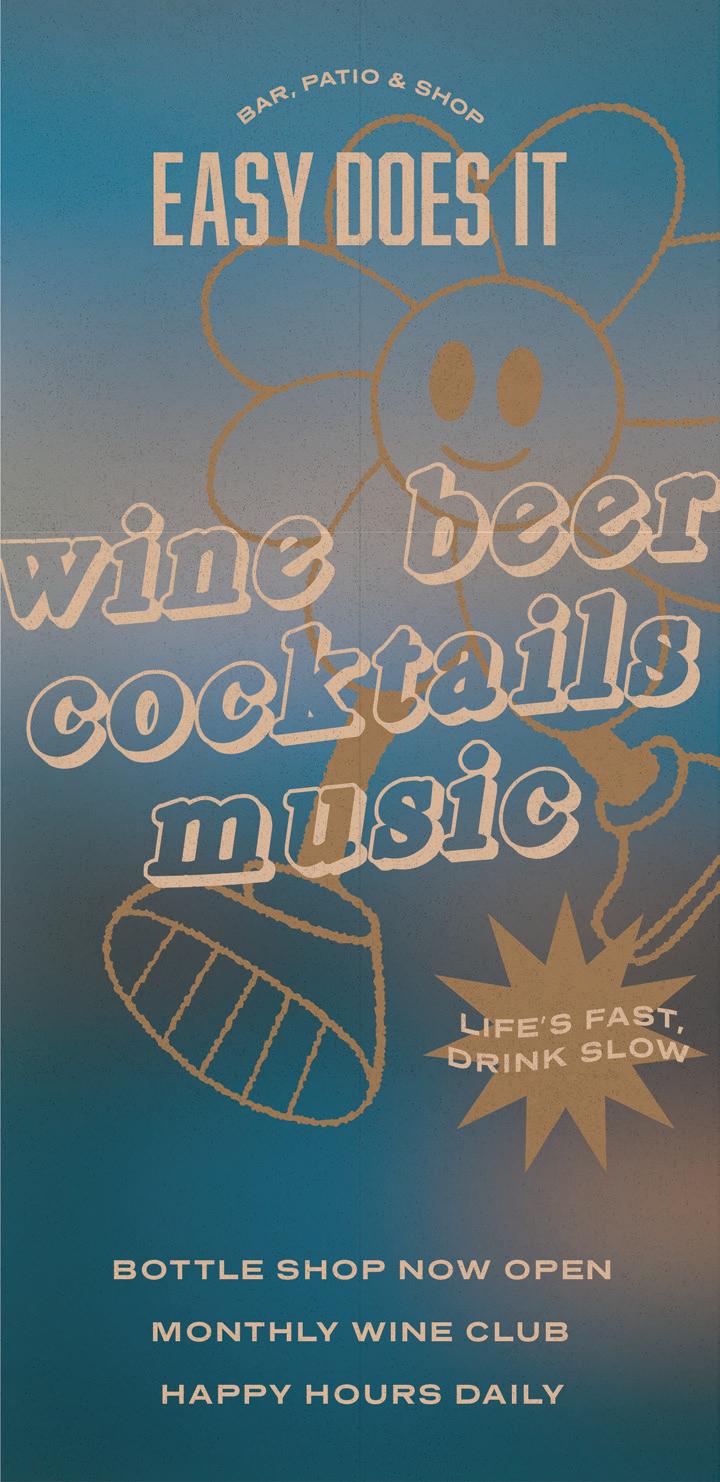





DECEMBER 22, 2022 - CHICAGO READER 63 12/ 31 @ beat kitchen 12/29 @ Subterranean 12/31 @ reggies 12/31 @ Fitzgerald’s Dos santos mustard plug the arrivals deeohgees Our best seller is a Ross-Simons exclusive, now in sterling silver. A fresh take on pearl earrings and a fancy spin on hoops. Also in black pearl. Item #924729 Shown larger for detail. ORDER TODAY! To receive this special price and free shipping use offer code: BEST319 1.800.556.7376 or visit ross-simons.com/best Item #918266 $59 Compare at $95 8-9mm Cultured Freshwater Pearl Hoop Earrings 333699_4.93_x_4.875.indd 1 12/13/22 10:52 AM









A passion for your profession is born here. You can help patients, work as a personal trainer, teach young students, and more. Malcolm X College’s accredited Nursing and Health Science & Career programs can help you get there. Financial support available Tuition-free opportunities for eligible students Apply now Nursing Program ccc.edu/MXNursing Health Science and Career Program ccc.edu/MXHealthScience








































 By DEBBIE-MARIE BROWN
By DEBBIE-MARIE BROWN
































 By BEN JORAVSKY
By BEN JORAVSKY























 By DEBBIE-MARIE BROWN
By DEBBIE-MARIE BROWN


























































 MICHAEL IZQUIERDO
MICHAEL IZQUIERDO


 SARAH GELBARD
SARAH GELBARD


 OLIVIA OBINEME
OLIVIA OBINEME




 KELLY GARCIA
CAROLINA SANCHEZ
KELLY GARCIA
CAROLINA SANCHEZ


 KYLE FLUBACHER
KYLE FLUBACHER









































































 By JOSHUA MINSOO KIM
By JOSHUA MINSOO KIM






















 BY PAUL NATKIN
BY PAUL NATKIN










 —LUCA CIMARUSTI
—LUCA CIMARUSTI
 —NOAH BERLATSKY
—NOAH BERLATSKY









































